Last Updated on April 19, 2024 by
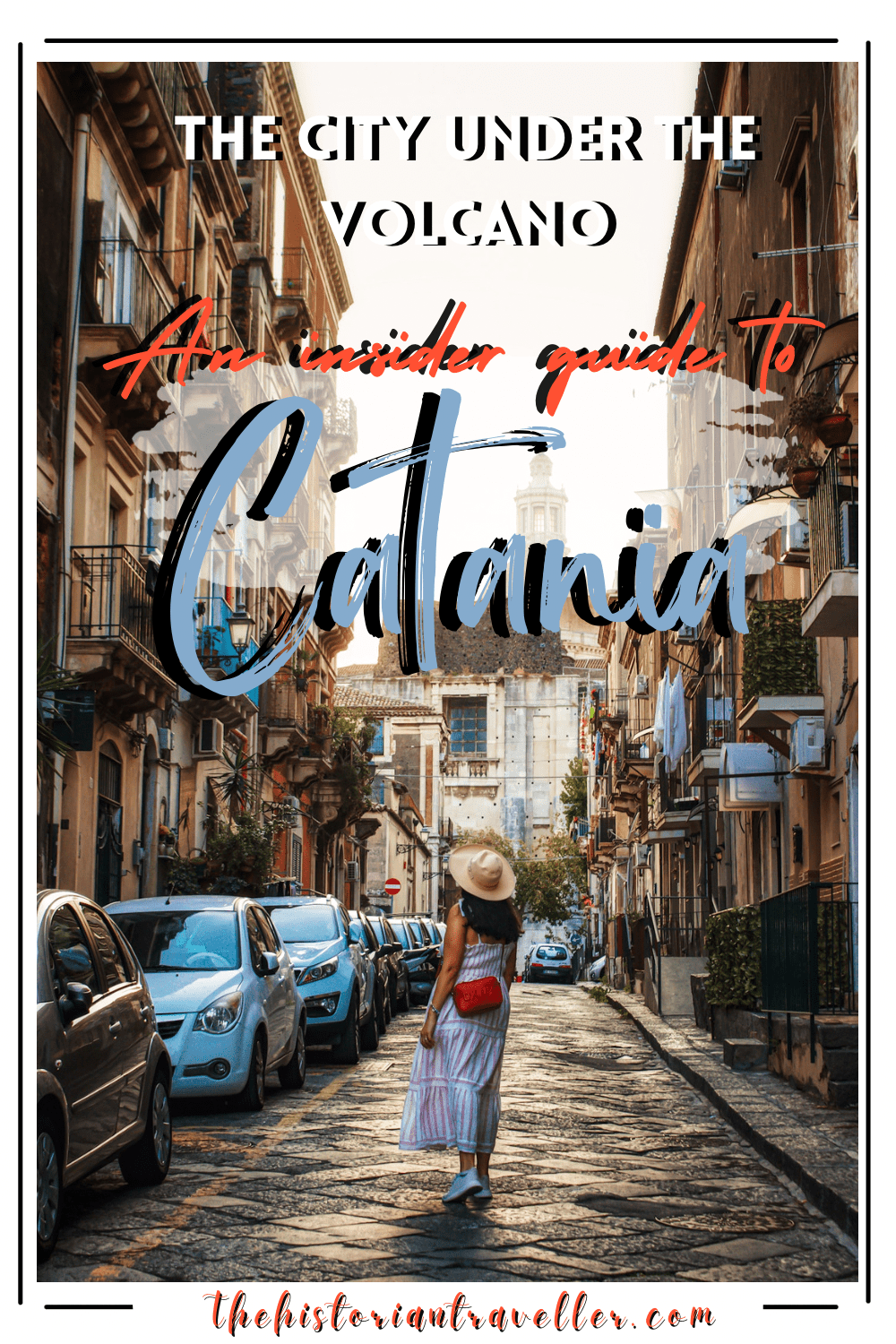
It feel strange writing this blog post. Indeed, every time someone asks me why I don’t write about my home town, I reply with a mix of smiles and excuses. The reality is that is painful to write about a place where I have spent most of my life, but in the end I decided to leave for good. It’s like reminiscing your ex despite now having a wonderful husband. However, I feel like none of the guides that are around make really justice to my city. Therefore, the time has come. I finally decided to share my pain and knowledge with you by writing an insider guide to Catania. After all, who’s better than me to get you around a city I lived for more than 20 years?
In this guide, you’ll find all my insider knowledge, my favourite secret spots and everything you don’t want to miss out make the most of your visit to Catania. So, let’s go!
Table of Contents
The girl who grew-up under a volcano
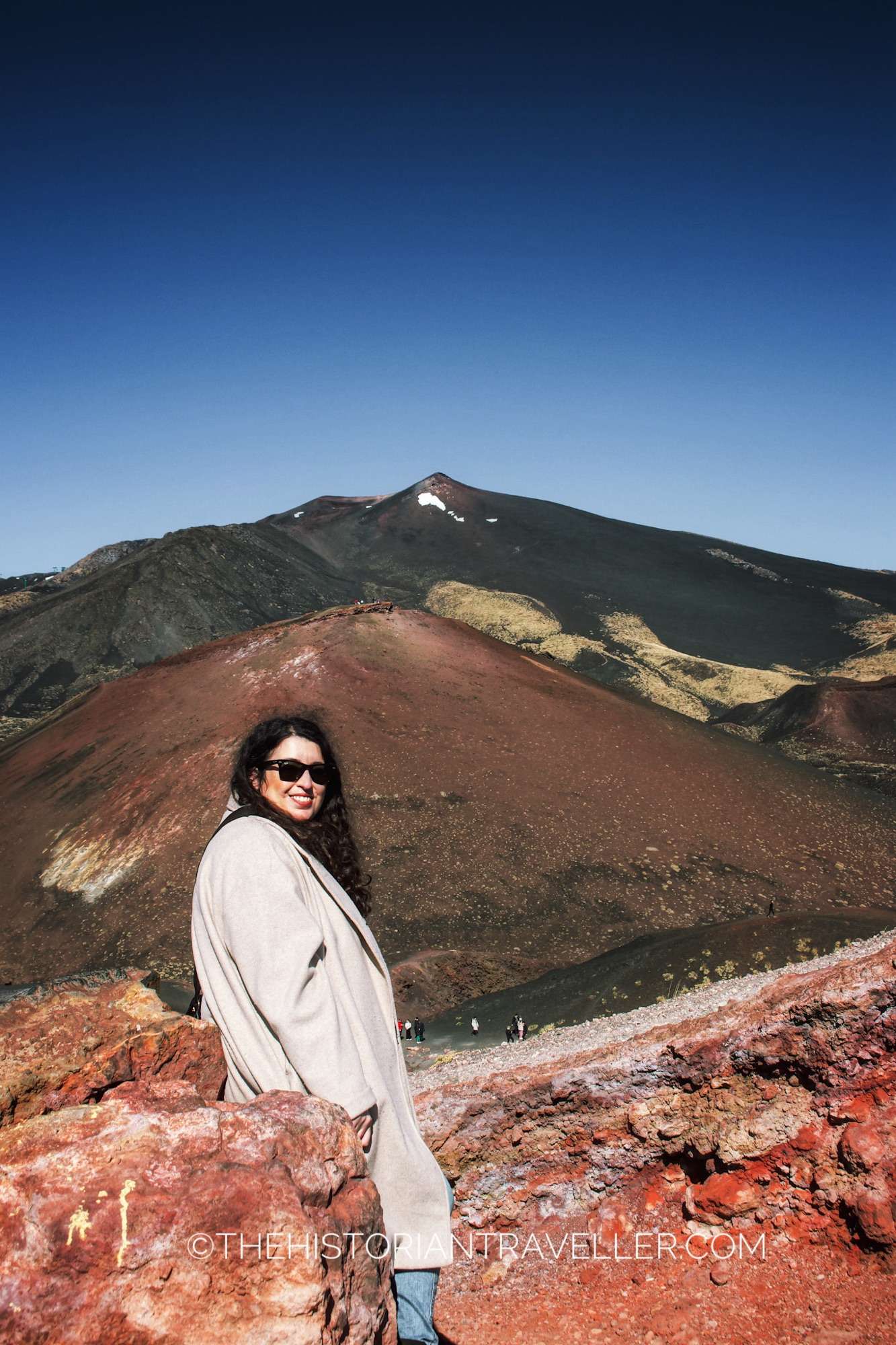
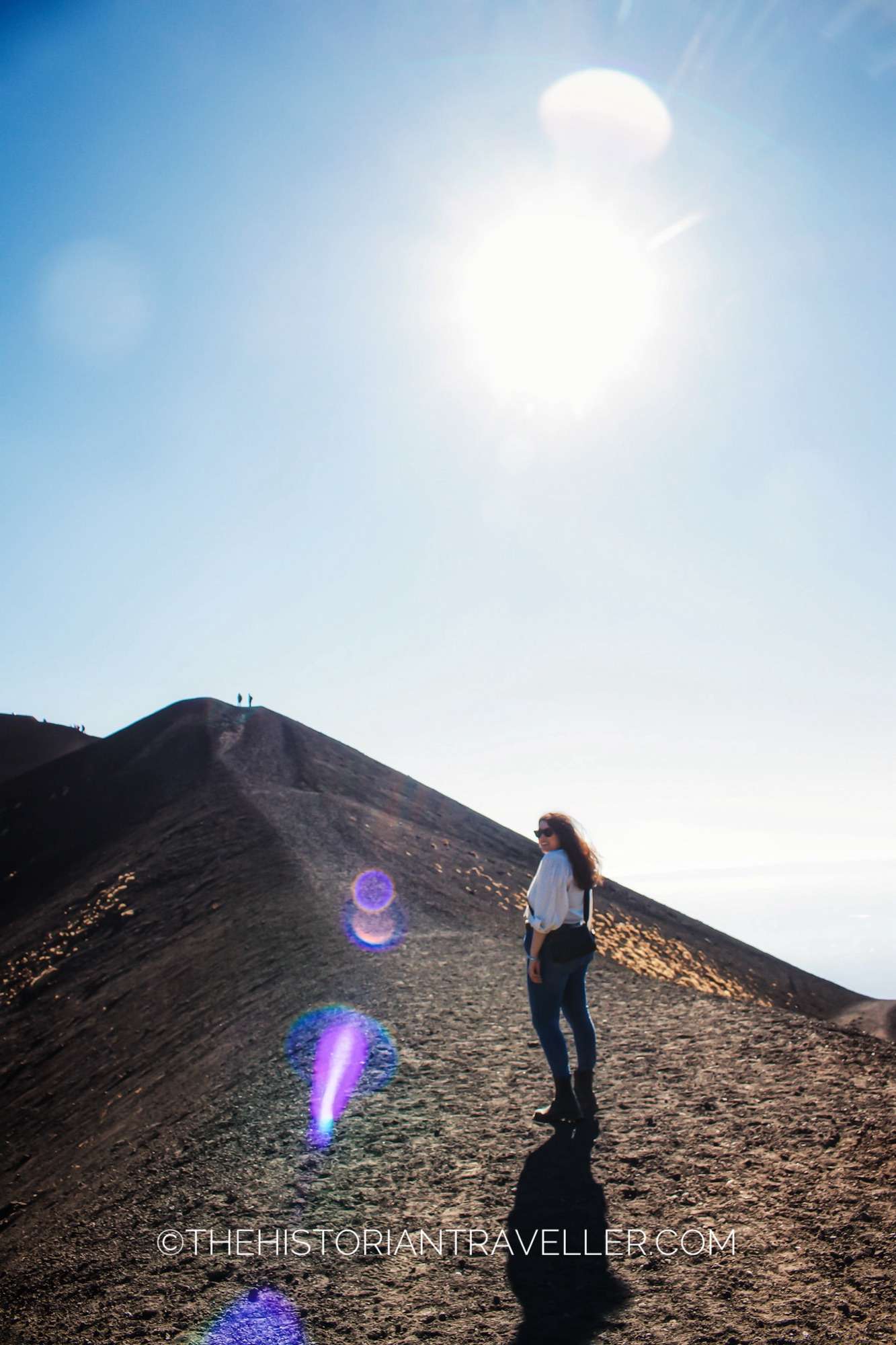
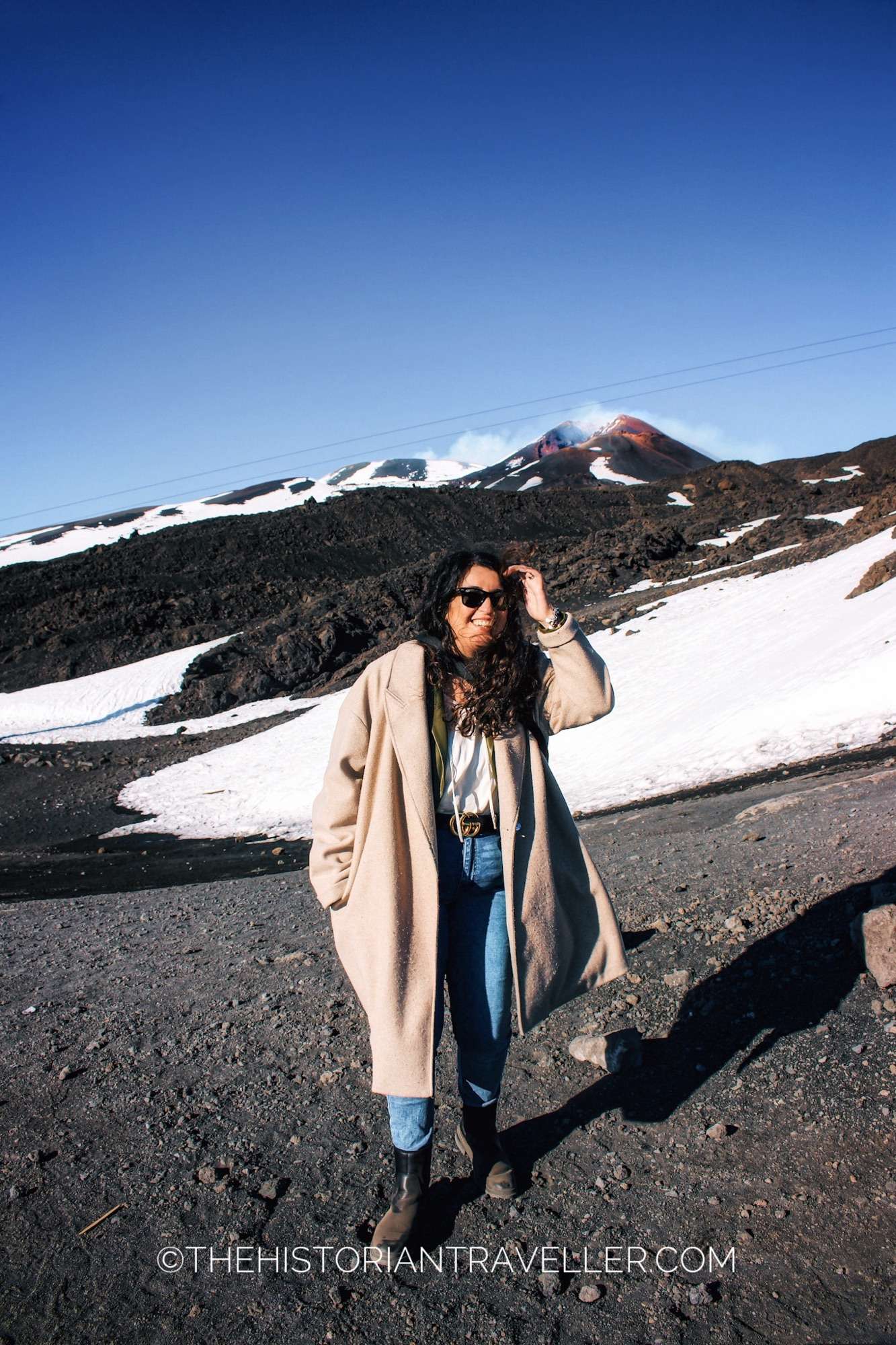
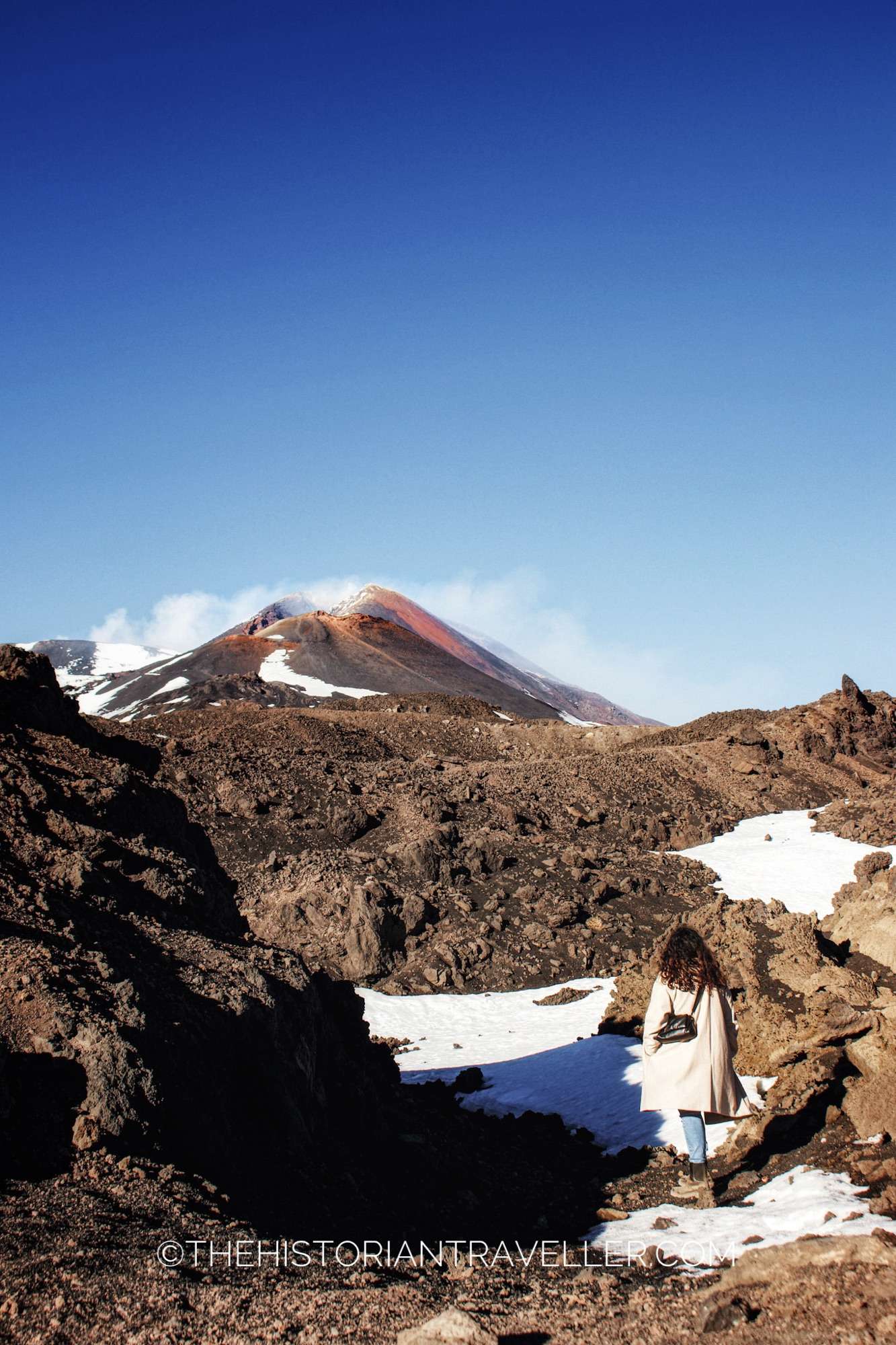
There is a distinctive trait that makes the people from Catania different from any other city you might visit in Italy (and probably in Europe too). We shared part or the whole of our lives with a volcano. Indeed, while for many reasonable people the words “active volcano” sound alarming, dangerous and probably a sign of an imminent catastrophe. To me (and those who grew up in the same city), they feel like home. Since I have memory, Mama Etna (aka the tallest active volcano in Europe) has always been part of my every day landscape. Whether she was silently sleeping under the sun, or explosively screaming fire up to the sky, I could see her from every window of my house greeting me every single morning. Almost as a reassuring presence in my life.
I grew up fearless and fierce and this was partially due to the fact that I always thought “if I could live near an explosive volcano, I could do everything else”. I still remember last summer in one of the numerous Etna’s eruptions my colleagues approaching me with very anxious thoughts for my family “living there”. It was funny to see their faces at my non-emotional reply “yeah this happens every other week, so don’t worry”. The truth is that I witnessed countless of Etna explosions in my life, but none of them has ever threatened the city’s inhabitants in a dangerous way. Understandably, tourists have a more cautious point of view but that’s the difference from someone who’s grew up under a volcano.
All the practical stuff about Catania
Where is Catania
Catania is located in the Eastern Coast of Sicily and it’s the second biggest city of the island. If you are interested in more destinations in the Eastern Coast of Sicily, you can check-out these 15 East Sicily Places to add to your itinerary!
How do I get to Catania?
Catania has a major airport hub (Vincenzo Bellini Airport – CTA). Depending from where you are travelling you can find direct flights or you might need to break your your trip to Rome, Milan or some other cities in Italy.
If you are travelling from the UK, most direct flights are operated by Easyjet from London Gatwick, Manchester or Bristol. British Airways considers Catania exclusively as a summer destination and their direct flights are available only between June and September.
If you are travelling from overseas (US/Asia) the best thing is to stopover in Rome or Milan and get a cheaper connection.
How expensive is to travel to Catania?
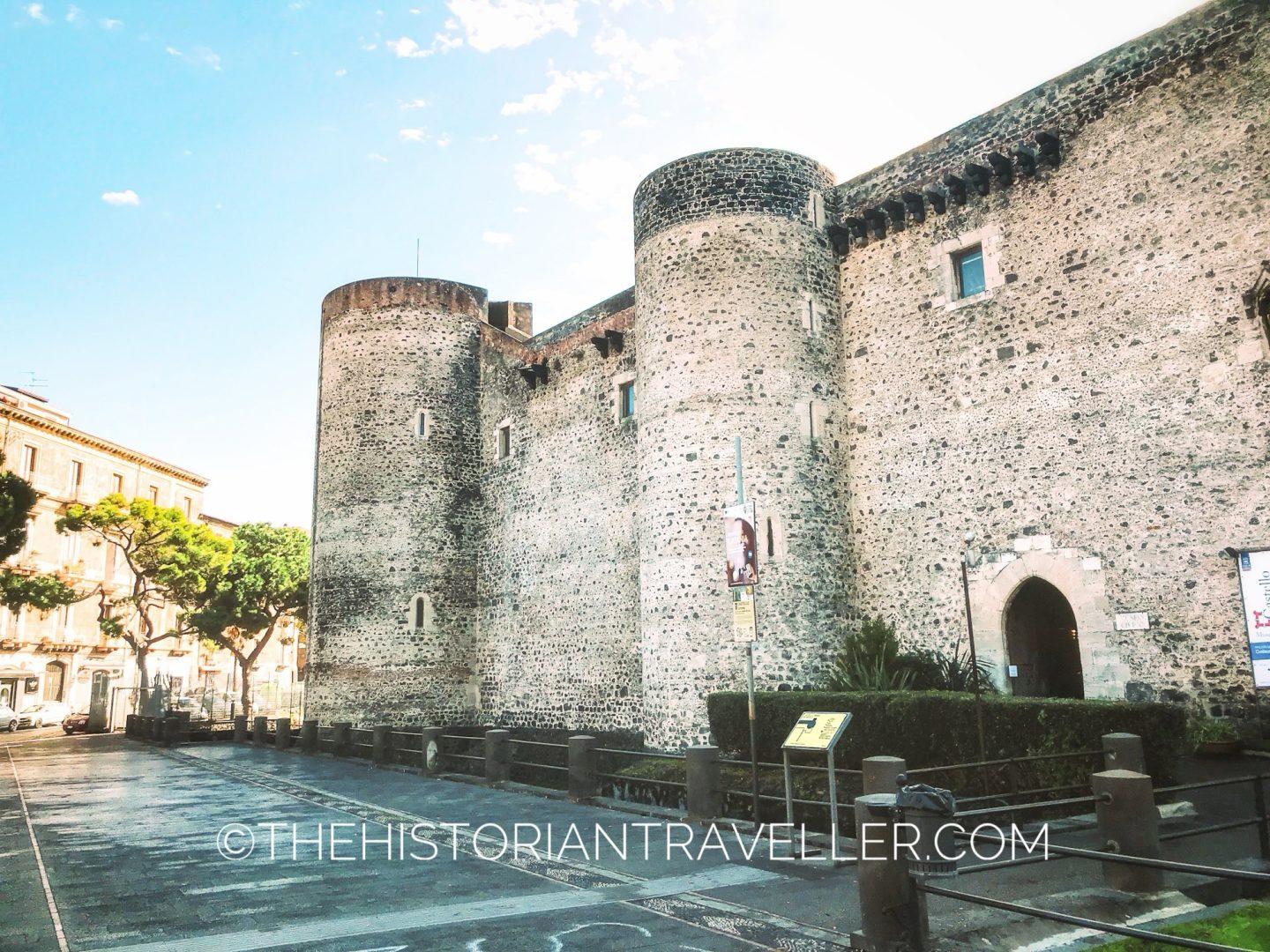
A very bad reality I discovered as an expat to the UK, is that traveling to Catania is $$$. Particularly during the summer season. In fact, Sicily is universally known as a summer vacation spot (I dissent for obvious reasons). This impacts the prices of the flights in a very expensive way. Unfortunately, to the expenses of those who are just flying to visit their families. I am telling you this, because if you are planning to travel to Sicily, particularly to Catania, over the following periods: Christmas, Easter, any bank holiday and Summer. You have to book your flights at least 6 to 5 months in advance to find a decent price. There are some rare exceptions but don’t count on those.
Indeed, last summer I used well over 20,000 Avios and ended up paying about £800 just for a 2h 45 mins flight with BA from London. My flight to India costed less!
Yes, it’s sounds ridiculous, but trust one that has probably spent about 20K in flights in the past 10 years only to visit her family. BOOK THOSE FLIGHTS EARLY!
The cheapest flights are usually via Ryanair or Easyjet. Nevertheless, if you are travelling with hold luggage BA might be of a better value (especially if you can use Avios). It also allows free luggage for kids, when Easyjet is almost charging even the air you breath on the plane.
How expensive is Catania
Catania can be inexpensive or mid-range depending on your point of view and budget. In fact, because my life and spending is set on London standard of life, every time I go back to my own town everything looks super cheap to my eyes. “€5 Aperol Spritz?? Yes!!! give me 5 please!”. Nevertheless, if I talk to my parents or any person who regularly live there, they might have a different perspective. In fact, if a 10€ a Margherita pizza to me looks inexpensive (compared to what I pay in London) to some of my friends this is one of the highest prices you can pay.
I would say that Catania is generally inexpensive compared to other Italian cities like Venice or Milan. I can have a decent meal for €10 and street food with €1-2. Parking is cheap and if I pay €50/60 for a night out (e.g. cinema + cocktails and restaurant) I am really splurging. Of course, there are some upper scale restaurants too but generally I never spend the amount of money I spend for a night/day out in London.
Accommodation prices range vary according to the typology of places one wants to stay. Luxury hotels have higher rates in line with other locations in Italy and during summer prices tend to go up even for mid-range and budget accommodations.
How to get around Catania
When packing, please bring a lot of patience with you because you’ll need this to get around the city. Indeed, to my eyes Catania is quite an hybrid between Naples and Mumbai. It’s incredibly chaotic, no clear rules when driving, public transportation almost non existent and taxis, well if you see one give me a shout. If you stick to the city centre, you can probably get most of the places you want to see with just a good pair of sneakers. Nevertheless, if you are planning to rent a car. Good luck and thank you for all the fish!
I don’t want to be melodramatic, but after inviting a lot of British friends to my wedding years ago and having seen the fear of dying in their eyes at the first two roundabouts, I stopped recommending to rent a car to any non-Sicilian. But of course you might need it, at your risk and danger.
BUT let’s gets you some serious information.
Car Rental
If you are just staying in the city centre. I wouldn’t recommend getting a car. In fact, most attractions are close to each other and part of the city centre is car-free, so you’ll need to park it in some side roads (with the danger of the car disappearing magically. For this see below).
If you are planning a big road trip and need a car, be sure to get it from an authorised car rental at the airport like Avis or Europecar. Don’t be tempted to get your car from the first Arancino.rental.com. Otherwise, you might get scammed with old cars and tourist increased fares.
Where I should park my car in Catania?
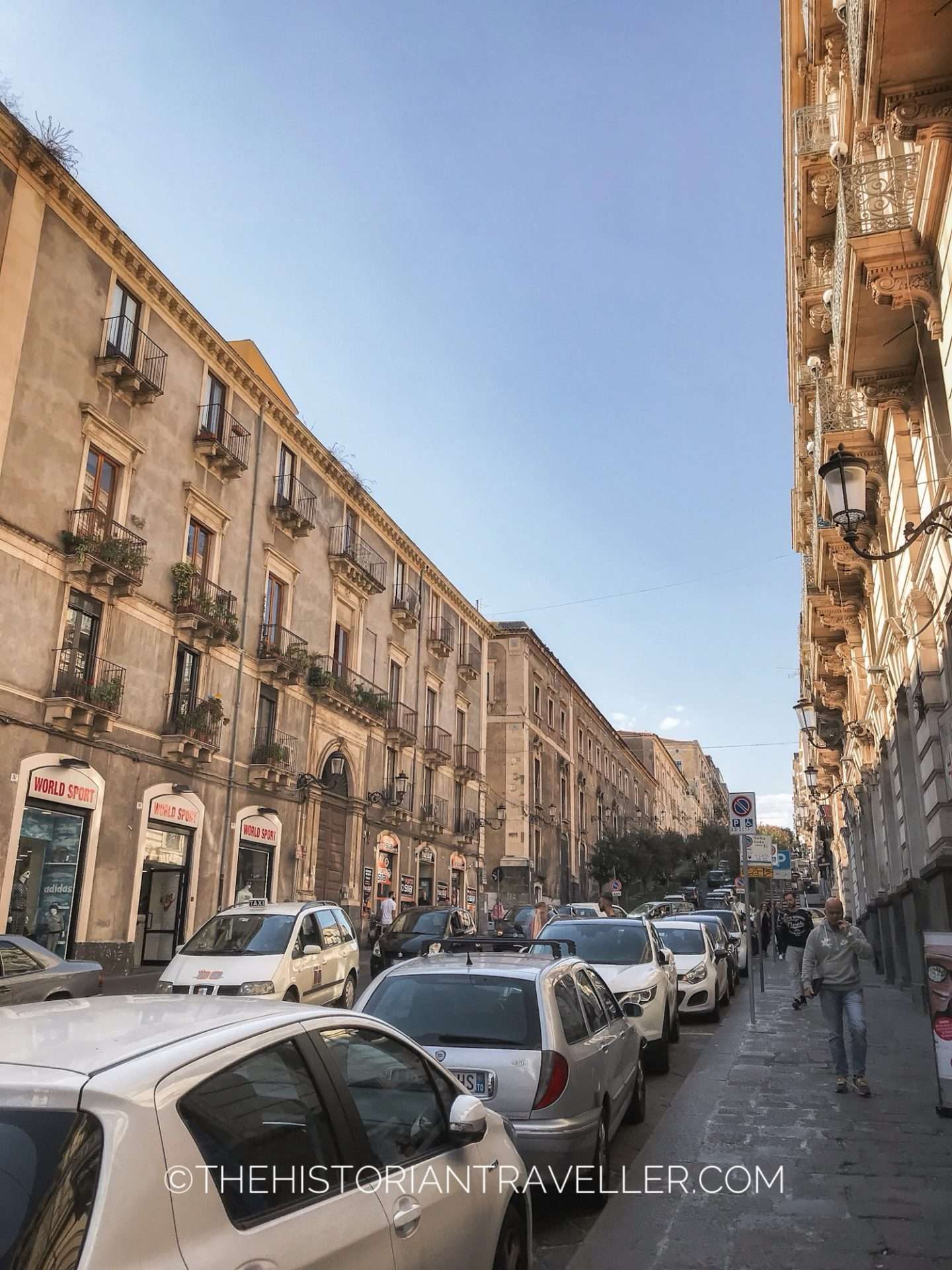
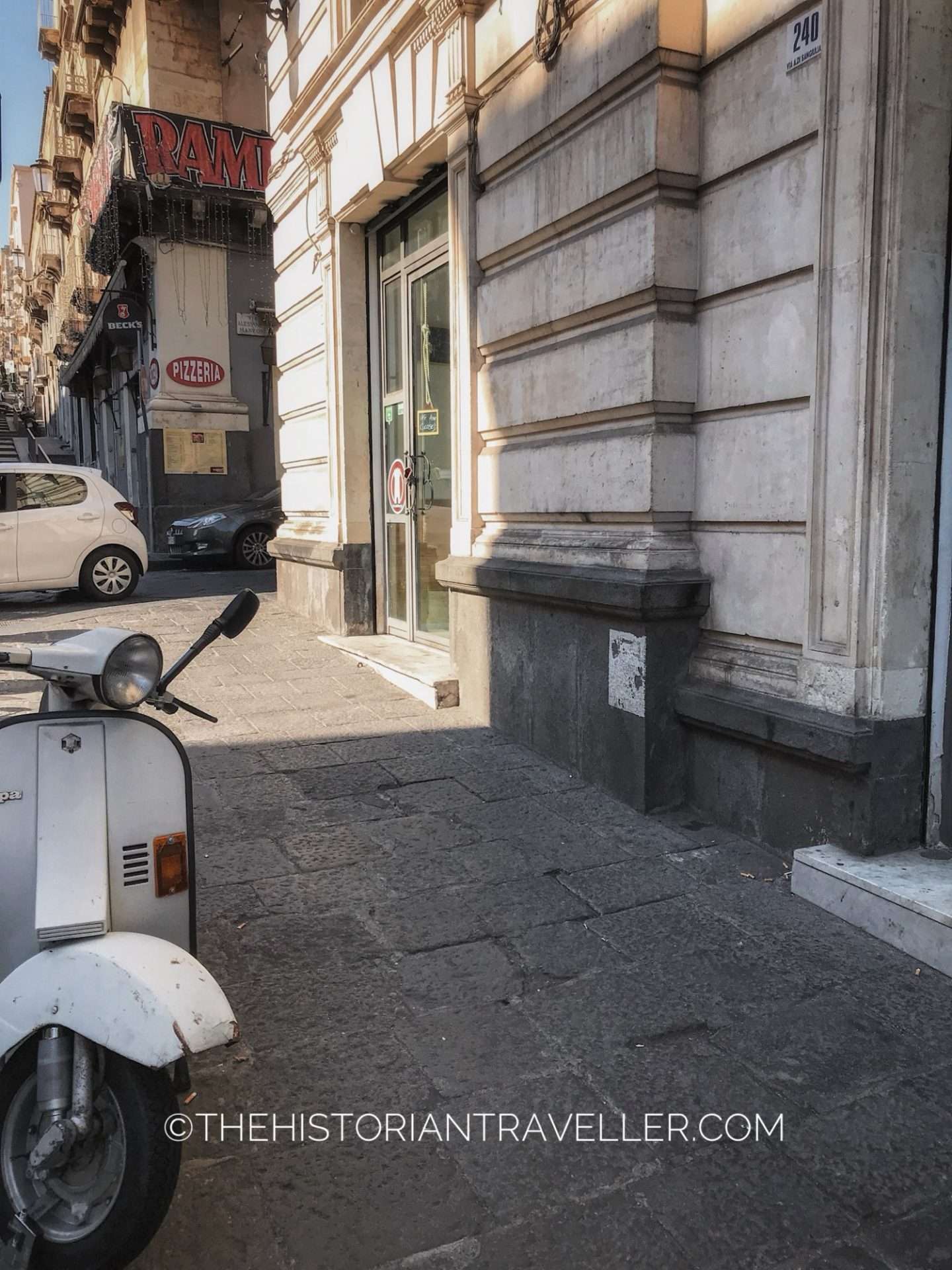
When renting your car, start thinking where you have to park it. In fact, parking in Catania is quite challenging for mainly two reasons. First, there is not enough parking space everywhere you go. So, don’t be surprised when you’ll see car parked even in the middle of the road without nobody apparently caring about. Second, there are the famous posteggiatori abusivi. Alias unauthorised scammers popping out of nowhere at any parking space and asking you money to “watch your car and keeping it safe”. Safe from who? From themselves of course. Indeed, if you don’t give them money, the car (or pieces of it) might disappear or get damaged at the expenses of your rental insurance premium.
Some areas are now patrolled by police and recently I’ve seen less posteggiatori around. Nevertheless, they didn’t disappeared completely. Therefore, you might bump in one or two of them while trying to park. The good news is that if you are really desperate to park and can’t find any space without a scammer, you can keep them at bay with 1 or 2 € coins (don’t dare to pay more than that). Of course, don’t expect they are really keeping your car safe.
Parcheggi a Pagamento
Other possibilities of a more “legal way” to park, particularly in the city centre, are the Parcheggi a pagamento. Designated garages/spaces where a not-very-friendly man sitting on a white chair surveil at the entrance apparently watching the street all day. You will recognise these spaces for their red hand-painted sign saying exactly “Parcheggio a pagamento”.
The second possibility is the Strisce Blu. Translated literally as “Blue stripes” these are painted on the ground and it means you can park there and pre-pay a hourly fee from a machine that is usually close by. Be careful because sometimes they are patrolled by the posteggiatori who try to catch unaware visitors and make them pay double.
Parking during the day
If you need to leave your car during the day. A good spot to park is Via Giovanni di Prima. I usually leave my car there if I have to go to the city centre in the morning. Here there are Strisce Blu to pay but it’s a pretty safe area and at a walkable distance from the central square Piazza Stesicoro (7 mins walk).
Parking during the night
If you have to leave the car for the night. I recommend opting for a safer option like the Parking Catania Center. I don’t recommend this for the morning because it’s located in the middle of the city market, Fera o’ Luni, that is quite hard to drive giving the crowds and stalls. In this regard, if you park here get your car out before 8.30 or you can remain stuck in the market forefer.
Public Transport
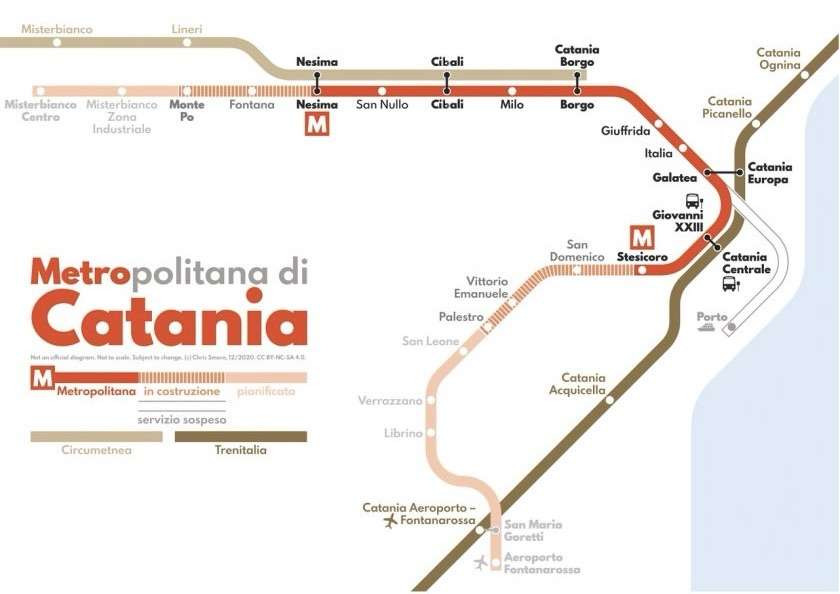
There are two ways to move around Catania. By bus (AMT) or via the recently opened Metro. Shamefully for me, I never used the Metro YET. Simply because it doesn’t connect any relevant areas I generally visit when I happen to be in Catania. However, you might need to use it depending on where you go. This is this a mega work-in-progress and you’ll see that if you stay only in the city centre, you’ll likely don’t use it at all. However, just in case the photo above shows the current open lines.
Buses (AMT) connect various part of the city. However, I strongly recommend to avoid them unless it’s an emergency, or you really need to take them. In fact, they are really (I mean REALLY) slow, always extremely full of people and pickpockets. They don’t have A/C so they are boiling traps in the summer and freezers in the winter. Honestly, the last time I tried to take a bus in Catania was something like 12 years ago. Tried to move from A to B (a place at less than 20 mins by car) took half a day. Not very recommended.
When is the best period to visit Catania?
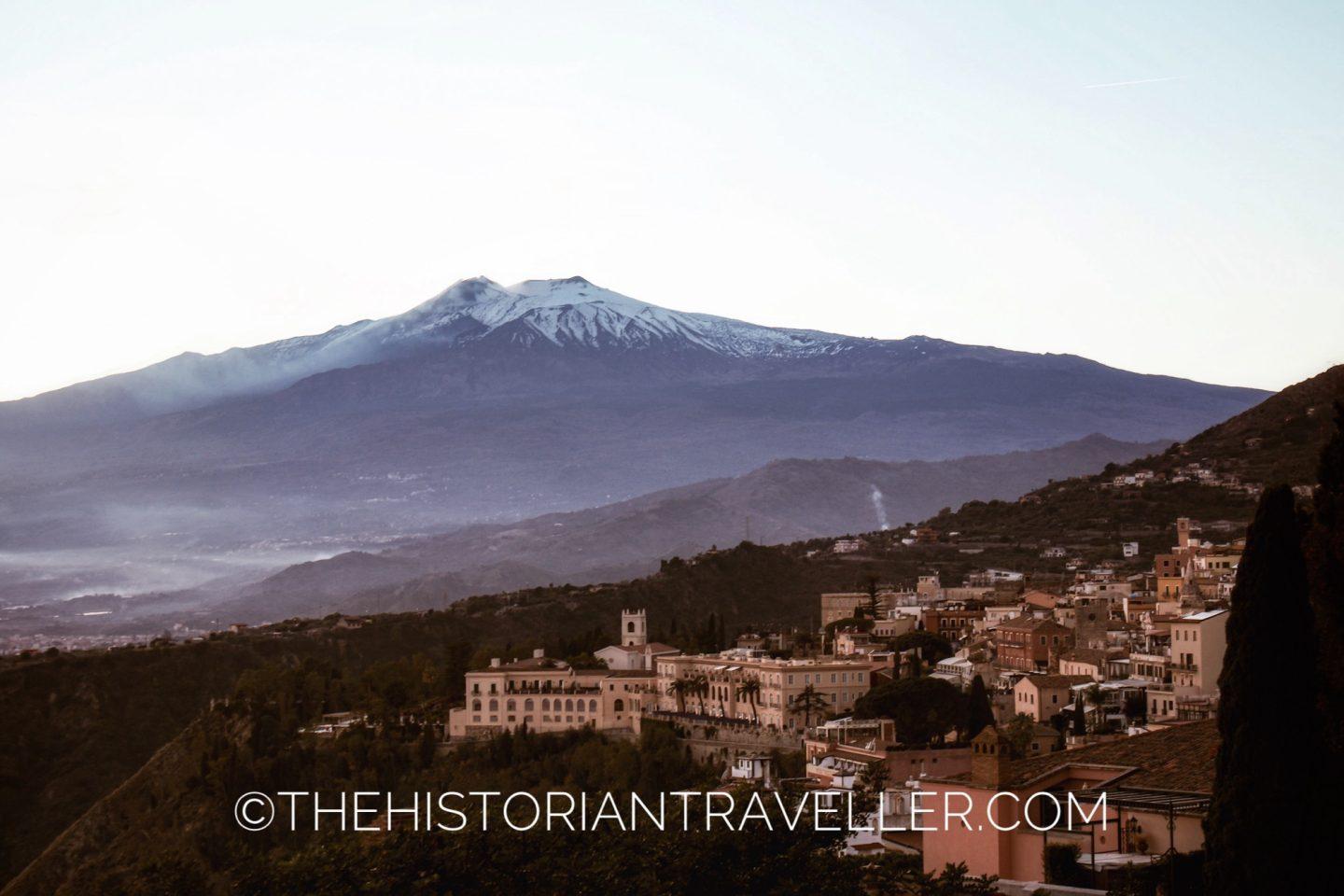
Sicily temperatures are pleasantly warm all year around. Nevertheless, summers tend to be extremely hot. With this I mean that temperatures range between 35-43 degrees celsius in the city. Therefore, despite its proximity to the sea, visiting Catania during June-August can be a little challenging. My favourite months to get around are March to May and late September until mid November. Temperatures are mild (20-25 degrees celsius) and you can stay a lot outside without melting.
Winters are not too rigid in Catania. The last two times I visited in December temperatures were between 18 and 20 degrees with plenty of sunshine. However, climate conditions can change easily and sudden. Violent storms might happen from time to time and recently many cities were even flooded. January and February tend to be the worst months with colder temperature and unstable weather.
How many days do I need in Catania?
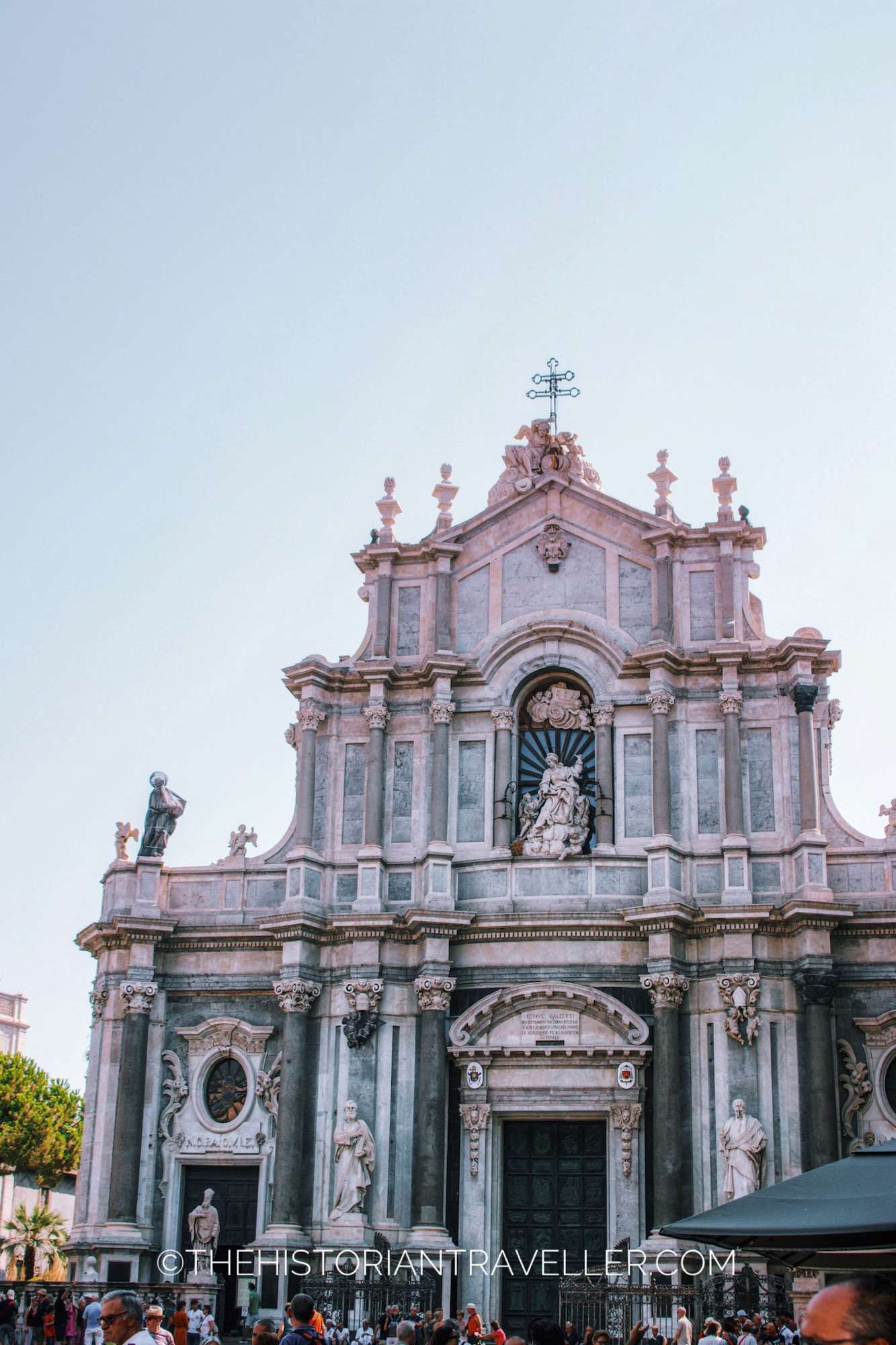
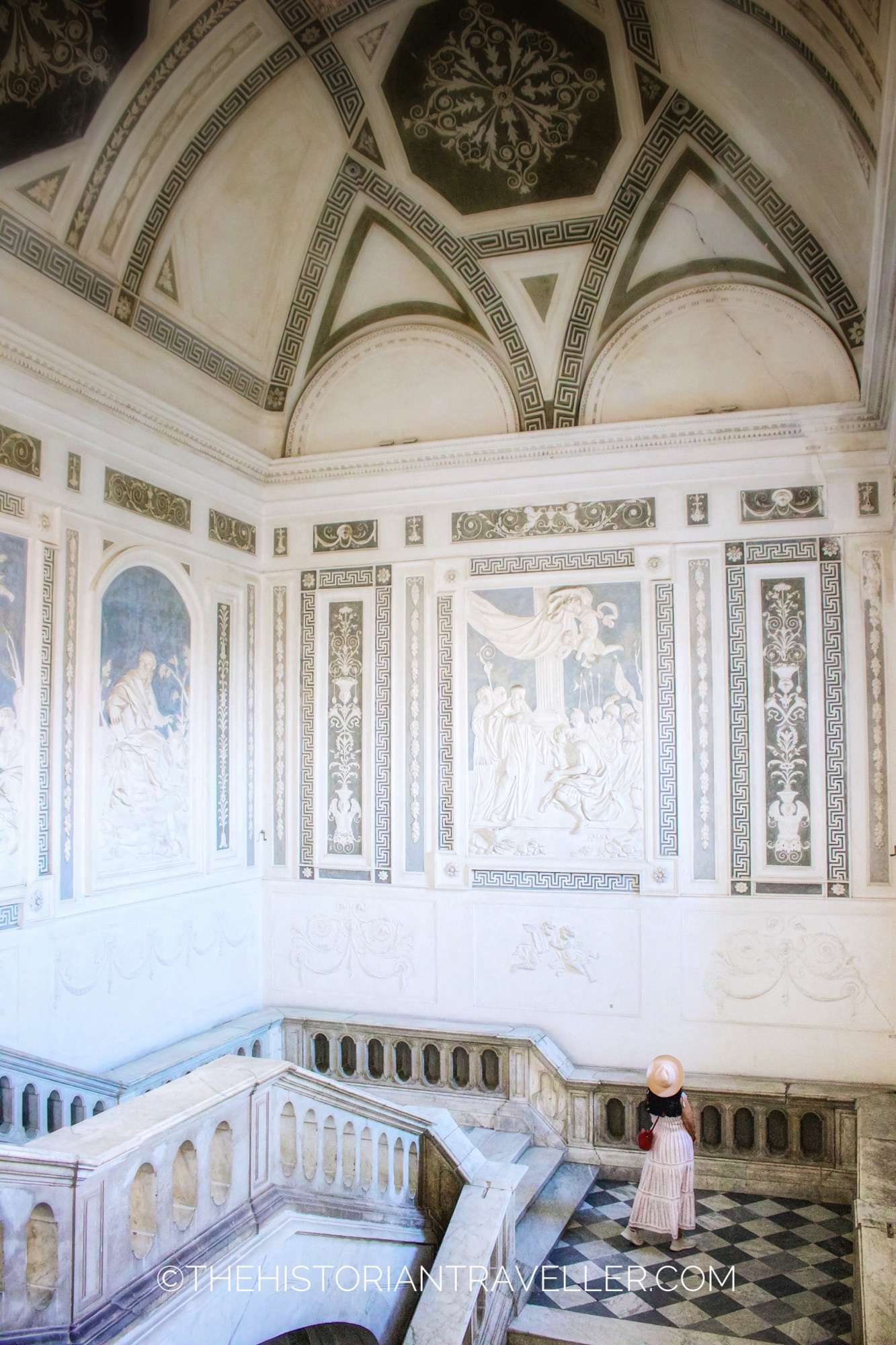

Many people visit Catania in one day. However, there is a lot to see so I recommend 2 to 3 days to gain a proper experience and feeling of the city and its surrounding.
Is Catania dangerous?
I believe that all the cities carry a certain level of danger if you happen to be in the wrong neighbourhood. As many other big cities, also Catania has its dark side. The city centre is mostly safe but be wary of pick-pockets and baby gangs who are not pleasant to deal with. Particularly at night. As person who grew up in Catania, I know there are places that are better not to go at night or at any time of the day if I don’t want to get in trouble. I will share these with you in a moment.
Be particularly wary of the areas where you rent your accommodation. Particularly if using Airbnb. The city is huge and you might see a nice place, but this can turn out to be super far and no well-connected or, worst, in a No-go zone.
No-go zones in Catania for tourists
I would like to specify that these no-go zones are not a life-risk areas. So, you can transit to them easily and most of the times with no problem at all. However, they have a bad reputation as being high-criminality areas with sometimes drug and weapons related problems. Moreover, from a tourist perspective, these areas are not interesting as mostly residential and far from any historical attraction. Nevertheless, with the rise of self-accommodations and short term rentals, tourists are sometimes lured in these areas unknowingly. So, if you see that your accommodation place is in one of the below neighbourhood stay away for your sake. That’s a red flag. If you are still determined to go, at least you know you need to be extra careful!
No-go zones for accommodations and tourism in Catania
These areas are all known for small criminality, drug related crimes, weapons traffic and baby gangs. Avoid them at any cost.
- San Cristoforo
- San Berillo
- Librino
- San Giorgio
- Picanello
- Pigno
- San Leone
- Villaggio Sant’ Agata
- Zia Lisa
- Cibali
- Acquicella
Areas that need a certain level of attention, particularly at night in Catania
The below areas are ok to go and stay, but they need an extra level of caution very early in the morning or at night. Particularly for solo female travellers. In fact, they are often isolated at night and with scarce illumination. Moreover, they are surrounded by a large number of small dark alleys and you don’t want to get lost there at night.
- Piazza Teatro Massimo and surroundings. Ok during the weekend late nights (as full of restaurants) but be extra careful in the small alleys
- Central Station area
- Via Plebiscito
- Via Teatro Greco/Monastero dei Benedettini and surrounding areas (very good to walk in the day, but at night very isolated and dark).
- Castello Ursino (no-go at late night, particularly near the Pozzo of Gammazzita).
- Via Garibaldi (also don’t venture in any of the side roads at night)
- Villa Bellini Garden. Ok to walk during the weekends night but would stay in the garden main avenue and not venture in the darker parts.
- Via delle Finanze. Ok to walk through the day but I wouldn’t stay there at night or alone.
3 essential things to know before visiting Catania
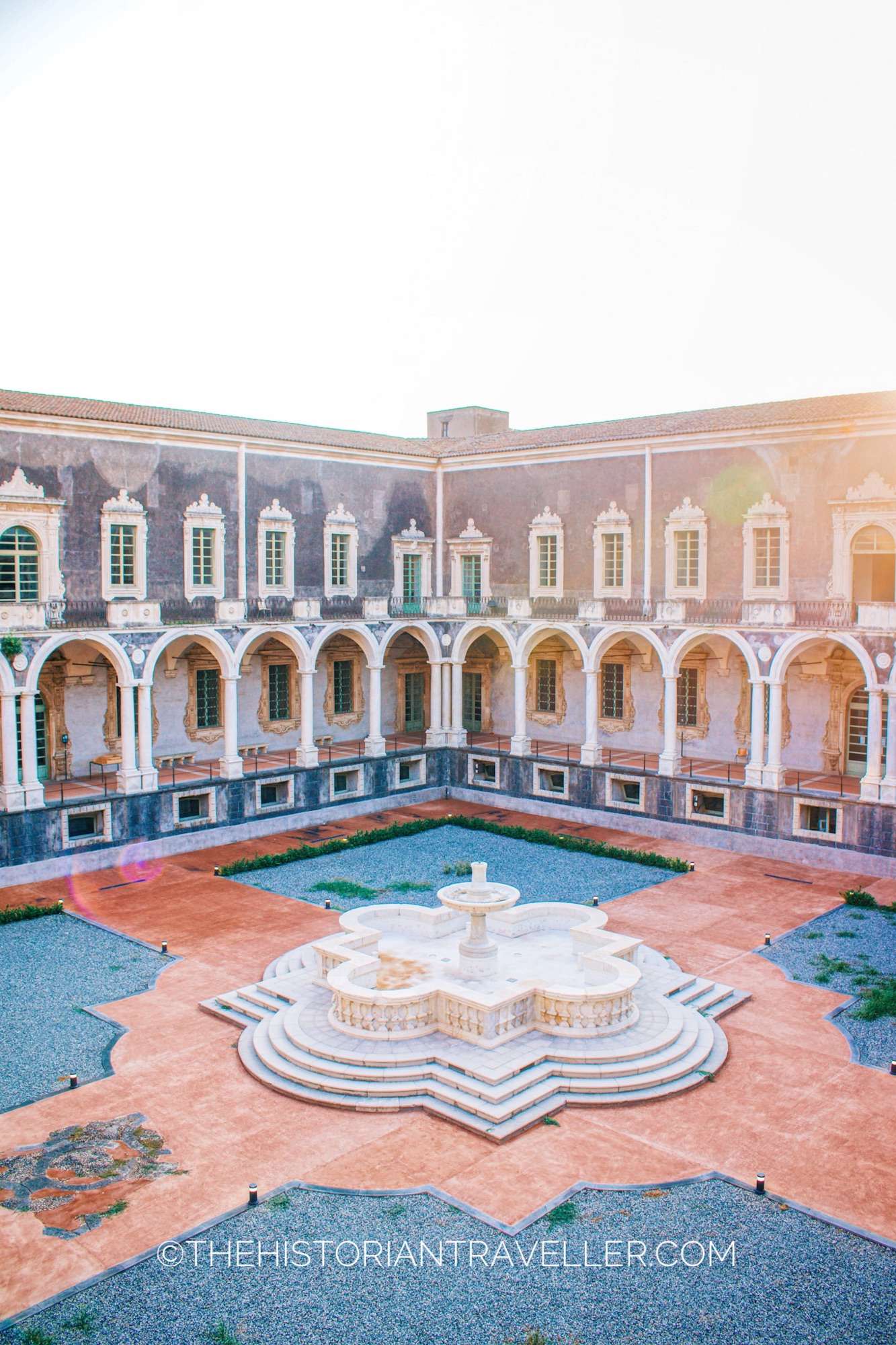
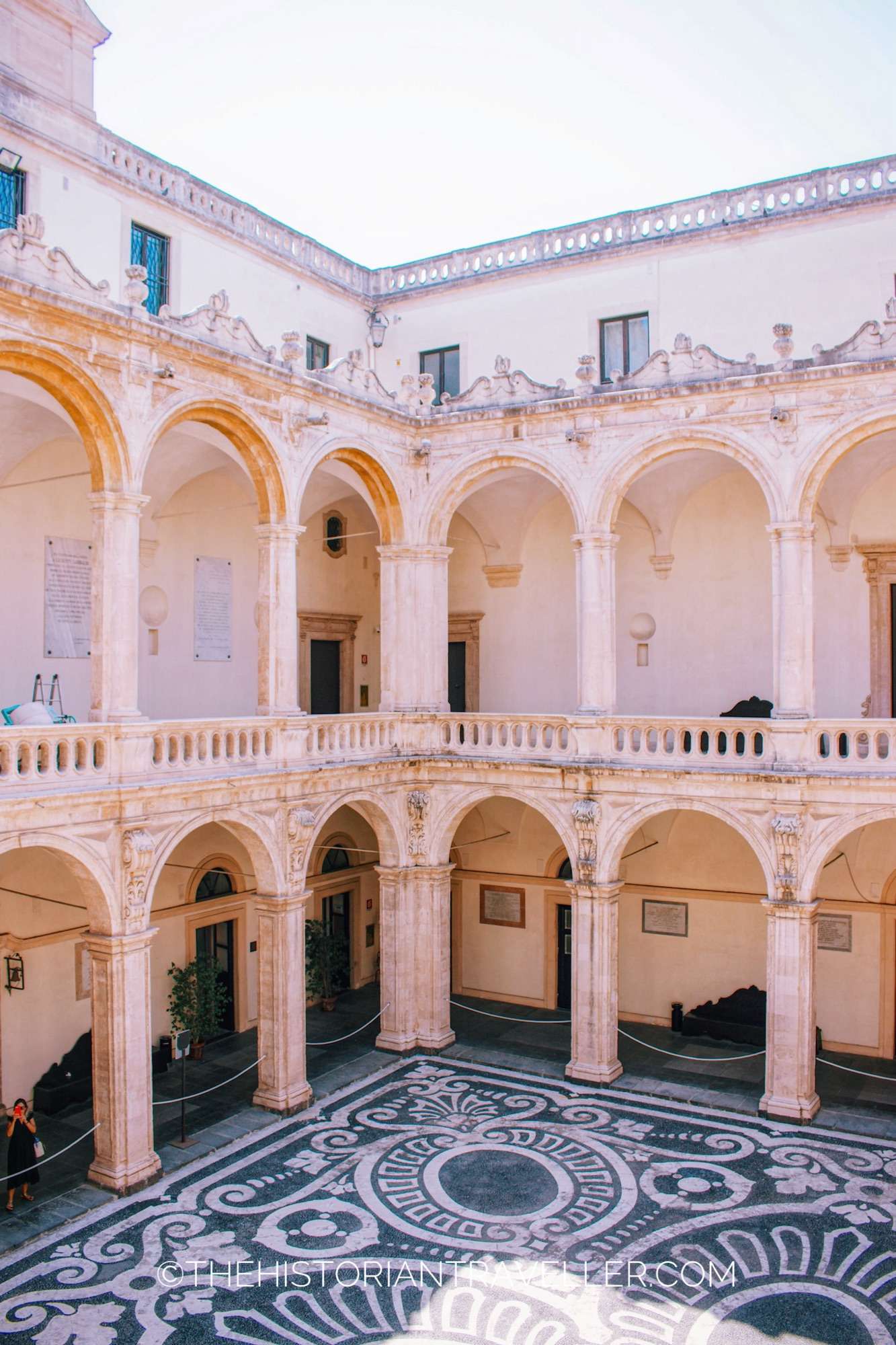
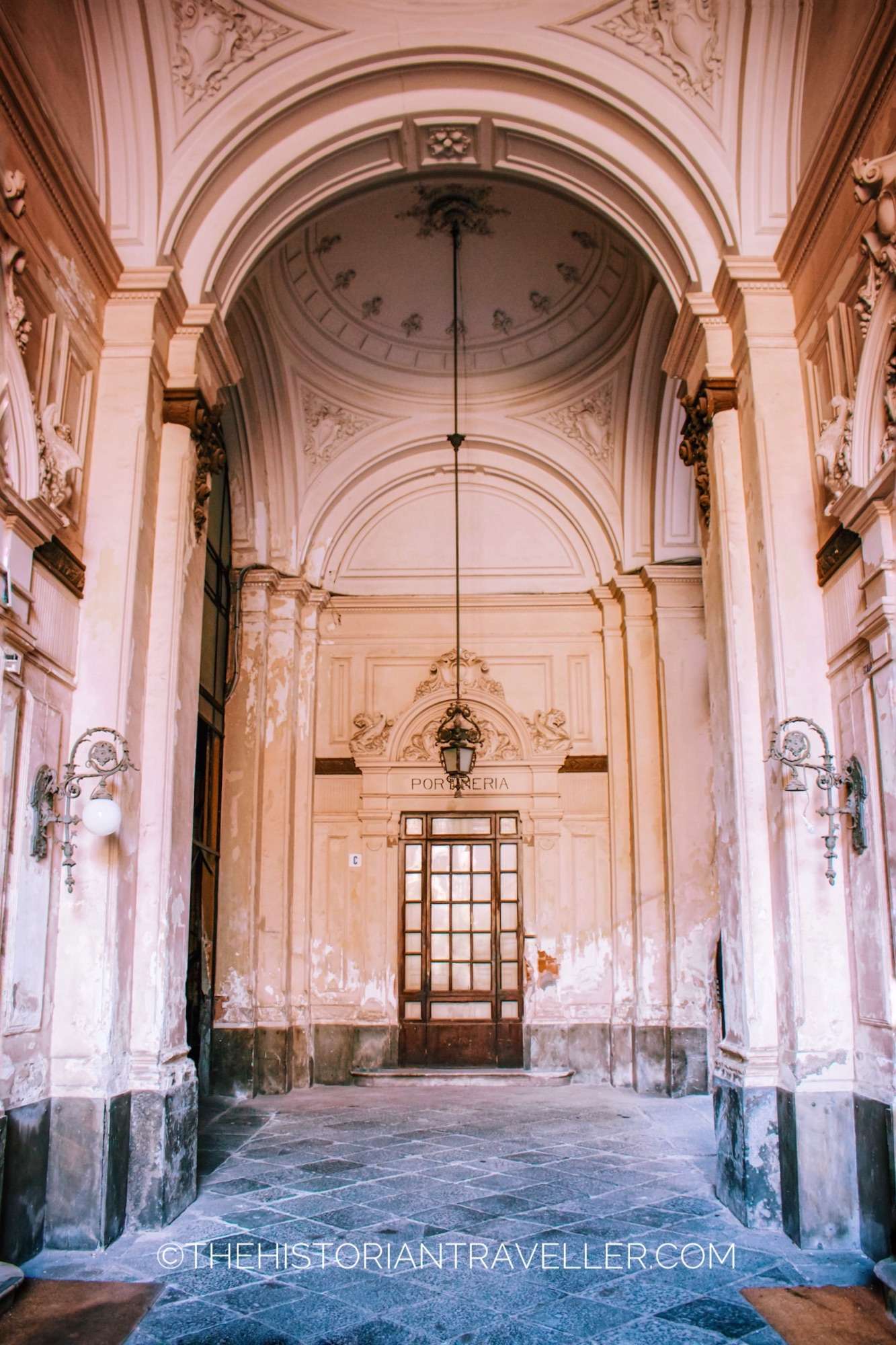
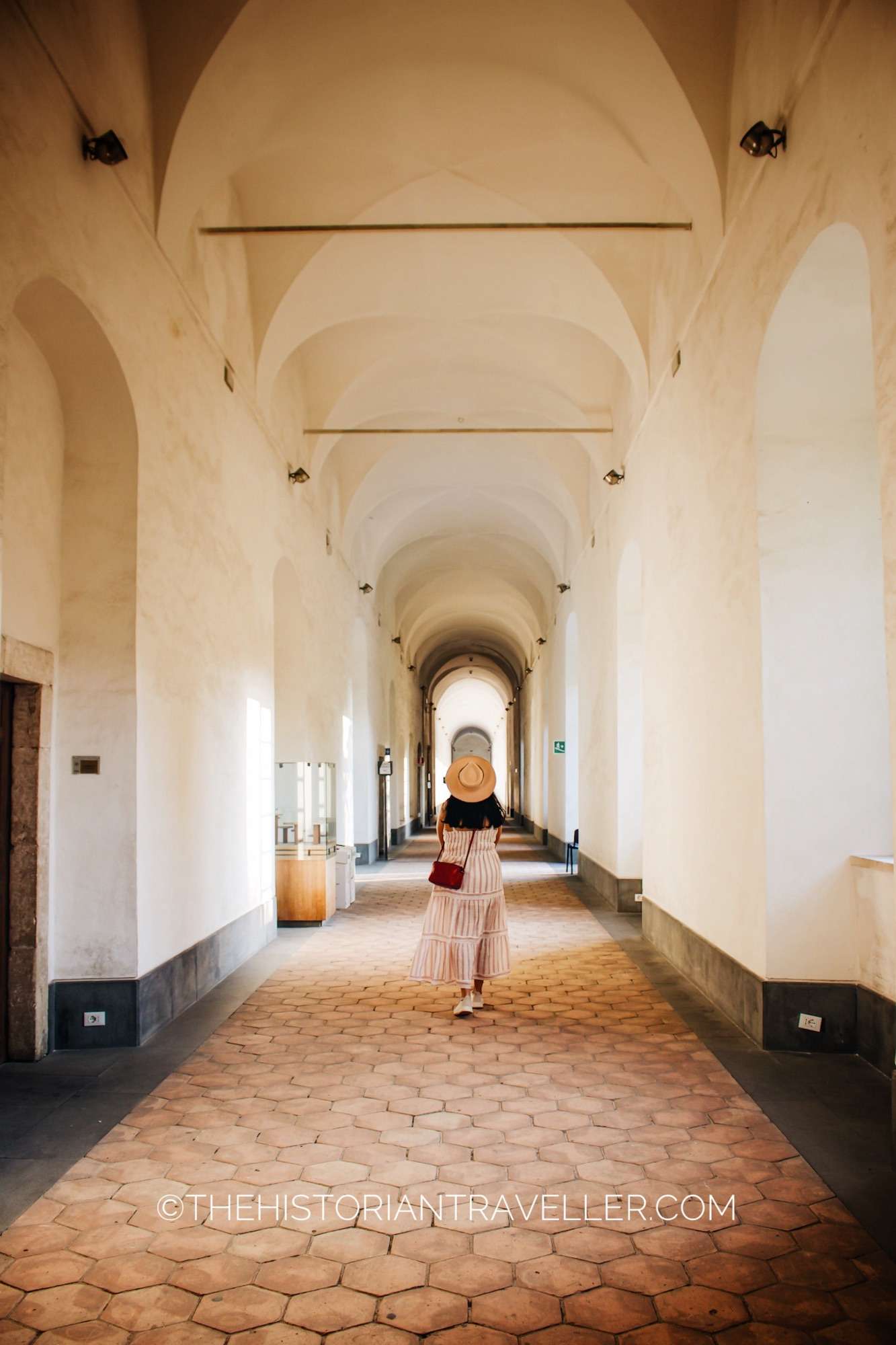
I hope I didn’t scare you too much with the information above. I always prefer my readers to face the reality rather than sugarcoating a destination and then have a bad experience on arrival! Catania is a wonderful city to explore and knowing some of its problematic areas in advance will help you to plan properly (and safely) a fantastic holiday. Here below, there are also 3 main things you need to know before visiting the city that will help you understanding a little bit the location and its background.
1. It’s a city built over a city
Catania is full of underground secret passages. There is basically a city under the city. This because Catania has been buried by the Etna’s magma at least 7 times and the current city has been built over the previous version of it! This means that any historical building you will visit has likely an access to some kind of underground area. The city has also an underground river that flows free under the city centre! This is called Amenano river and you can see part of it in Piazza Duomo near the fountain that carry his name. Some partially visited subterranean heritage locations are the Terme Achilliane in Piazza Duomo, the Church of St. Gaetano alle Grotte, the Terme Romane and Villa Cirami.
2. The obsession for Saint Agata is real
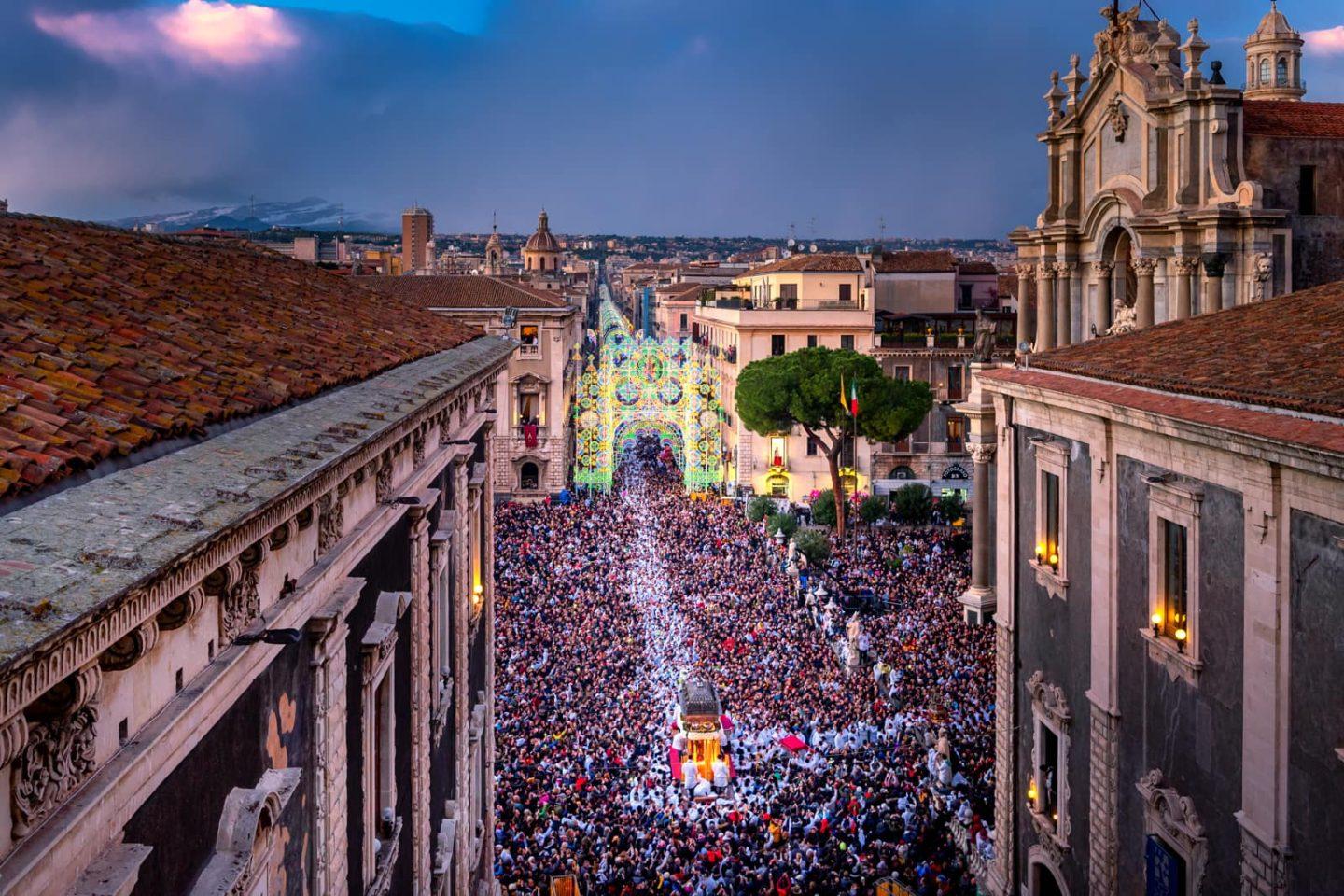
(Most) People from Catania have a real obsession for the Saint Patron of the city. A Santuzza, St. Agata. This obsession is reflected in many neighbourhoods named after the saint and a quite large number of churches and historical attraction where the saint allegedly passed through, has been jailed or made some kind of miracle. The obsession is REAL. If you happen to visit Catania between the 3rd and 5th of February you’ll see the madness of the devoti in action. It’s a once in a lifetime experience to witness and I have some of my nicest childhood memories of the feast spent with my parents. Indeed, this is an official holiday for the city. Therefore, parents takes all the children around the city to see the candelore (heavy carved floats carried around the city centre), buy cotton candy and helios balloons while they pay their homages to the Saint.
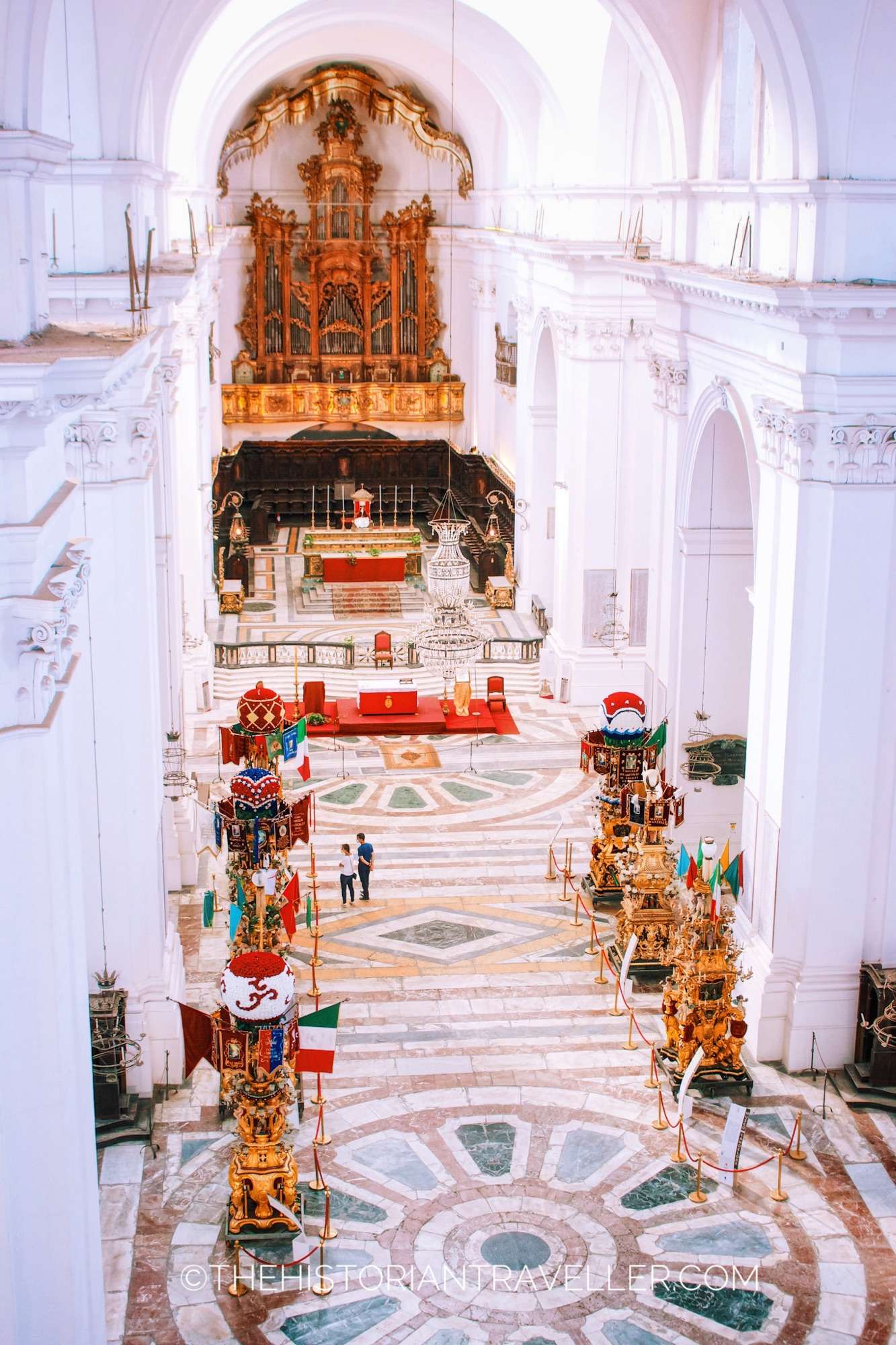
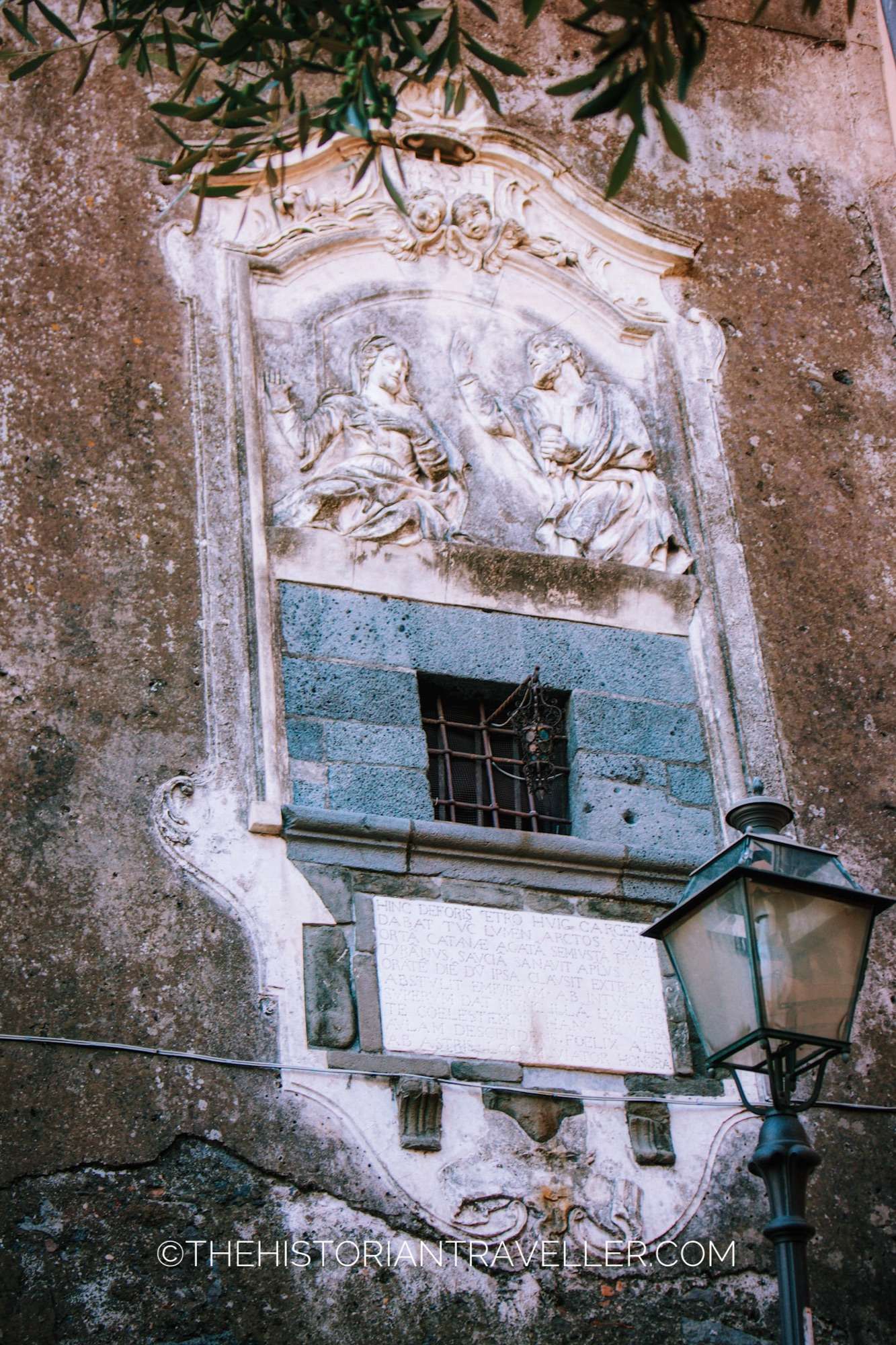
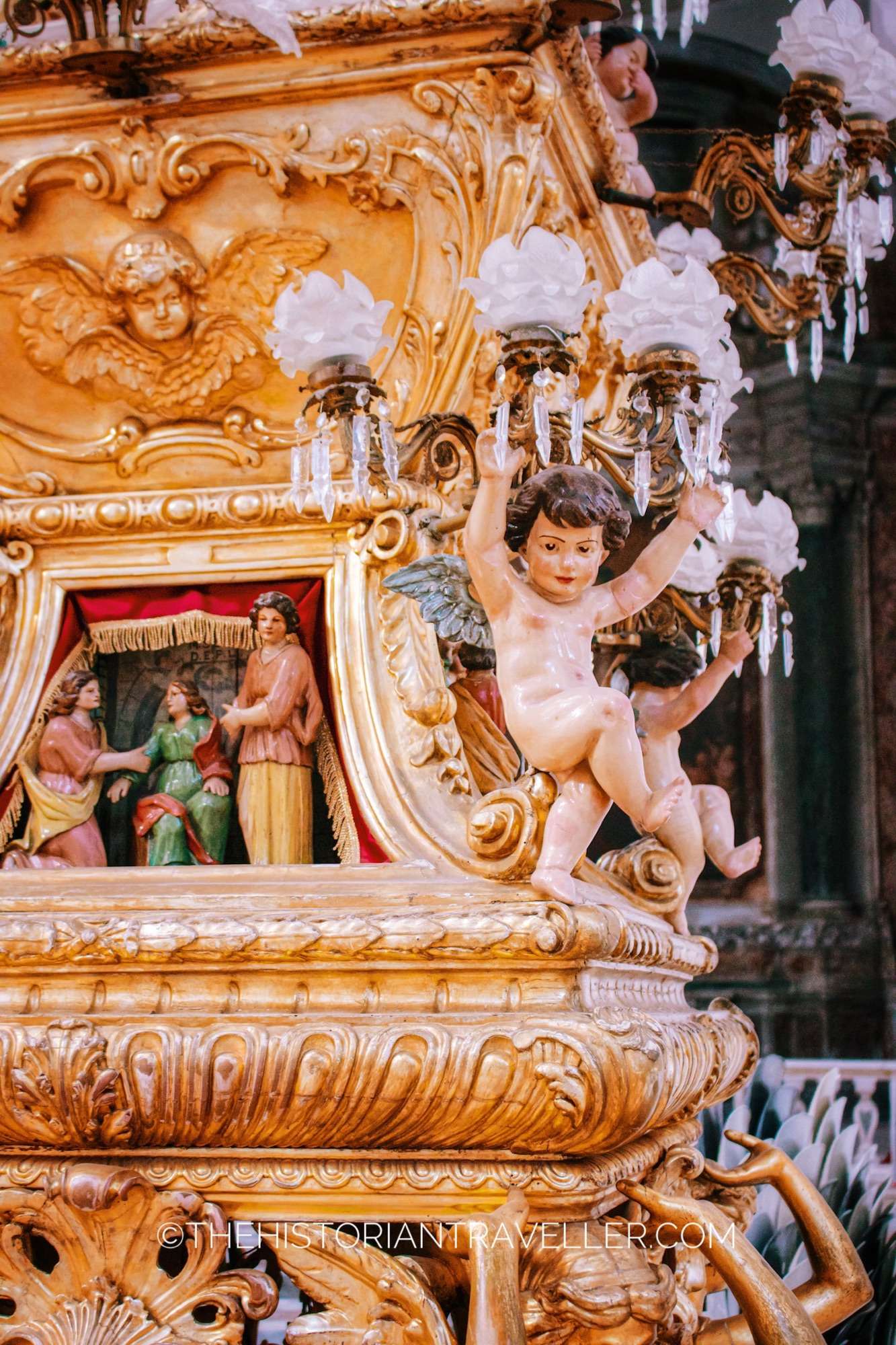
You’ll see thousands of people dressed in white clothes carrying some of the heaviest candles you’ll ever see, while shouting some motivational phrases like “Semu tutti divoti tutti?” (aka “are we all devotes here?” with all of them replying Cittadini (aka, yes all the citizens). During these days, the Saint’s bodily reliquaries, that are usually hidden inside a secret chamber under the cathedral, are being carried around the city centre on a carved and full of precious jewels coffin called feretro. This means that most of the central areas are completely blocked off for the festivity as thousands of people attend every year.
3. Opening times, this mysterious thing
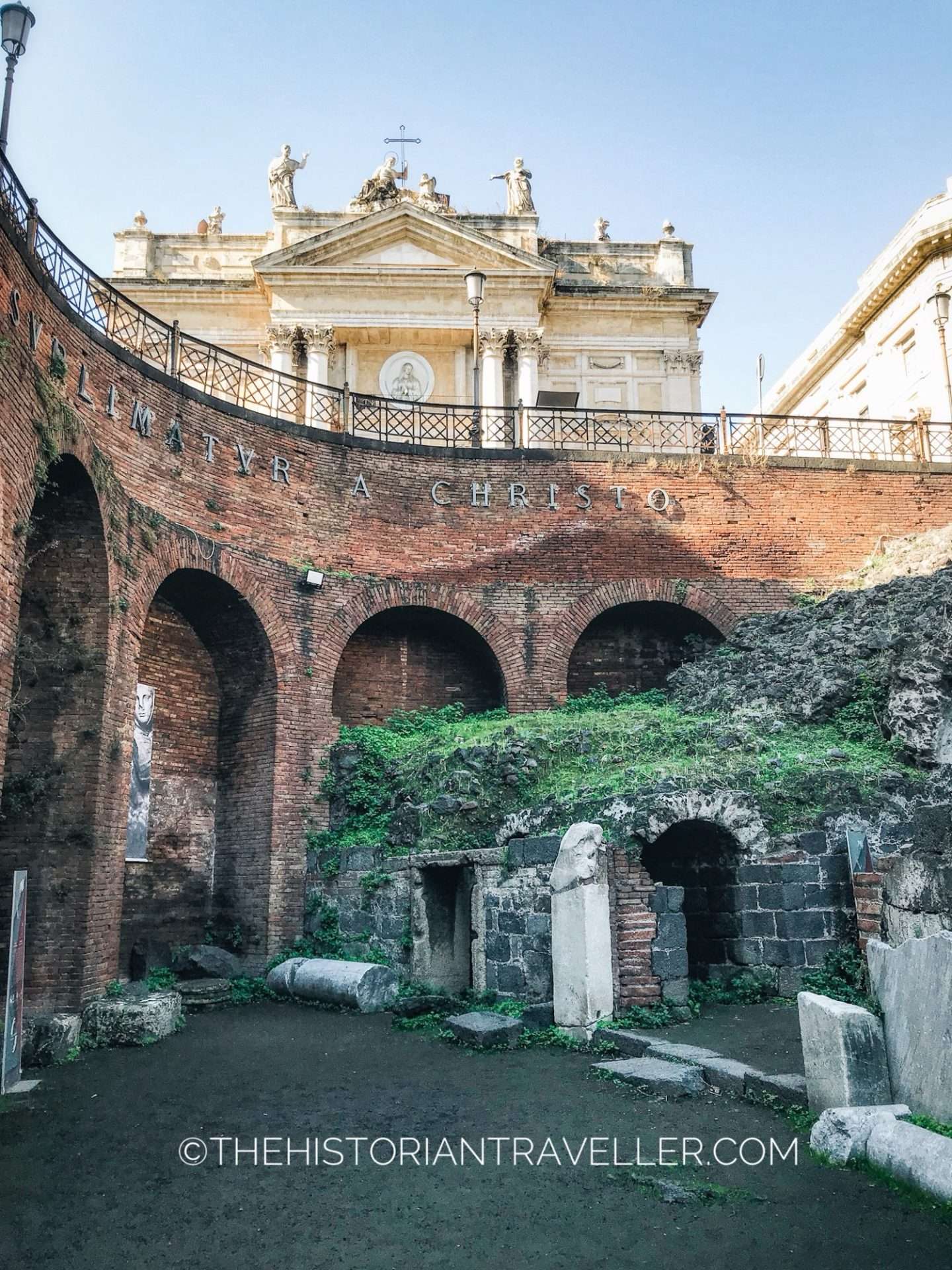
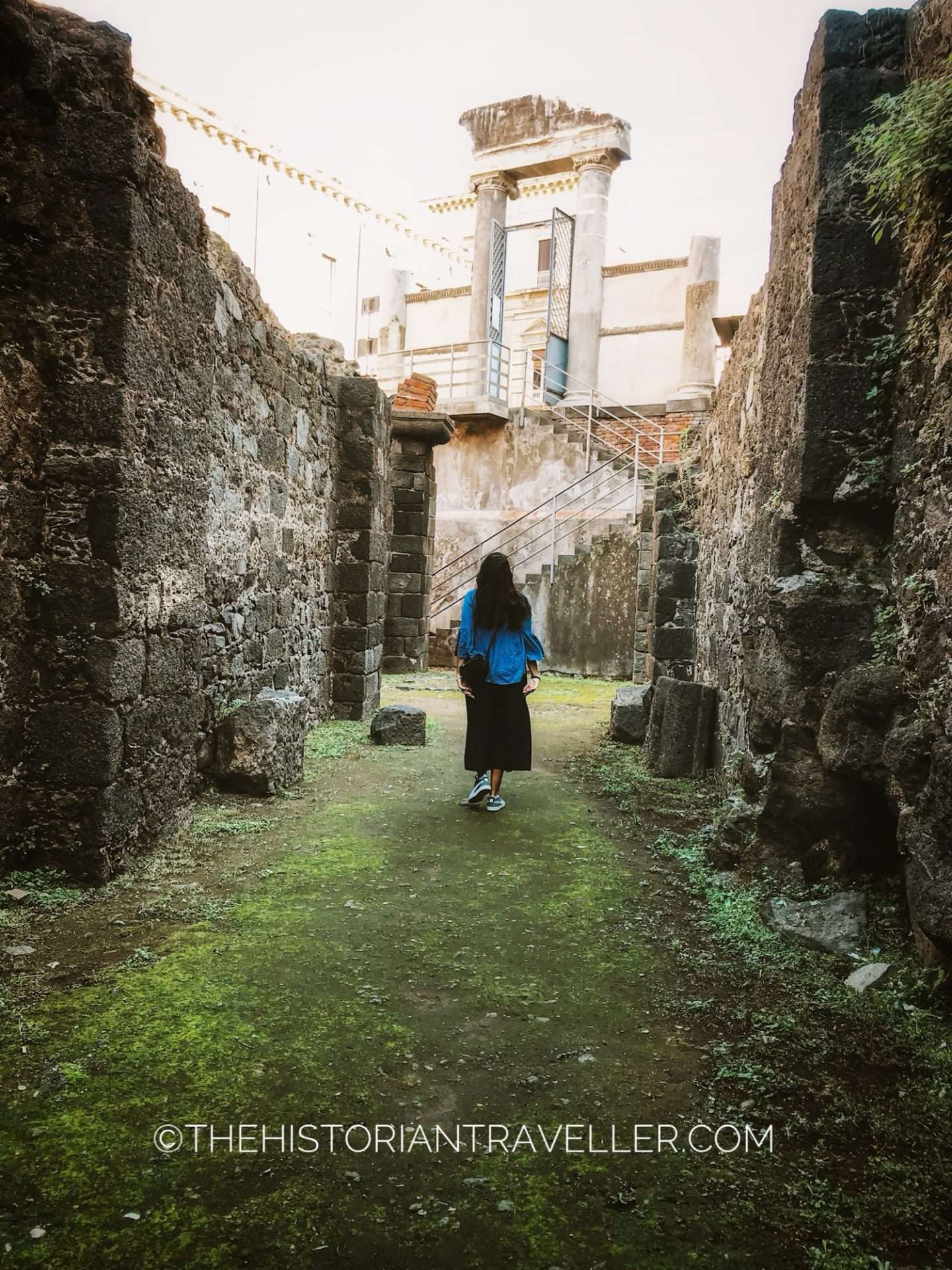
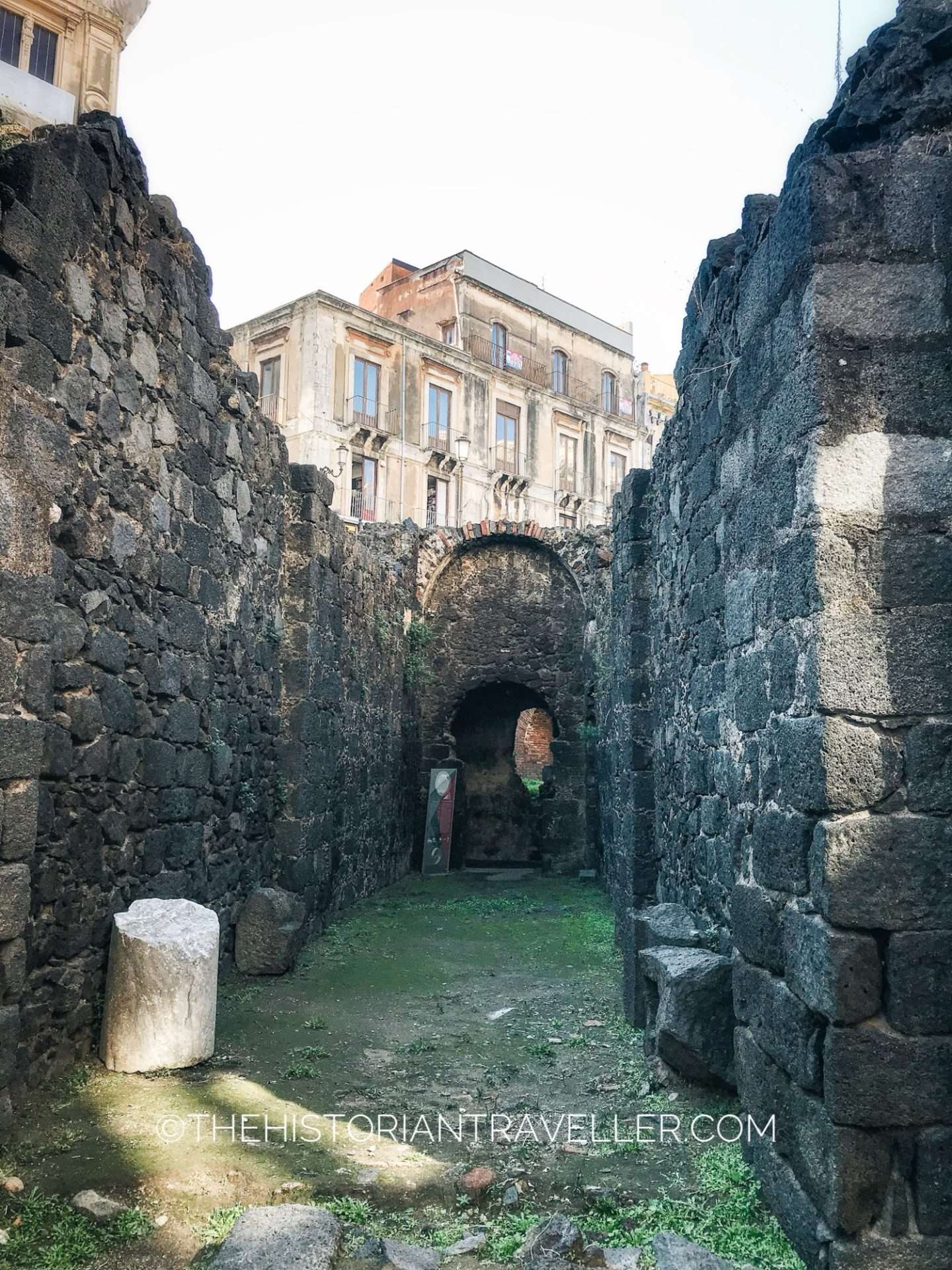
There is A LOT to see in Catania. Nevertheless, many attractions are often closed to the public or have wrong opening times. This will test your patience as you can’t plan a proper itinerary. The best thing to do is have a plan B and swap your visits if necessary. Unfortunately, the administration is very bad and it’s often quite unclear when places are open or not. One of the places that has often issues is the Anfiteatro in Piazza Stesicoro. Look at the opening times on the gate, but don’t be surprised if they are well-ignored by who works there.
Insider guide to Catania, 3-day itinerary
A 3 day itinerary of Catania is the perfect amount of time to explore the main highlights of the city. Indeed, you can have the opportunity to check-out also its coastal towns or dig a little deeper in what the centre has to offer.
Day 1 in Catania
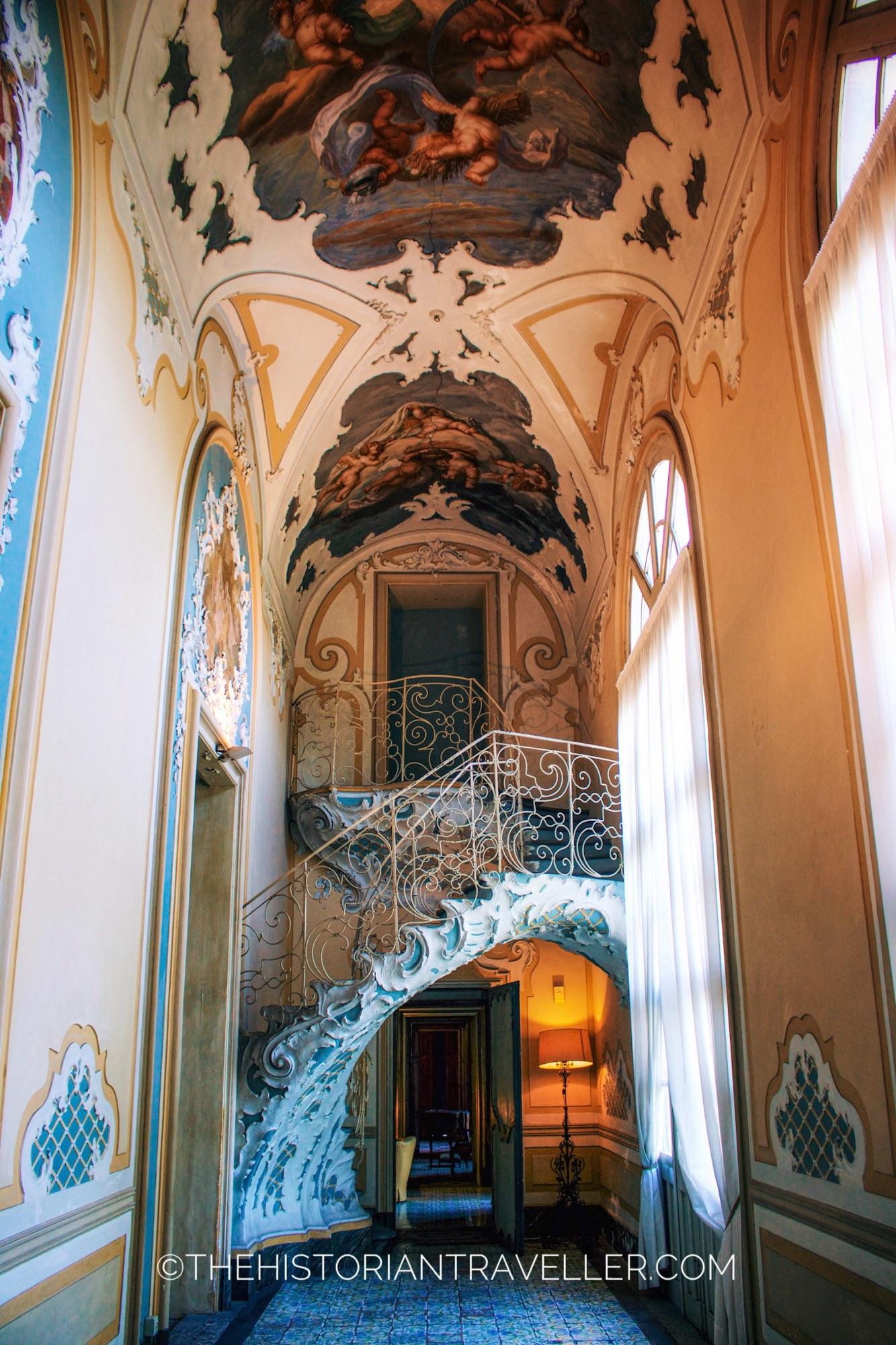
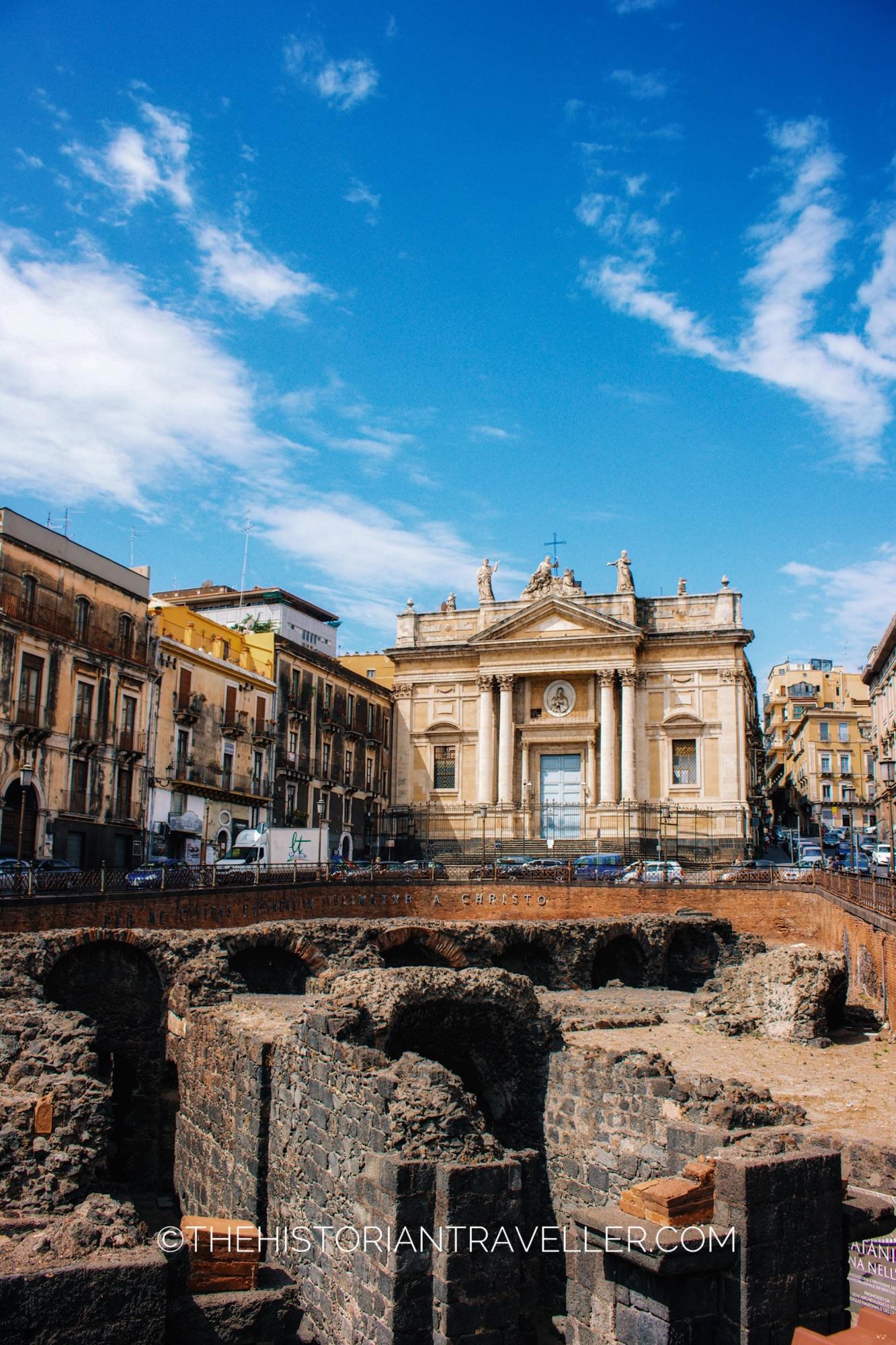
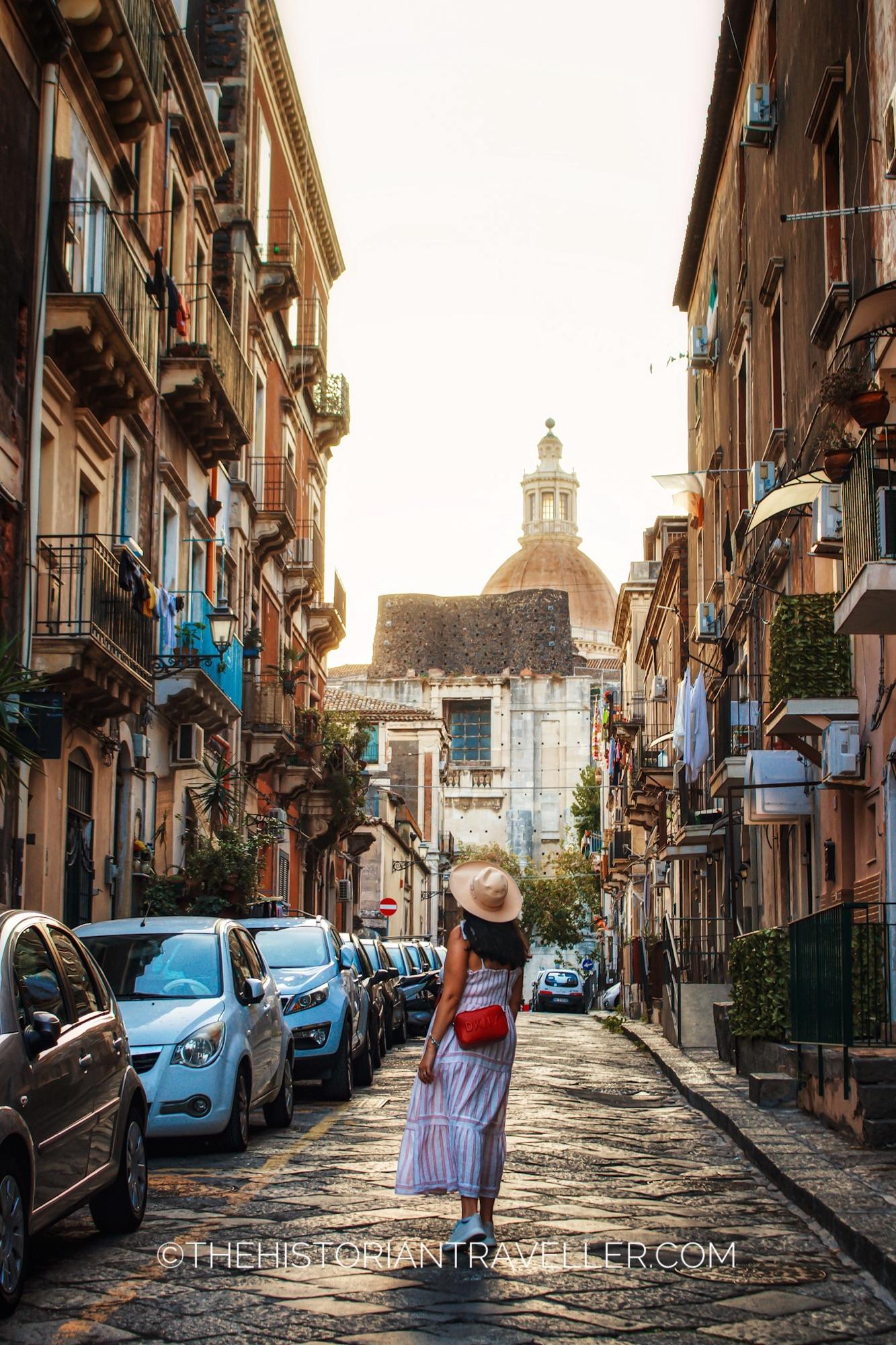
Catania has many unmissable historical sites and the unique Via Etnea, encompasses a large part of them. I would recommend to spend your first day strolling the 2.8 km-long main street of the city. Here you can have a lazy morning walk around the Giardino Bellini. Pop around one of the numerous high-street shops along the way (e.g. La Rinascente). You can also discover the ruins of the Roman Amphitheatre in Piazza Stesicoro.
Refill yourself with one aperitivo rinforzato along the way. You can ask one in any of the bars populating Via Etnea and the surrounding areas. Then, you can descend the street towards the majestic Piazza Università. Here, immerse yourself into the best of Catanese’s Baroque architecture. This is mostly appreciated into the churches named Colleggiata and Badia di Sant’Agata. As well as into the famous Palazzo degli Elefanti in the main Piazza Duomo. Once here don’t miss to snap a picture of the Liotru, the elephant obelisk at the centre of the square that is the symbol of the city. End your tour with a visit to the Cathedral and its hidden treasures. For a deeper and unique experience, try to climb up the Badia di Sant’Agata rooftop. This is one of the most beautiful viewpoints of Catania!
End the day with the best burgher in town at the famous FUD Bottega Sicula. Be there early and try to avoid Saturday night. They don’t accept reservations and queues can take even 45 mins. However, it’s well-worth the wait!
Day 2 in Catania
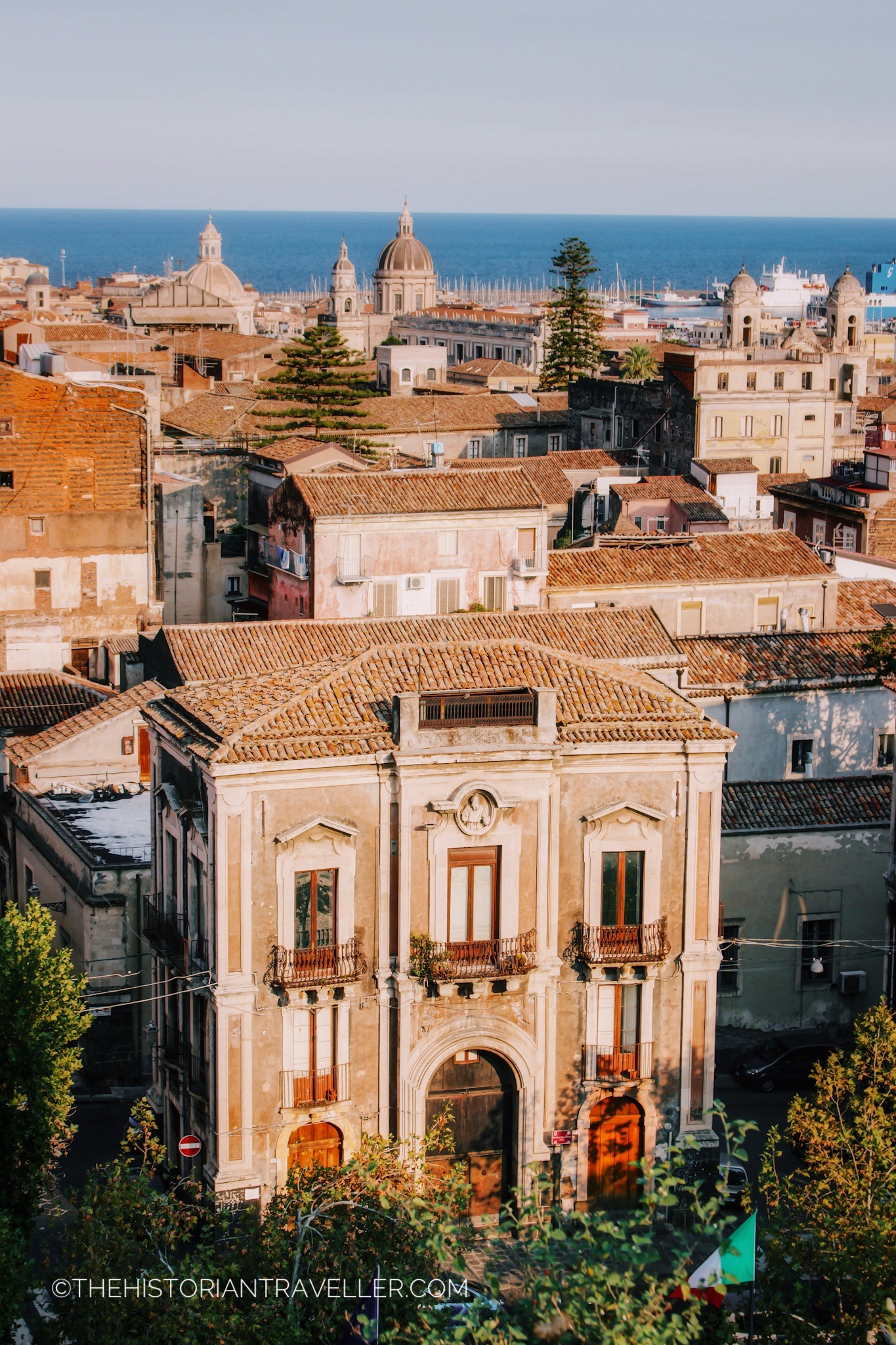
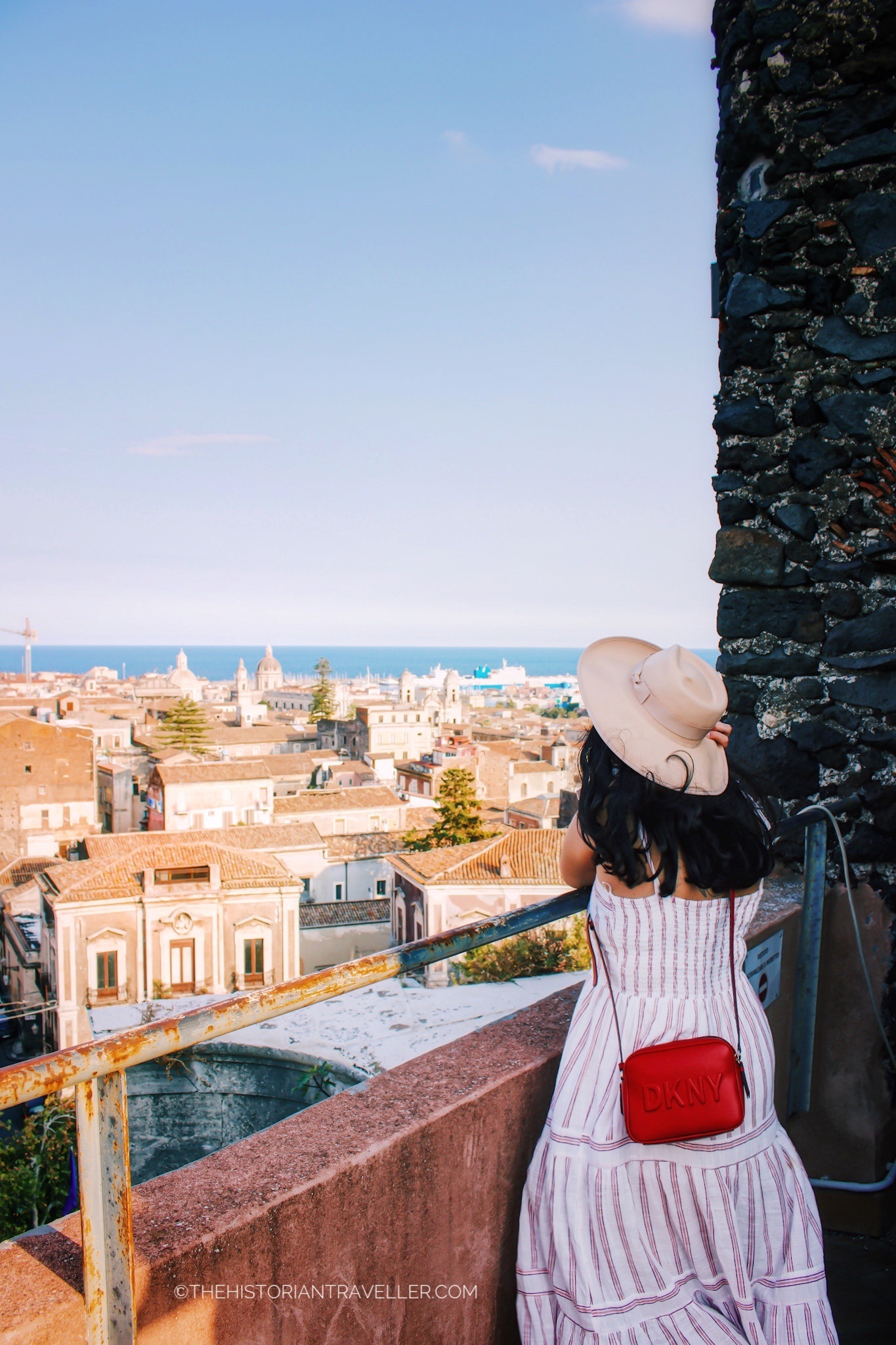
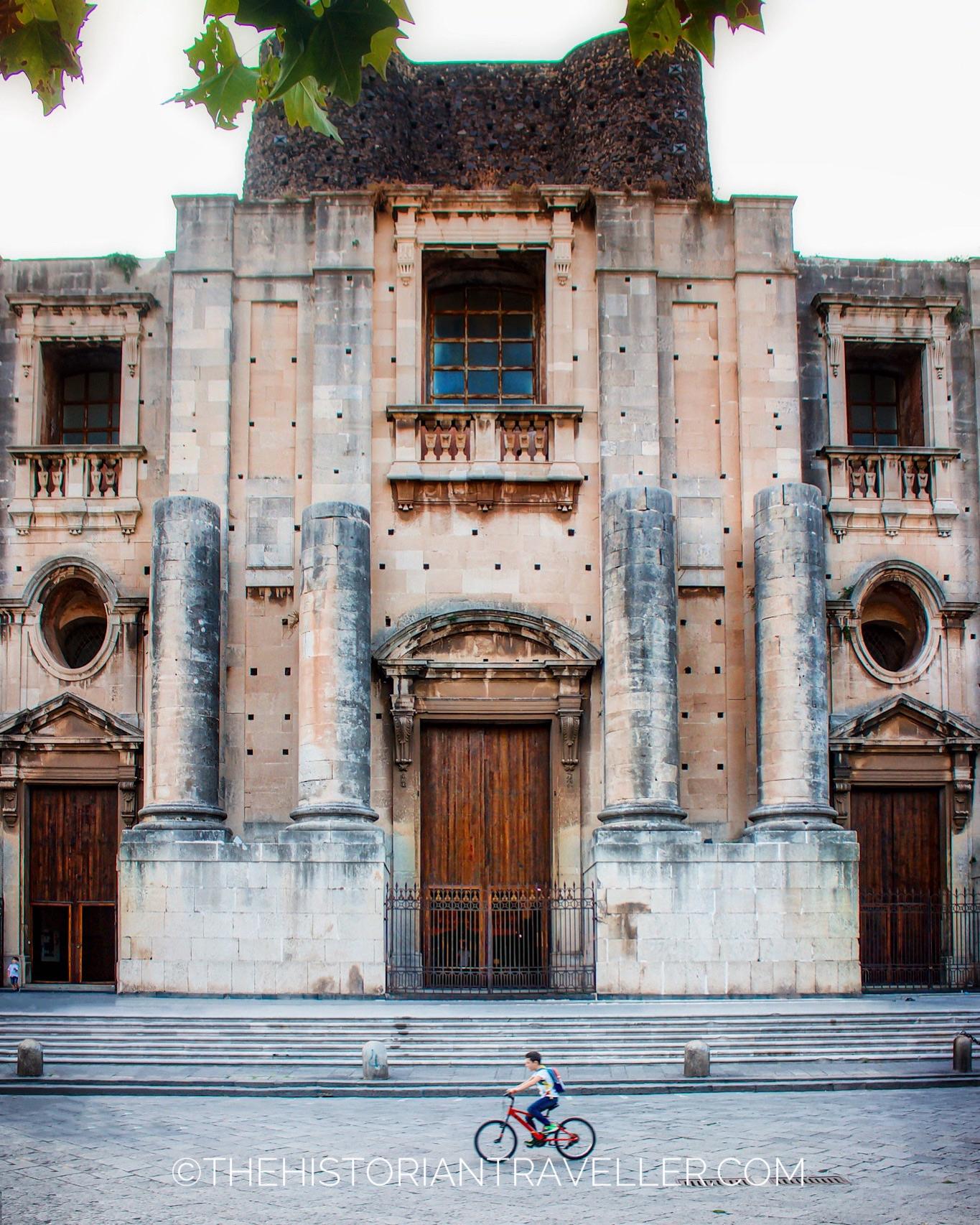
If you have a second day in Catania, it’s time to hit its most famous historical sites. Start the day at the Monastero dei Benedettini and get lost in its hundreds of corridors and beautiful cloisters. While inside the building, don’t miss a stop to the unique Ursino Recupero Library. From there, proceed to the adjacent Church of San Nicolò l’Arena and discover its secret terrace with an unbeatable view over the city. Don’t forget to check-out also the church’s famous meridian. A rare architectural gem of Sicily. Afterwards, there are two choices.
Going towards the Greek Roman Theatre and then to the medieval Ursino Castle or walking the historical Via di Sangiuliano to visit the scenic Via Crociferi and the related Baroque churches. All these sites are very close (10/15 mins walk from each other). Therefore, you can pick up any point is suitable for your itinerary. Don’t skip a visit to the Roman Terme della Rotonda and the lovely Villa Cirami. They are not always open, but if they do, they are worth a visit!
Have a delicious lunch in one of the local taverna in the fish market A Piscaria and enjoy a traditional and quiet ora di pranzo.
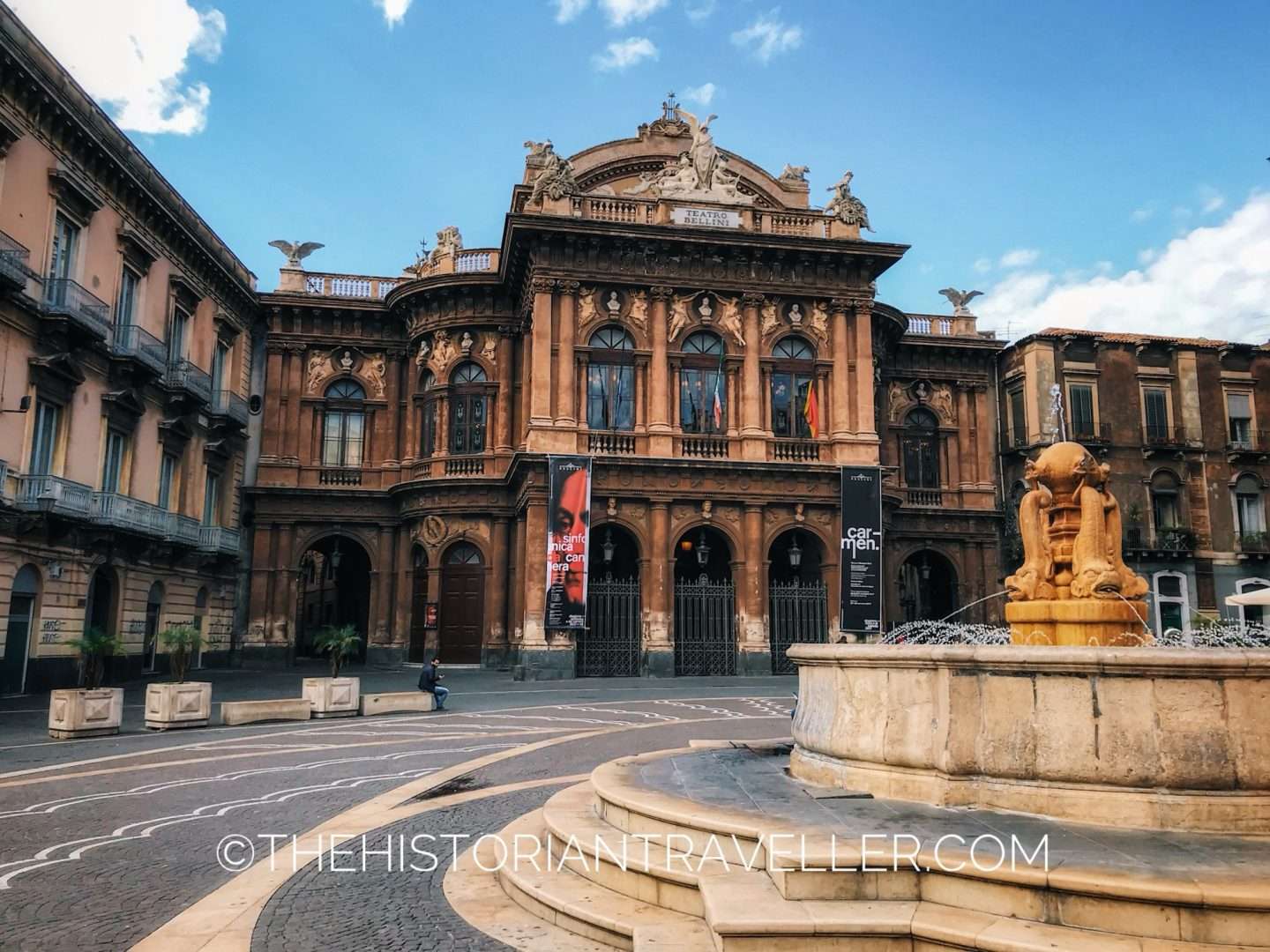
If you want to explore a little more in the afternoon, pop a visit to the lovely Palazzo Biscari. Built over the historical walls of Carlo the Fifth. It’s famous for its richly decorated Orchestra Ballroom and the unique fiocco di nuvola (candy cloud) staircase. From this year, you can even pre-book your visit online here If you are a classical music lover, I recommend adding also a stop to the beautiful Teatro Massimo Bellini and its unique Mirror Room.
End the day with a fantastic pizza at Al Vicolo Pizza & Vino.
Day 3 in Catania
For your third day in Catania, you can opt for two different itineraries. The first, will take you to some less known locations around the city that you haven’t visited in the previous two days. I recommend this itinerary to those who really want to get a deep knowledge of all the historical sites and spend another day around the Catania’s lovely Baroque architecture. The second itinerary, will take you to the coastal areas of Catania and its small fishing villages. This itinerary is perfect for those who are happy with their city experience and want to explore a little bit further. Please note that it’s easier to reach these places by car but I will give you also a bus option in case you really don’t want to drive.
Below, you’ll find both options.
Hidden Catania Itinerary
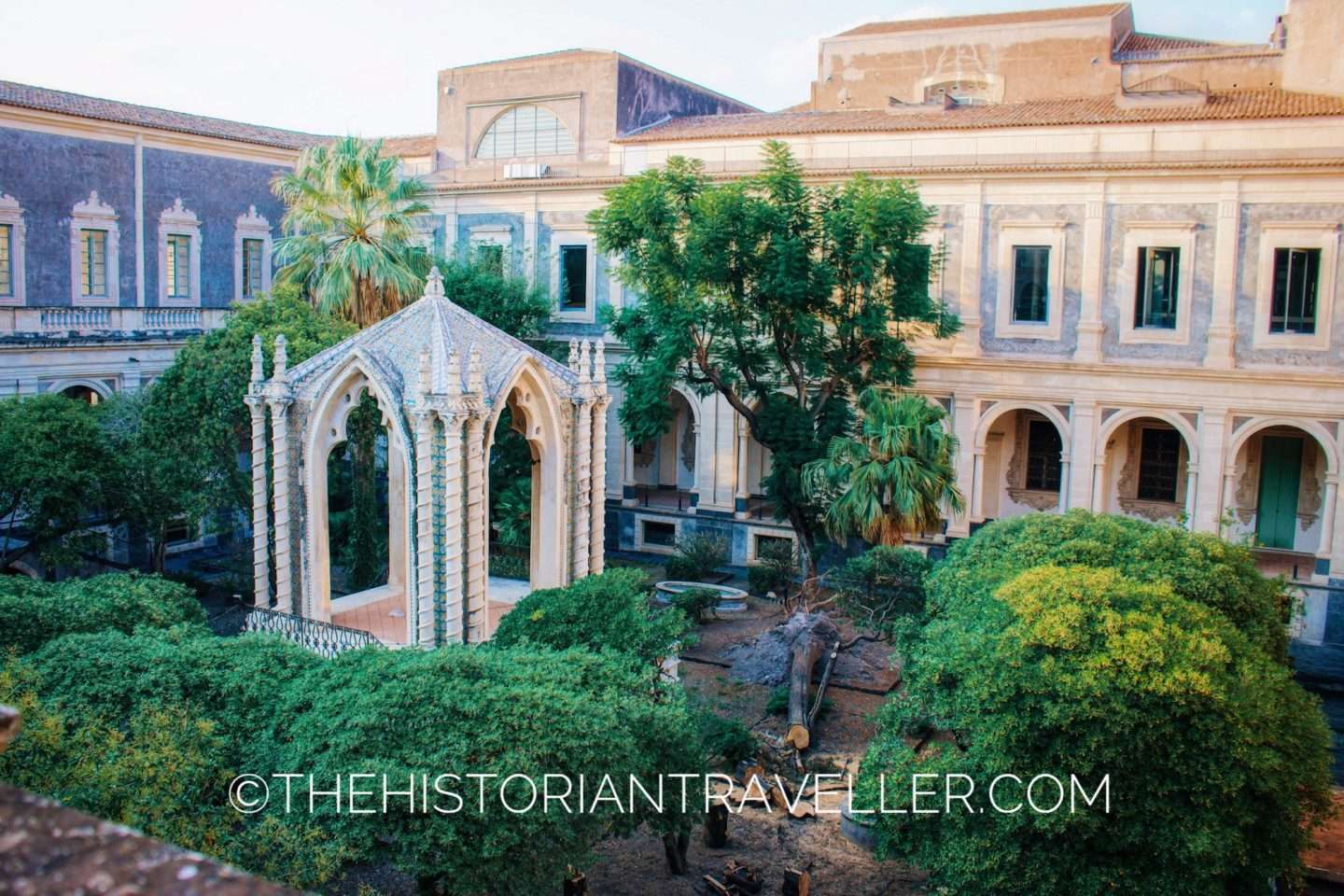
If you loved your two-day itinerary in Catania and want to deep-dive further in its historical attractions, I recommend checking out these additional places.
- Pozzo di Gammazzita. Definitely a no-go area at night but perfectly fine during the day, this well is famous for its tragic legend. Indeed, this says that a young woman named Gammazzita killed herself here to not dishonour her family after a man from the army abused her during the war. Because the water has a high concentration of minerals and appears of a colour red(ish), people from Catania say this is the blood of Gammazita.
- Villa Zingali. If you are an architectural lover, you can’t miss this beautiful hidden gem. A villa with the most beautiful liberty porch you can find in the city.
- Museo Diocesano. An additional beautiful viewpoint in Catania. This is the museum of the Cathedral. Its strong point is definitely the terrace that offer a unique view over Via Etnea.
- Orto Botanico. Nestled in the highest part of Via Etnea, this lovely botanical garden is a real gem and preserve some unique plants.
- Cappella Bonajuto. One of the few remaining examples of Medieval Byzantine architecture preserved in Catania.
- Istituto per Ciechi. An incredible architectural hidden gem (that I honestly discovered just recently!). This beautiful building preserve many treasures, including a 23,000 volumes library entirely in Braille. Please note that I am not 100% sure this building is open to public visit. It’s certainly open during the FAI days in March but it’s better to double check before visiting.
- Teatro Sangiorgi. Nestled in the city centre of Catania, this little theatre is built entirely in Liberty style.
Coastal Catania Itinerary
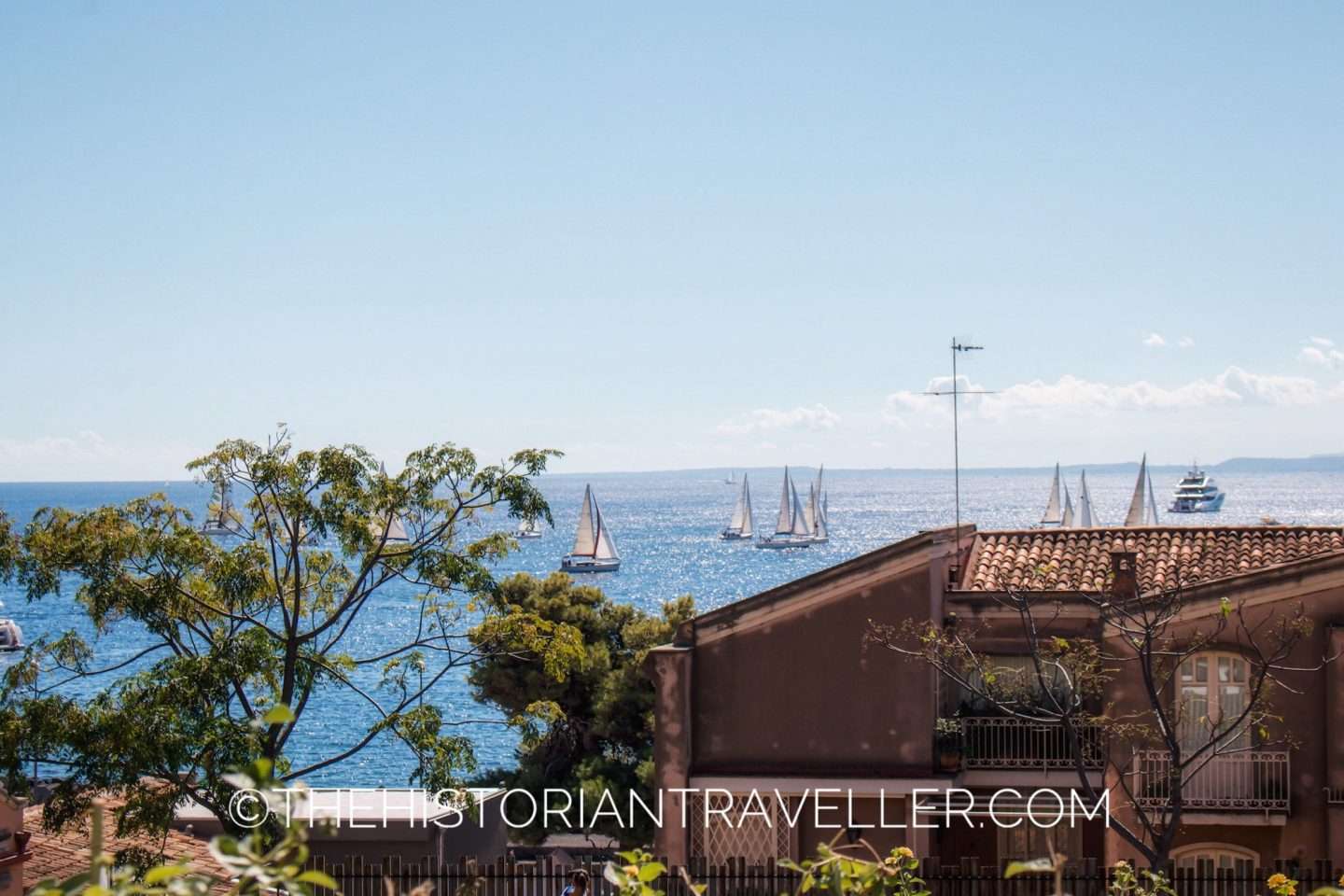
If you want to experience a different side of Catania, I do recommend visiting its northern coastal areas and villages. These offer a great escape from the bustling city centre and an opportunity to head to the beach during the summer months.
To note that Catania has also a different maritime area called La Playa that is quite popular during summer. This includes 18km of sandy beaches and beach clubs. I am honestly not a big fan of La Playa. In fact, it’s often super crowded and the water is not the cleanest you can find in Sicily. Of course, you want to add it to your list, feel free to visit it!
Ognina and San Giovanni Licuti
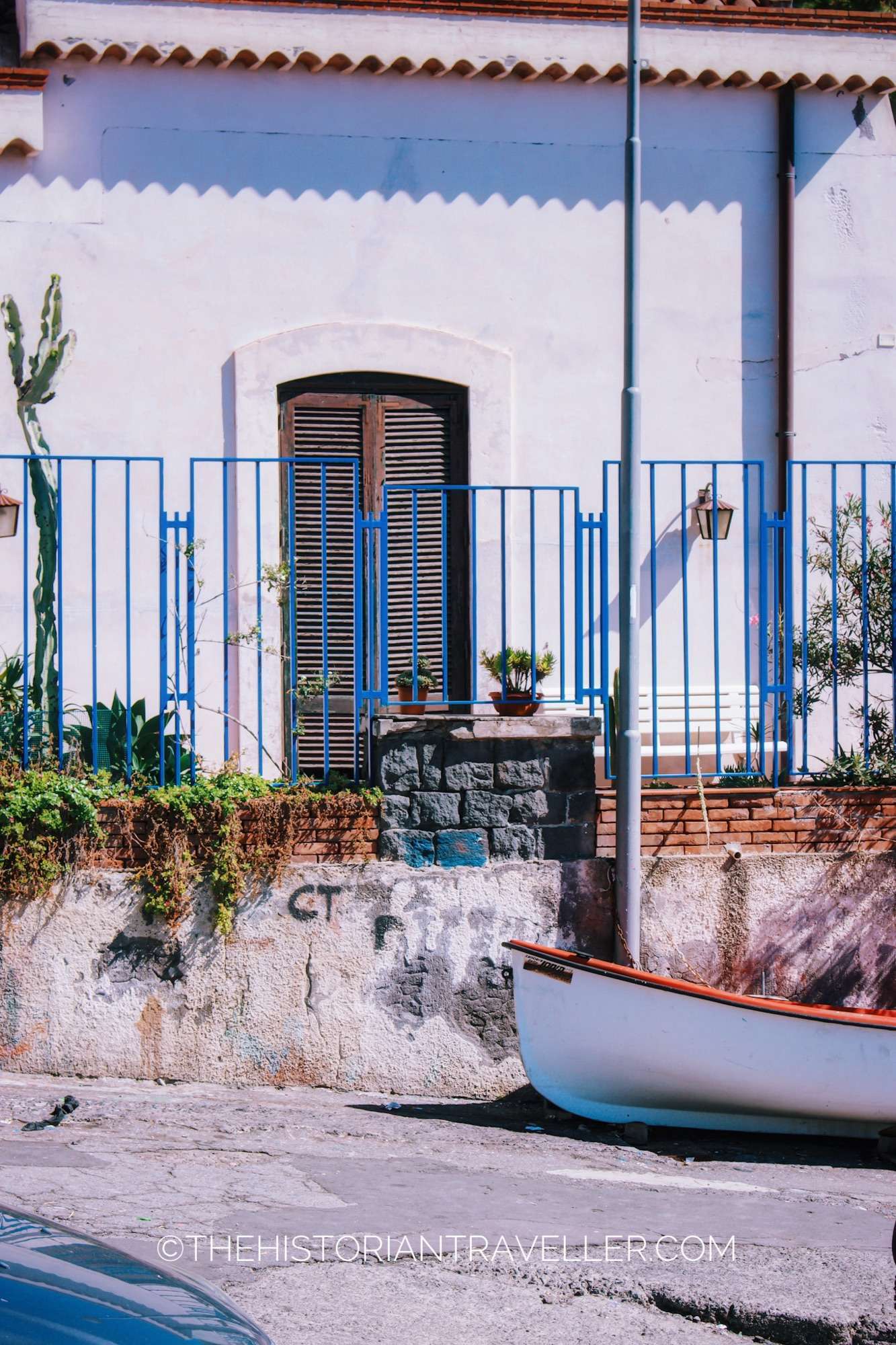
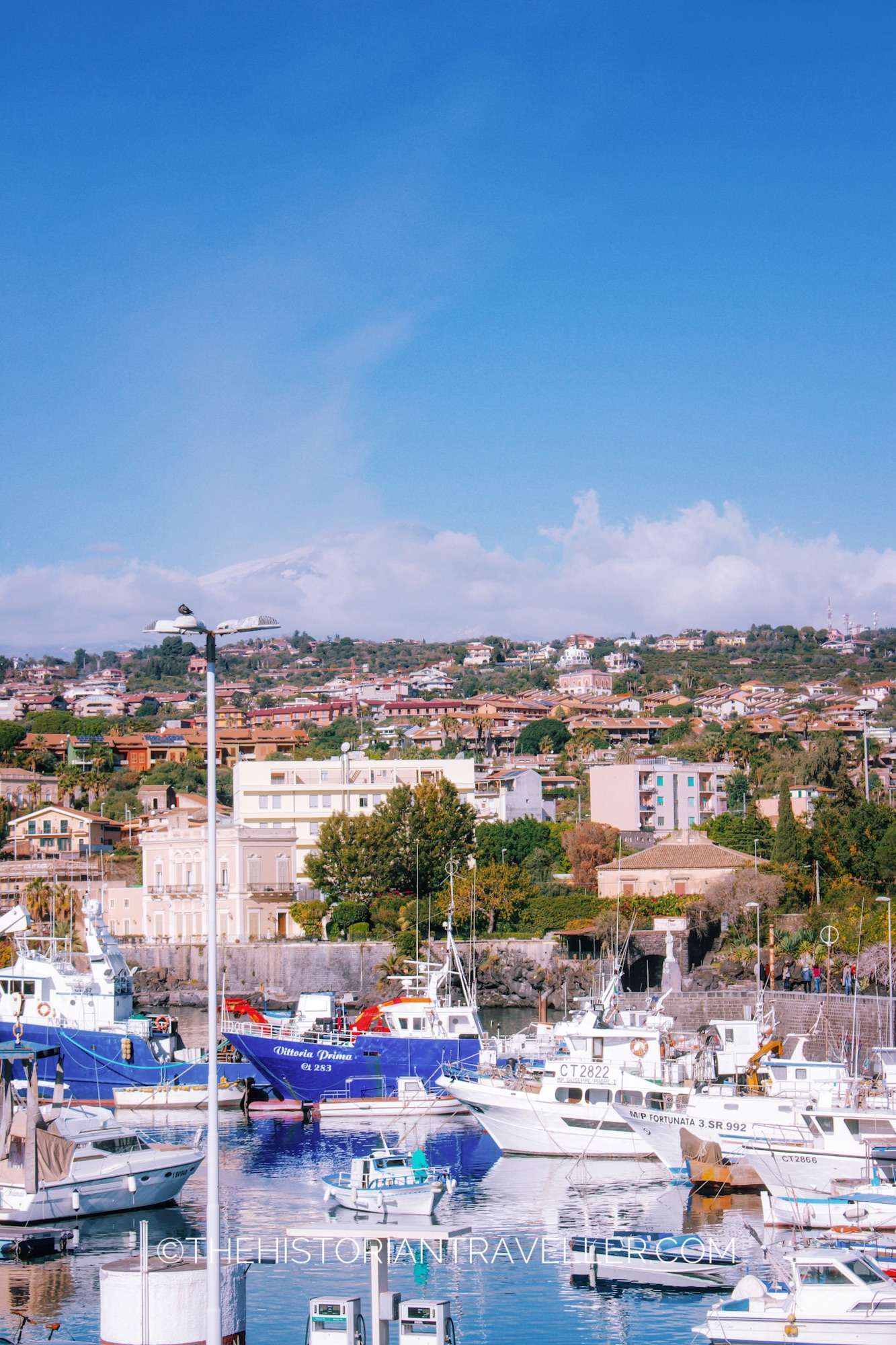
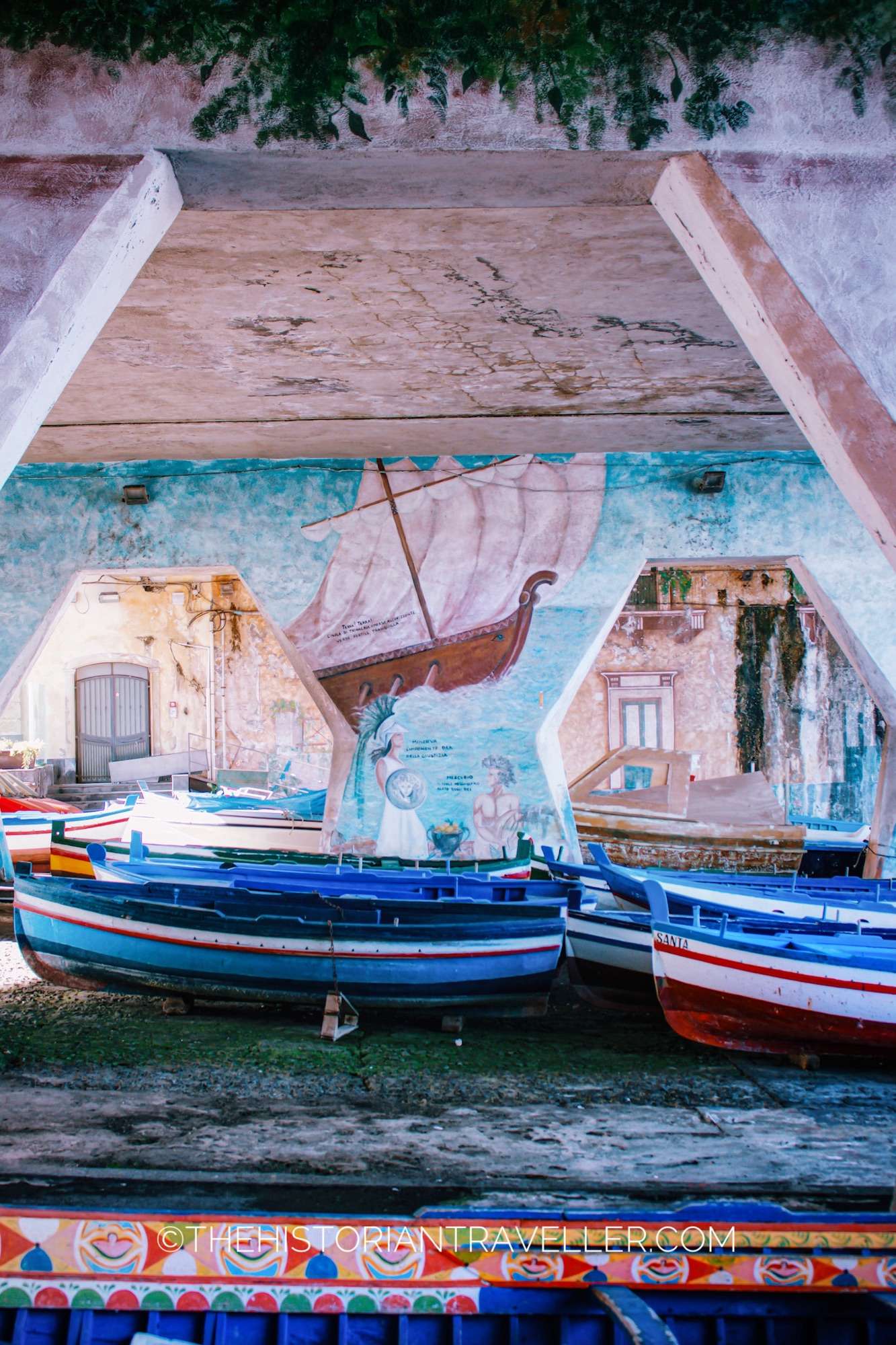
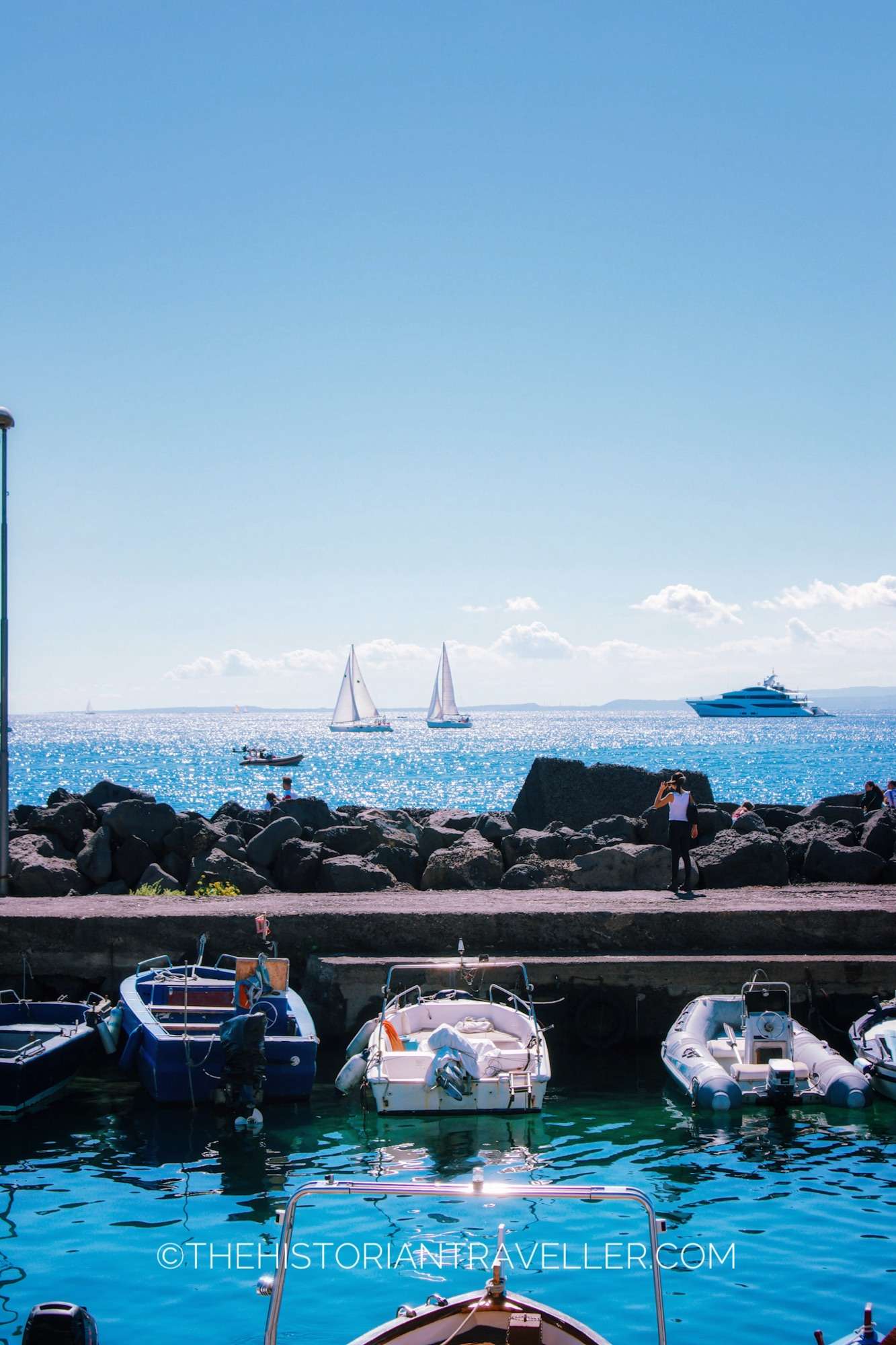
If you want to make a proper tour of the coastal areas of Catania, is worthy doing it at the Catanese way. Therefore, you should start early in the morning with a Granita at Ernesto. This is a small bar in the area of Ognina that is quite famous for its food and all-year-around granita. Indeed, it’s the perfect spot to have breakfast in the sunshine, even in full winter. Every single time I visit my parents, Ernesto is my go-to spot for granita in Catania. If you really want to showcase your Italian fluency, order a “granita al cioccolato con panna di sopra e una brioche” (chocolate granita with whipped cream on top and a brioche). You won’t regret it!
PS: the brioche is used as a spoon to take the granita from the glass!
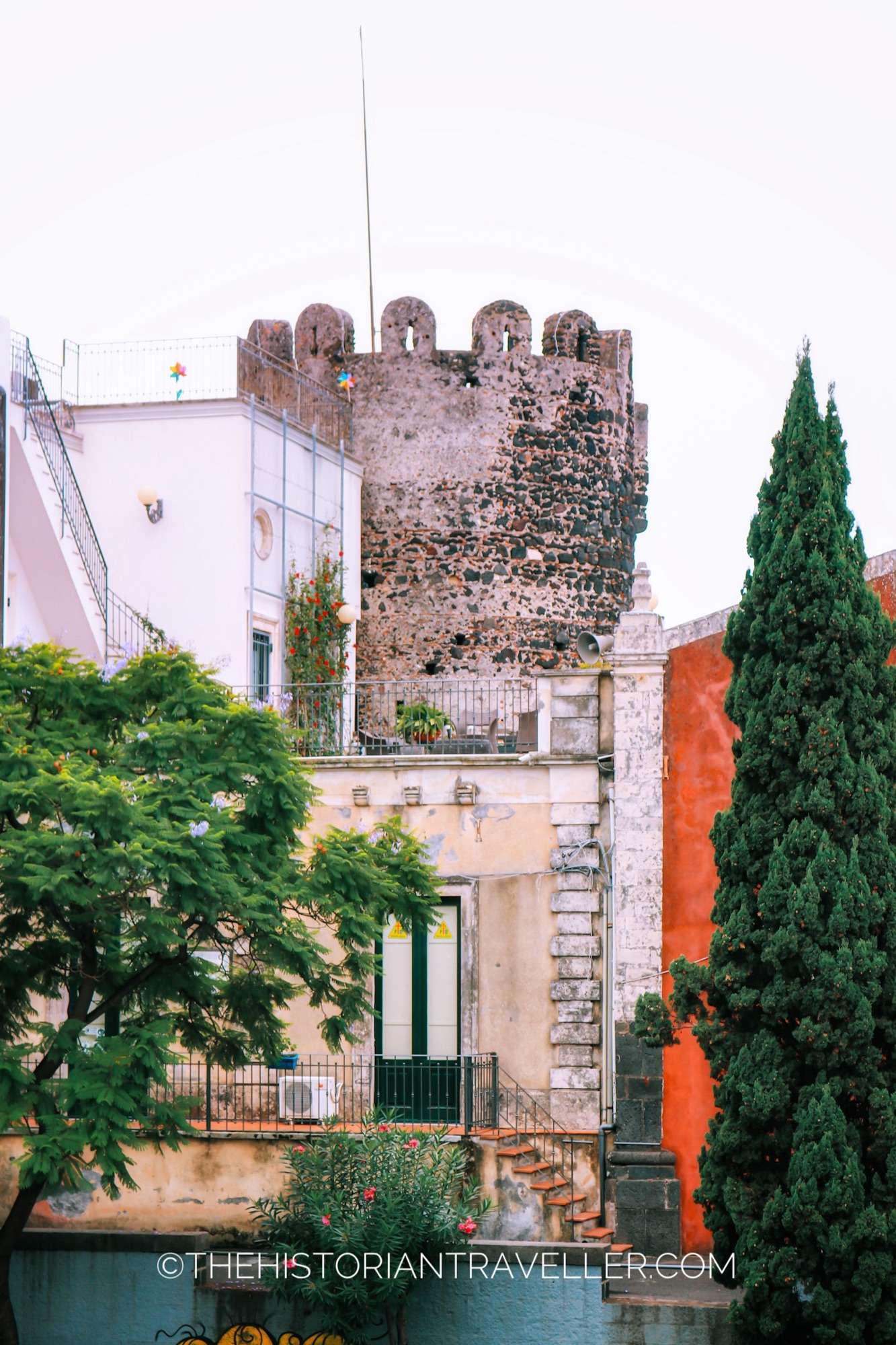
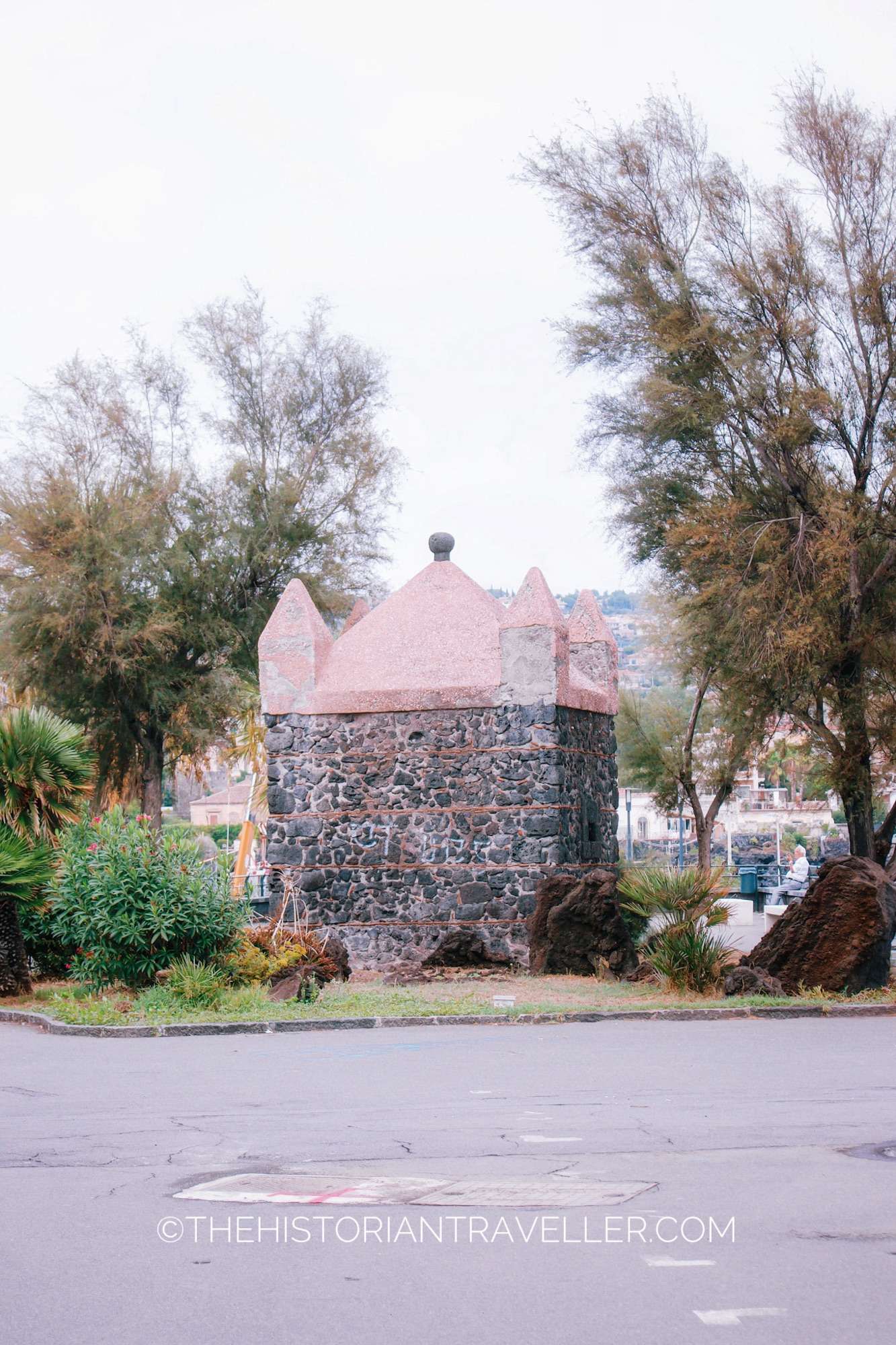
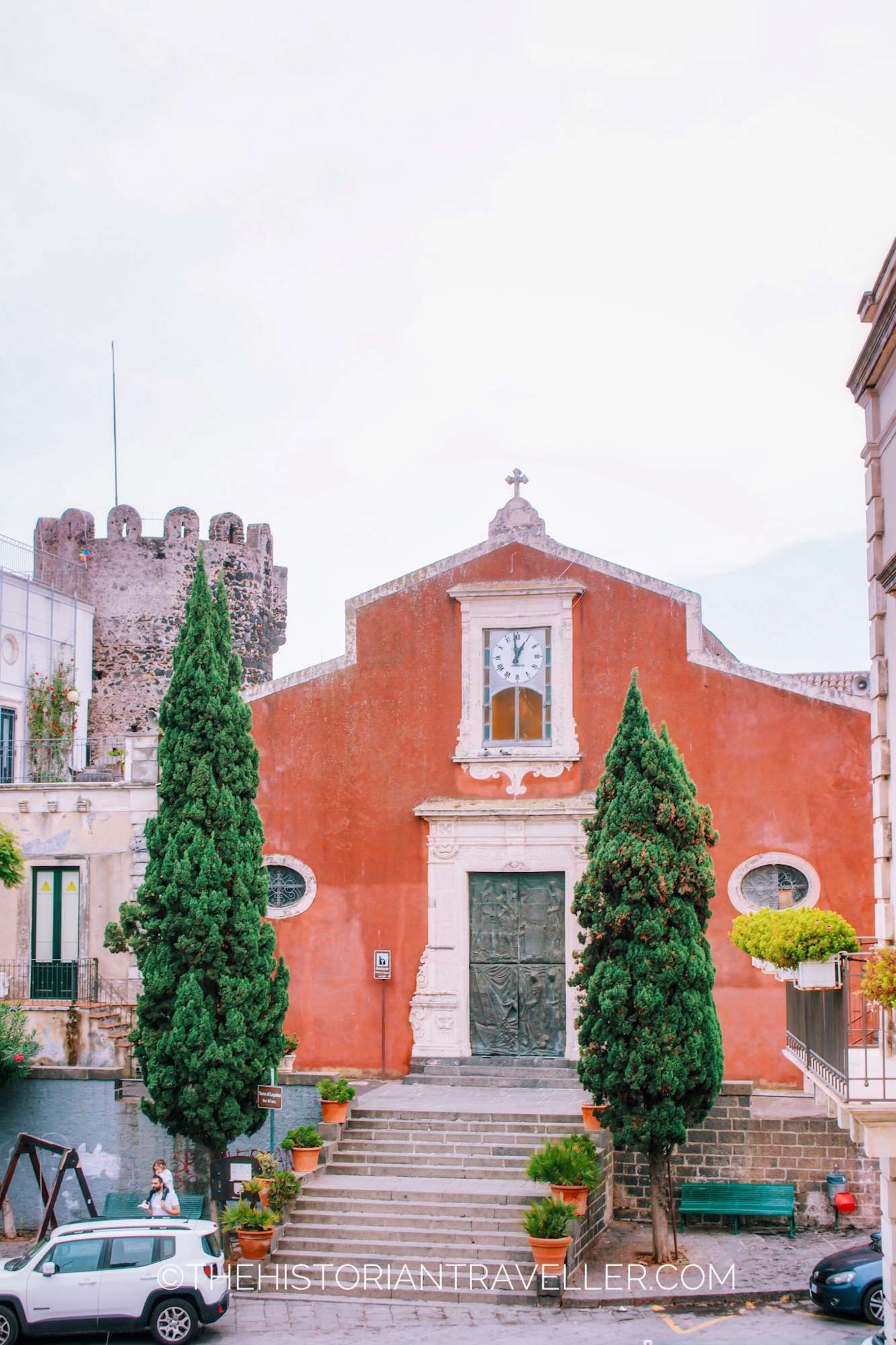
BUT, returning to the area you are visiting… after your breakfast, you can have a passiata (i.e stroll) in the nearby “lungomare“. A 9.6 km promenade running along the coast. Here you can see the best examples of Sicilian slow-life: people running, cycling, strolling, swimming (even in winter) and showing up for breakfast at 11 am. Worth to check-out in the area, the small beach of San Giovanni Licuti, the murales of the old dock and the only surviving fortifications of XVI-century Catania.
Acicastello
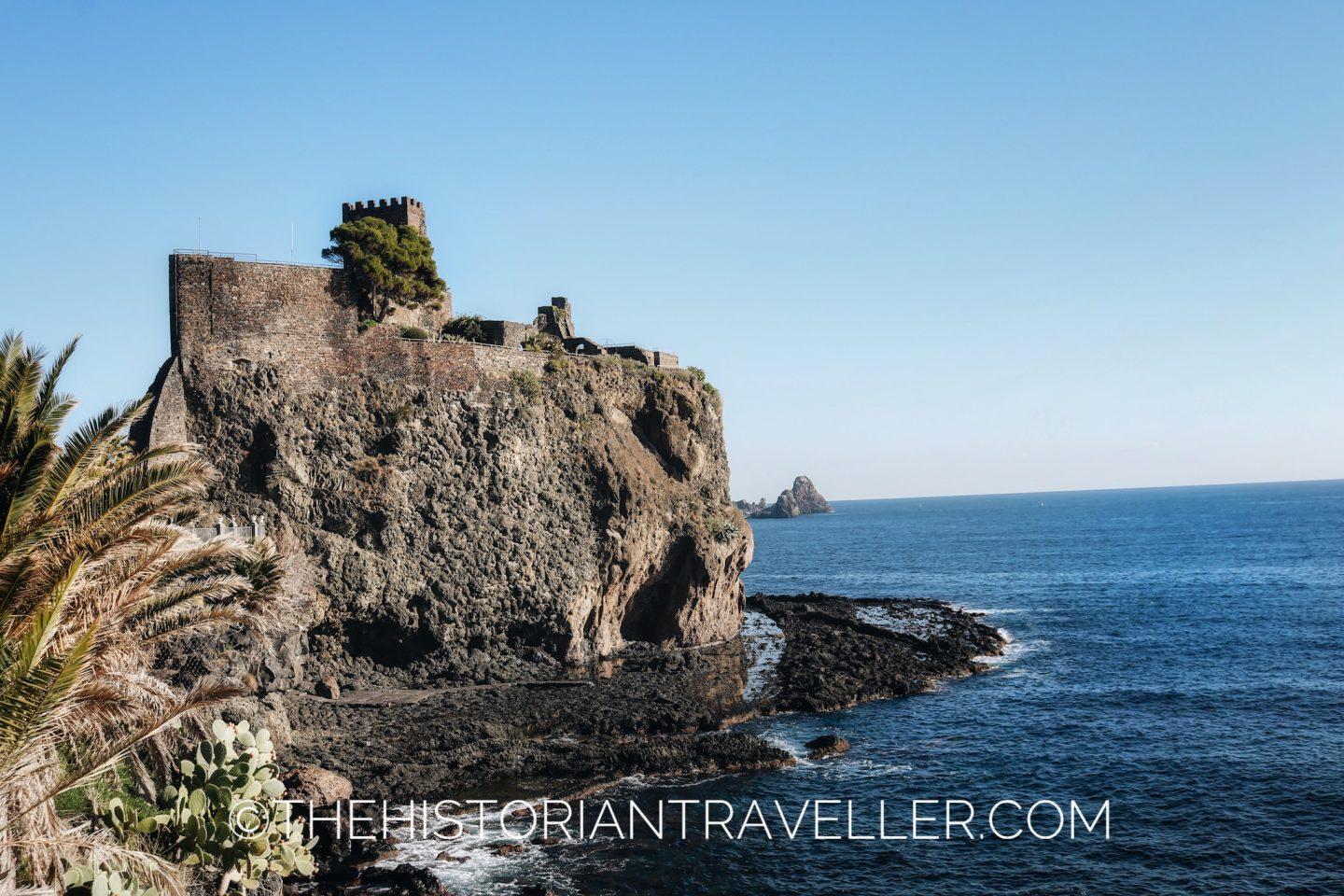
Located at 9 km from Catania, Acicastello will be your next stop of the day. This is a small town famous for its castle dating to 1076. Of Greek foundation, the Castle of Acicastello has Byzantine origins, but its current architecture remains Norman. Unique in its genre, the castle is built over basalt rocks dating back to 500.000 years ago. For Catanese people, this castle is particularly important because here in 1126 the relics of Saint Agatha have been repatriated from Constantinople after being stolen years earlier.
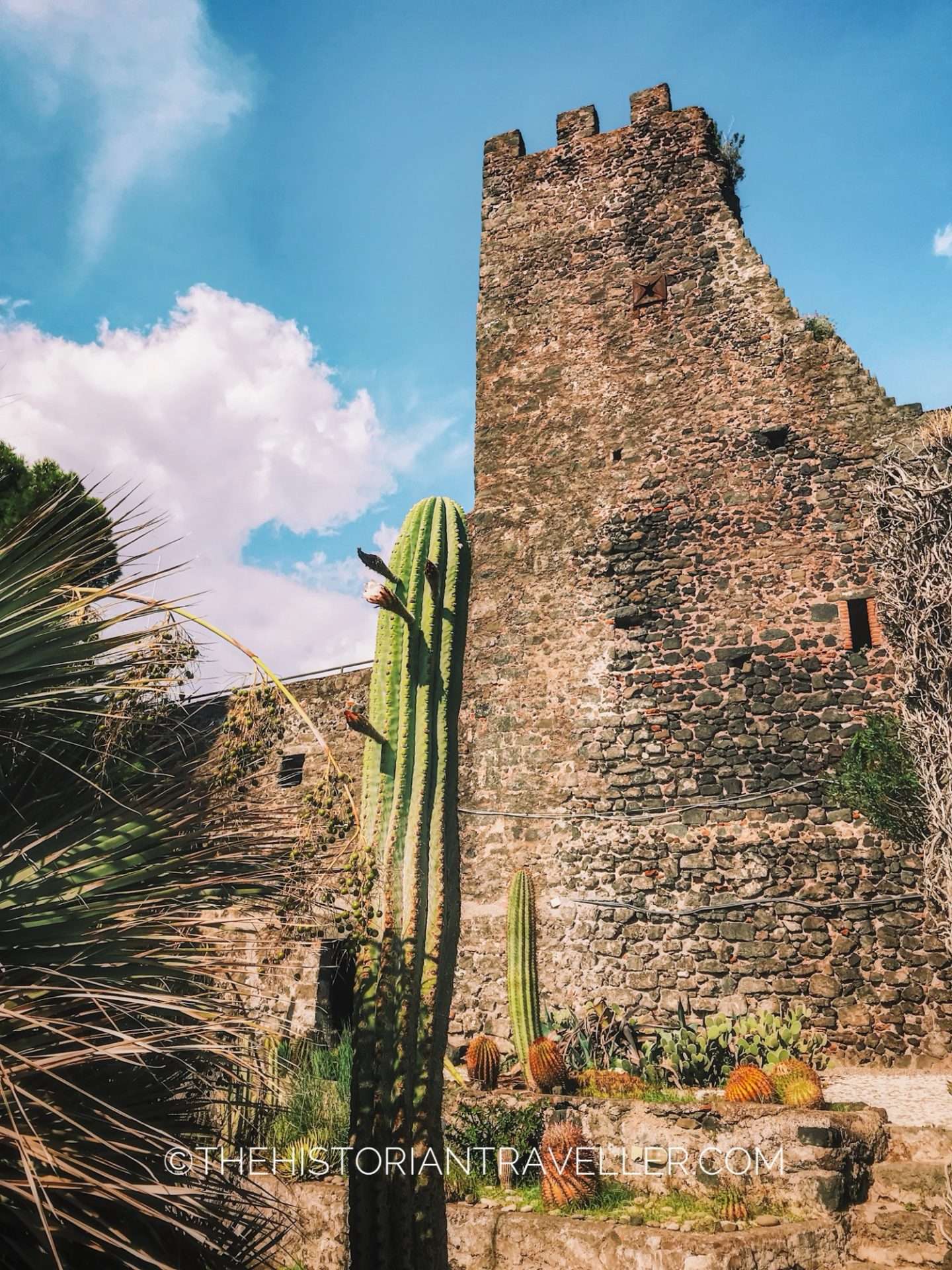
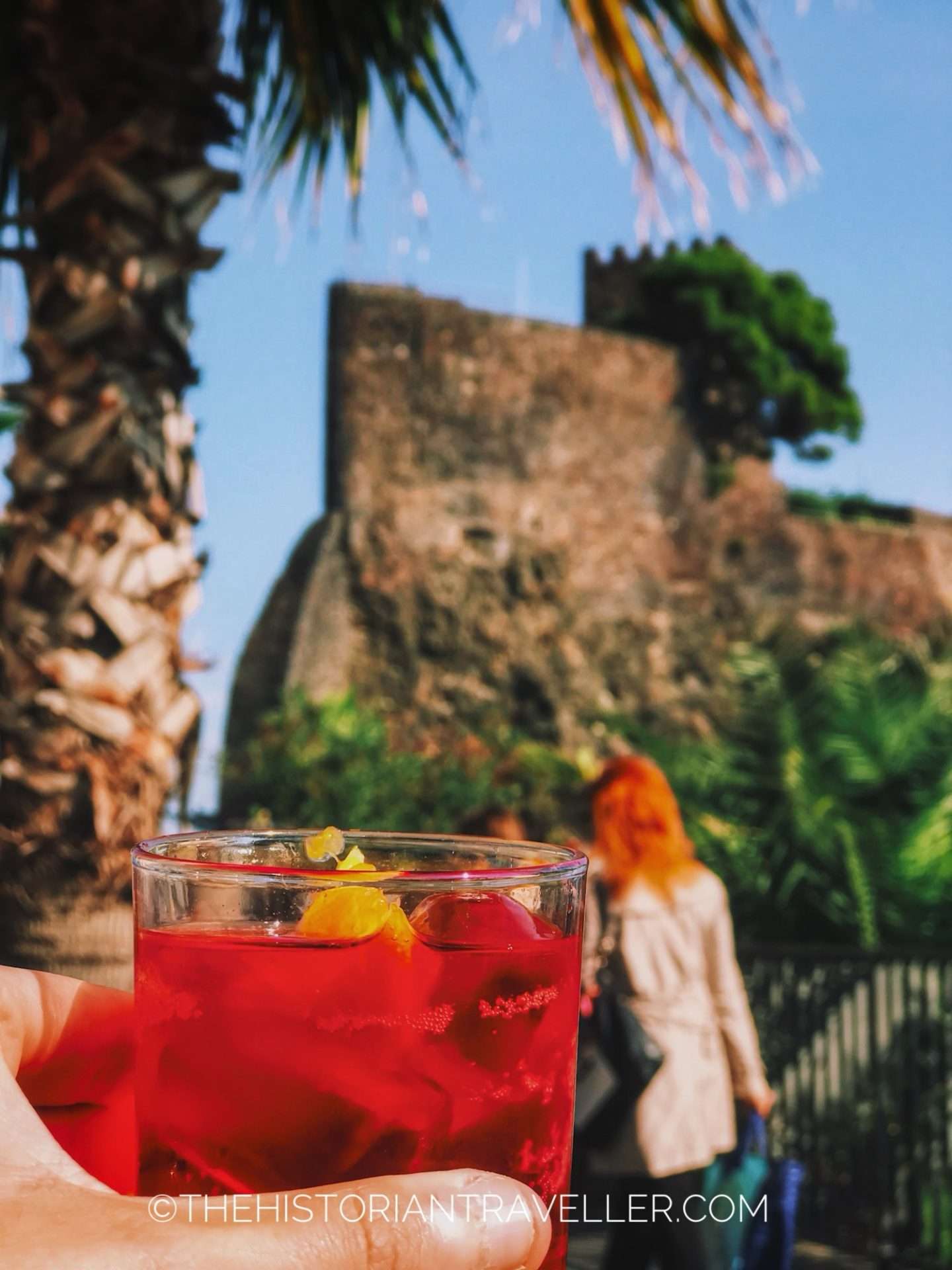
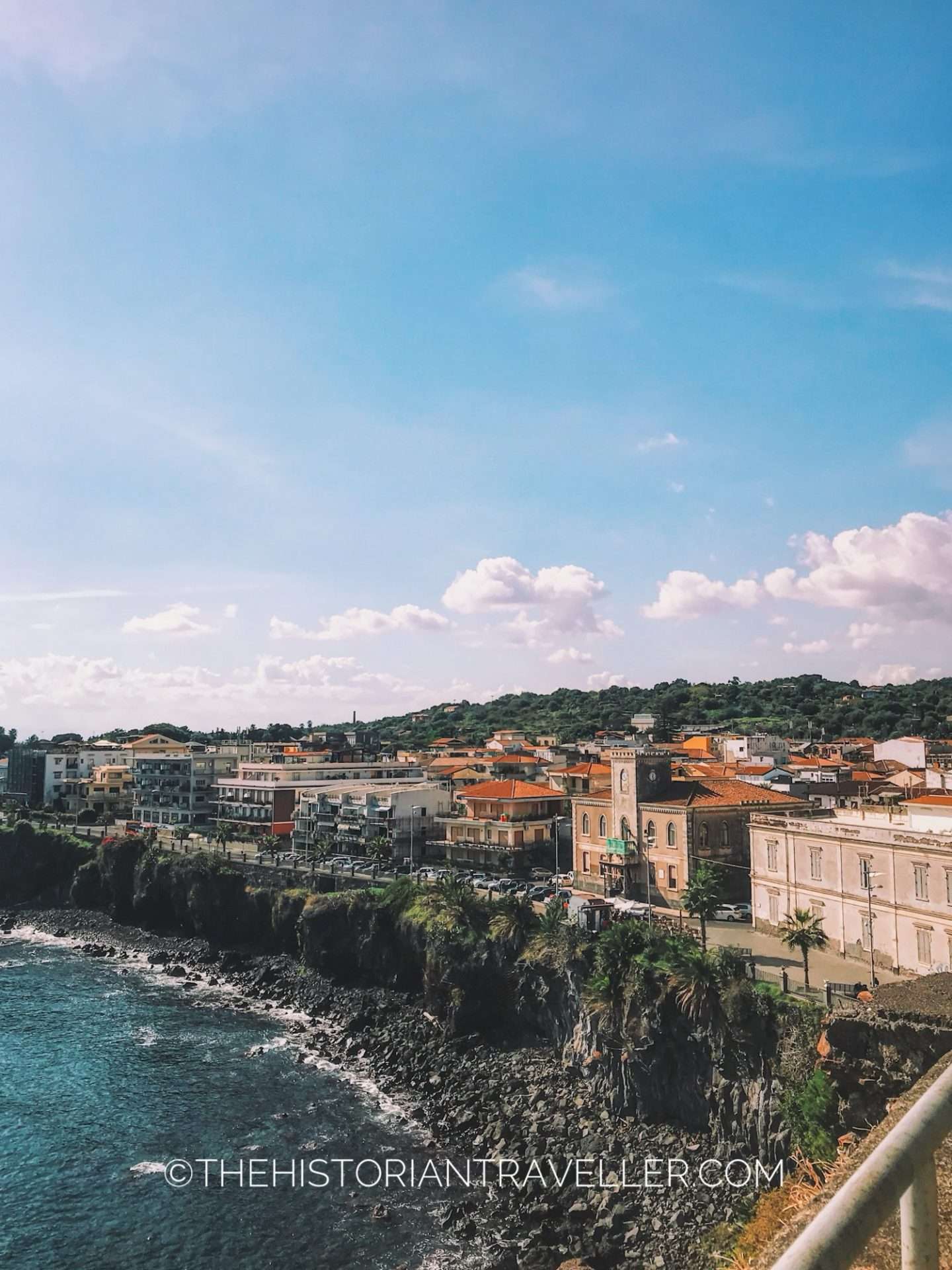
Acicastello is a lovely town to stroll. Very quiet during the morning and lively at night, particularly during summer time. The Castle is, of course, the main attraction point and is generally visitable every day from 9 am to 7 pm (with a closure time between 1 and 3 pm). Bring some cash with you as there is a fee to pay to access the castle (the last time was about 4,5€) and card machines are rarely working. The castle now hosts a little museum and a botanical garden. If you want something fresh along the way, the kiosk in front of the City Hall serves cheap aperitivo and inexpensive fresh drinks (with a lovely view on the castle).
Swimming under the castle is technically possible during summer. This was also my favourite swimming spot during my teenager days in Catania. However, you have to be careful as the basaltic rocks are extremely sharp (particularly underwater when climbing back to the shore). Moreover, it’s not a “relaxing” beach spot. This means you can’t lay down well on the rocks so you need just to sit somewhere. You need also to be a good swimmer as the water under the castle is immediately deep and the flow strong. For intermediate swimmers, the shores from Lungomare Cristoforo Colombo offer a better and safer alternative. Look for a staircase to head down near the Kiosk area. My parents still swim there early in the morning every day in the summer!
Acitrezza
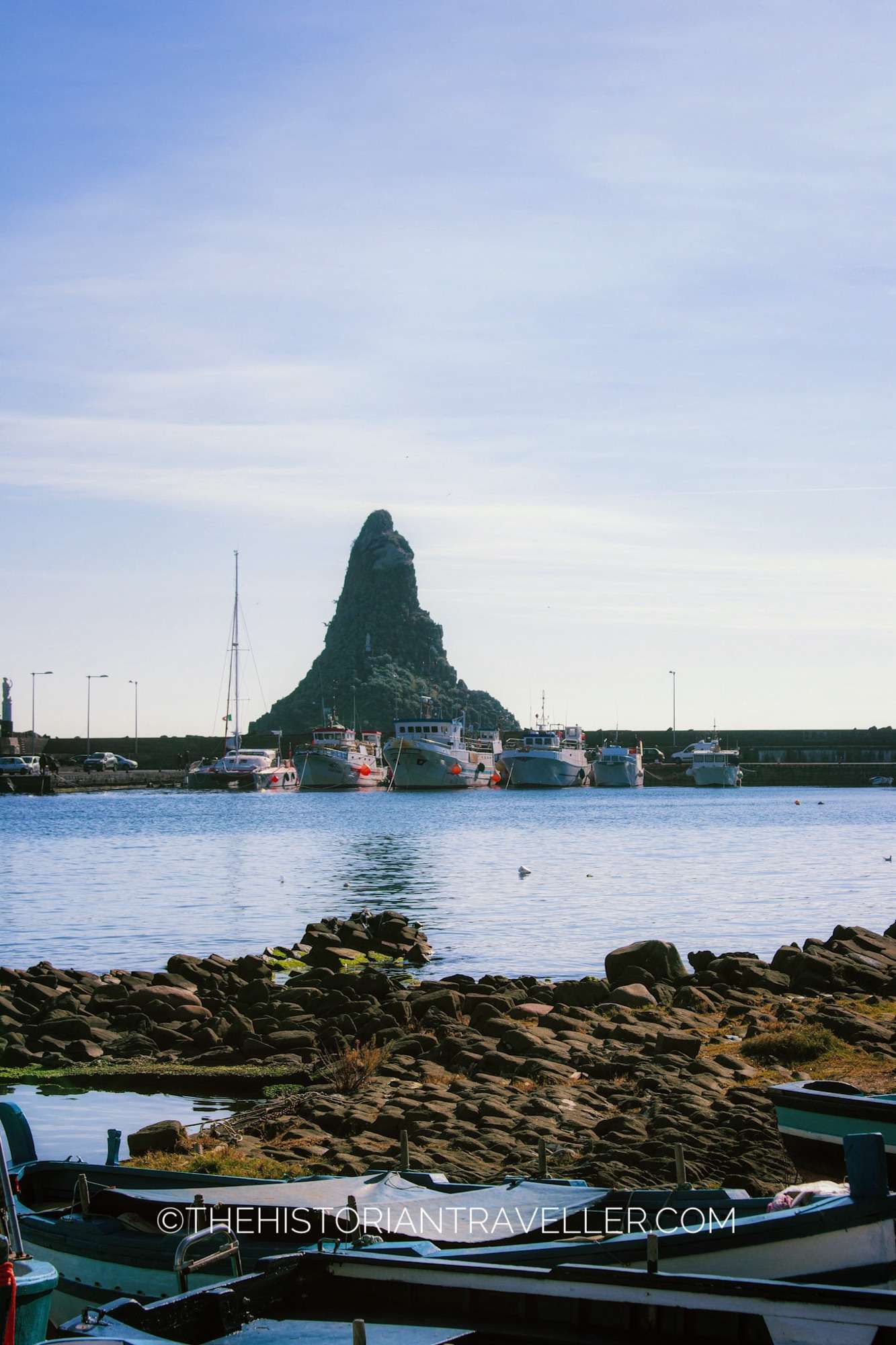
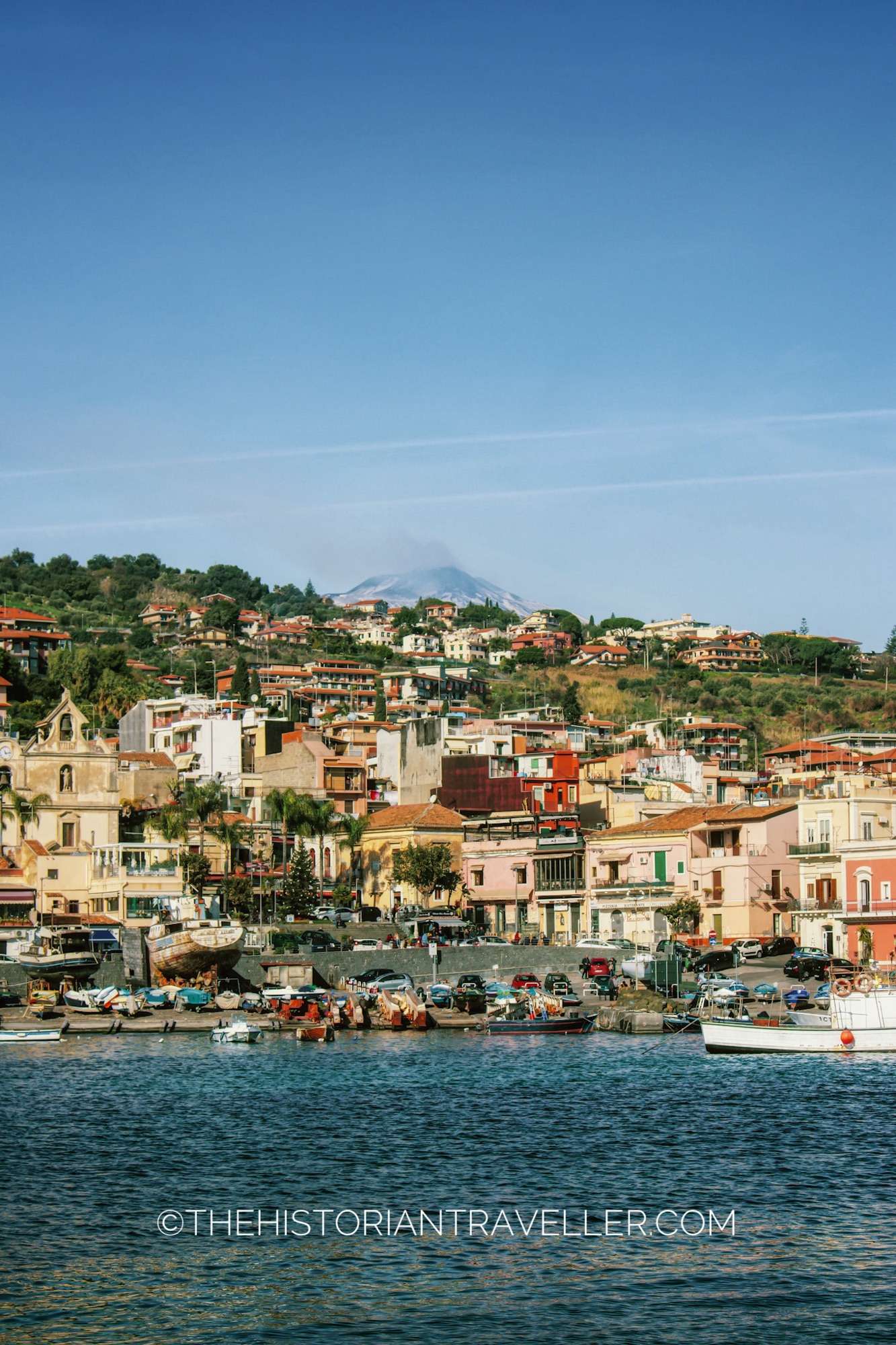
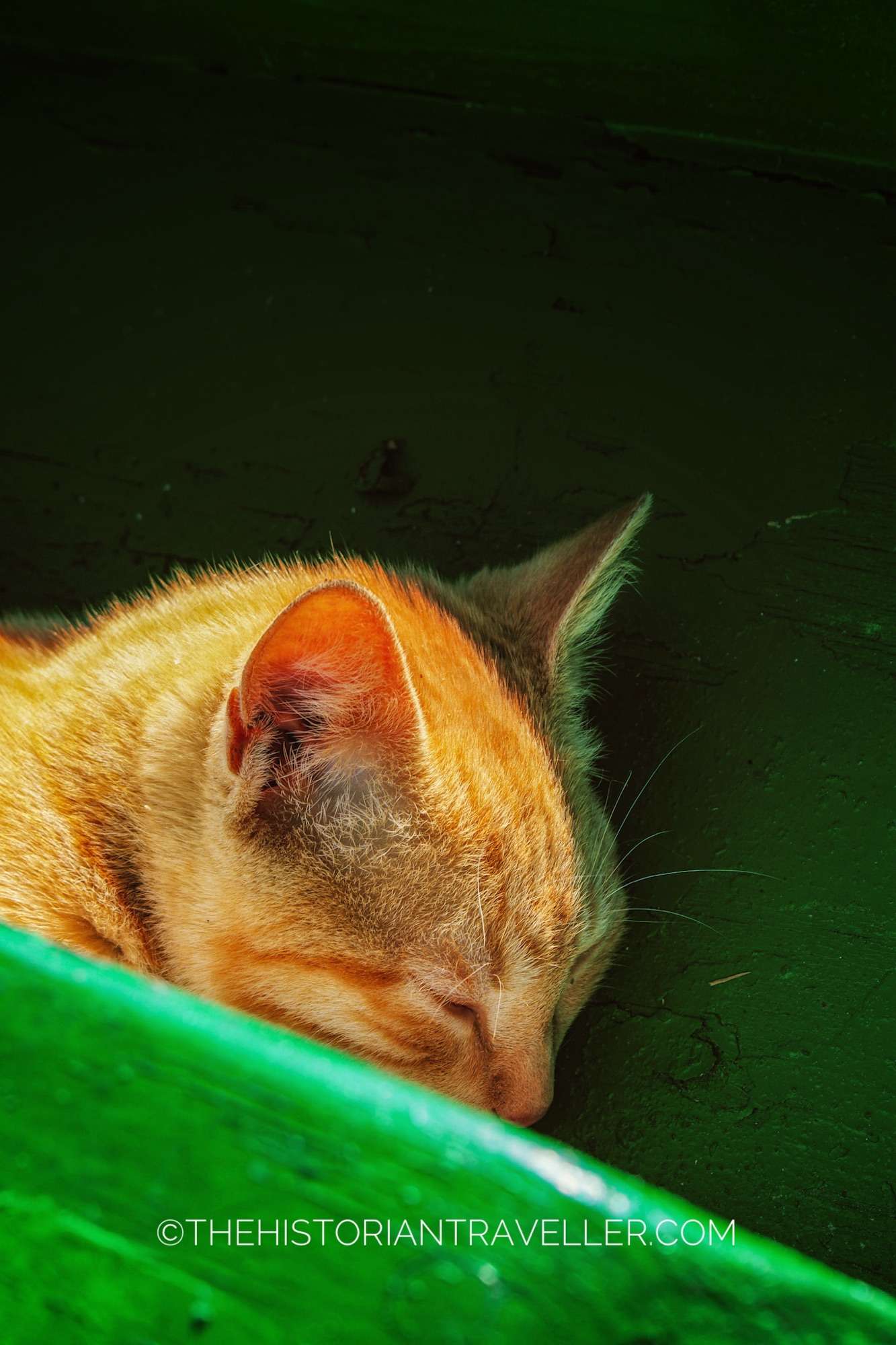
At less than 3 minutes by car from Acicastello, the town of Acitrezza boasts the most famous sea promenade in Catania and the unique Riviera dei Ciclopi. The name came exactly from Homer’s book “Odissey” and the famous part of the narration in which Ulysses and his men try to escape Polifemo’s cave after blinding him. Raging with anger the Cyclops throw at them giant rocks towards the sea trying to hit them. Those exact rocks appear to be the Faraglioni of Acitrezza. Peculiar volcanic formations emerging from the shores that make this part of Catania quite unique to see. Acitrezza is just a small part of the Riviera dei Ciclopi, which extends for about 12 km. It’s a great spot to visit at any time of the day and during the night (particularly at summer time) it’s very lively and full of pop-up restaurants and beach clubs.
A few worthy mentions to keep your eyes on while strolling around are the Faraglioni rocks (of course). You can also visit them with a short and inexpensive boat trip from the port (not recommended with bad weather). The trip will take you also to the small Lachea Island which is accessible only by boat. The hidden basaltic columns in the port of the city. These are totally similar to the ones you can see at the Giant’s cause in Northern Ireland. The House of Nespolo. Famous from Verga’s book I Malavoglia.
A favourite spot of mine for lunch or dinner is Ristorante Pizzeria Lachea. Because me and my husband originally fell in love why on a walk in Acitrezza, we like to celebrate this historic moment with a night out here every year. Pizzeria Lachea is our place for a date night. Their pizza is great and we love the small terrace with a view on the port. Moreover, if you happen to visit Acitrezza on 23rd or 24th June the city celebrates the Feast of the Patron St. Giovanni. The pizzeria’s terrace is perfect to watch the firework display they do in occasion of the celebrations.
Swimming in Acitrezza
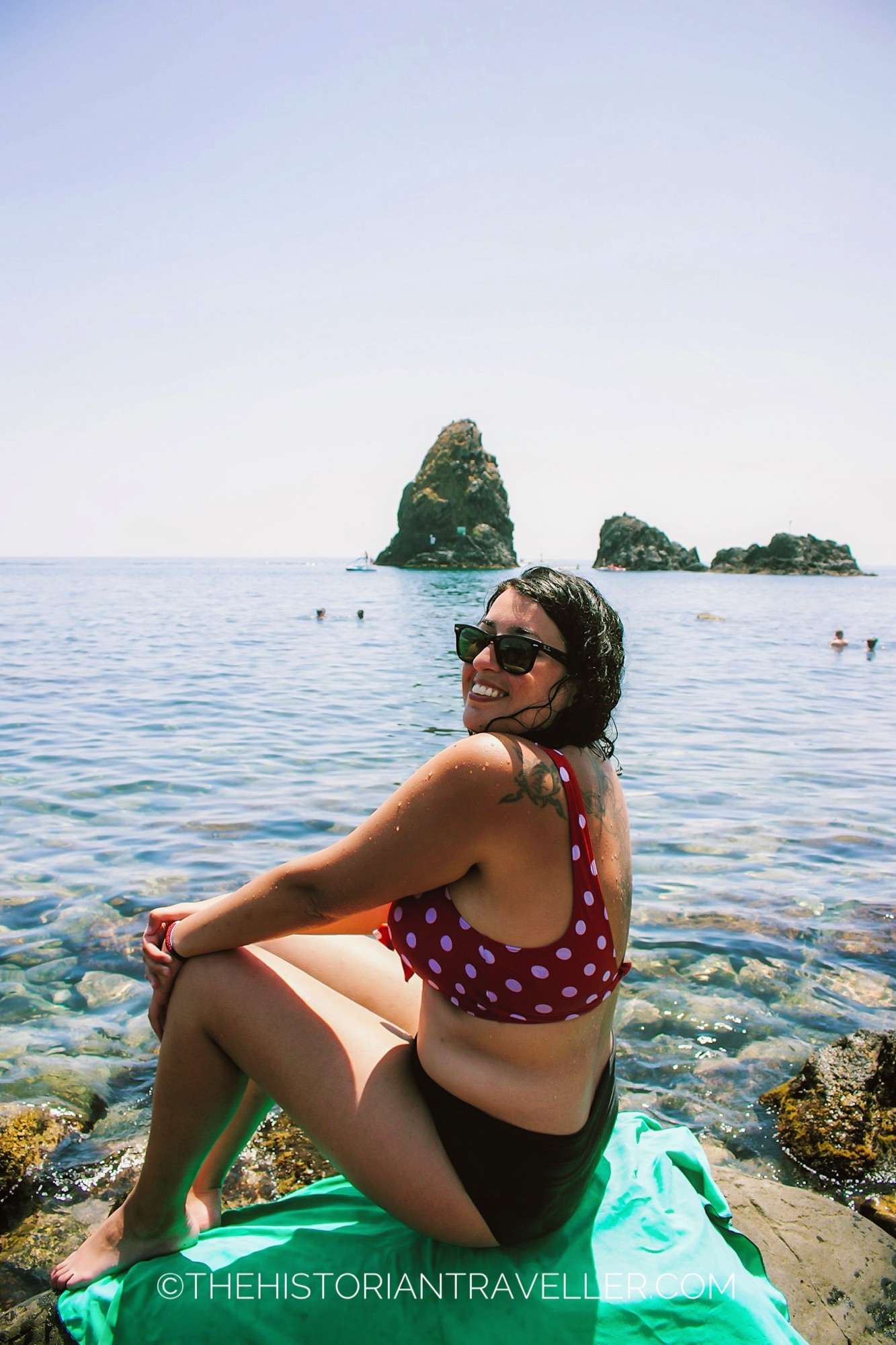
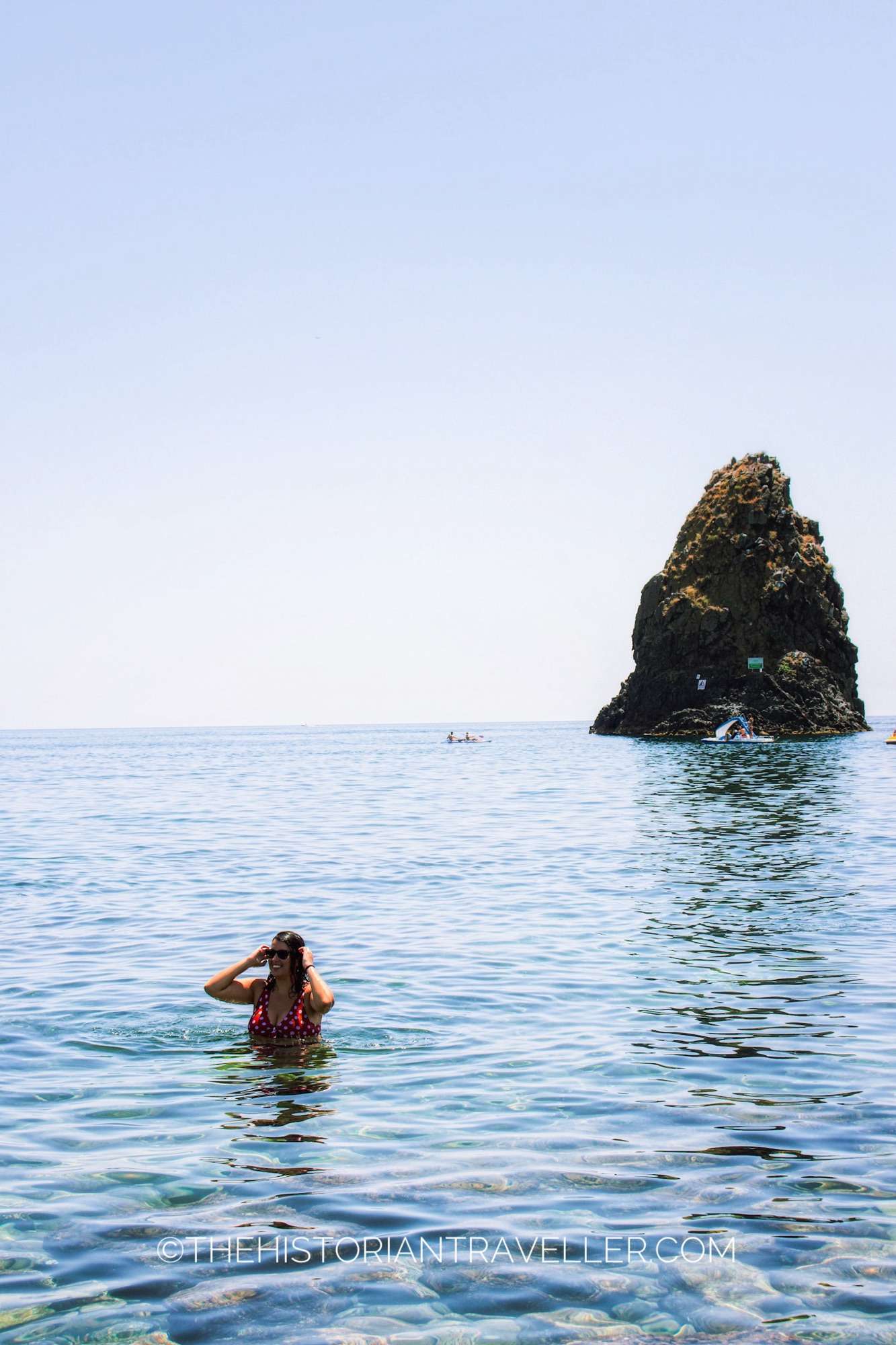
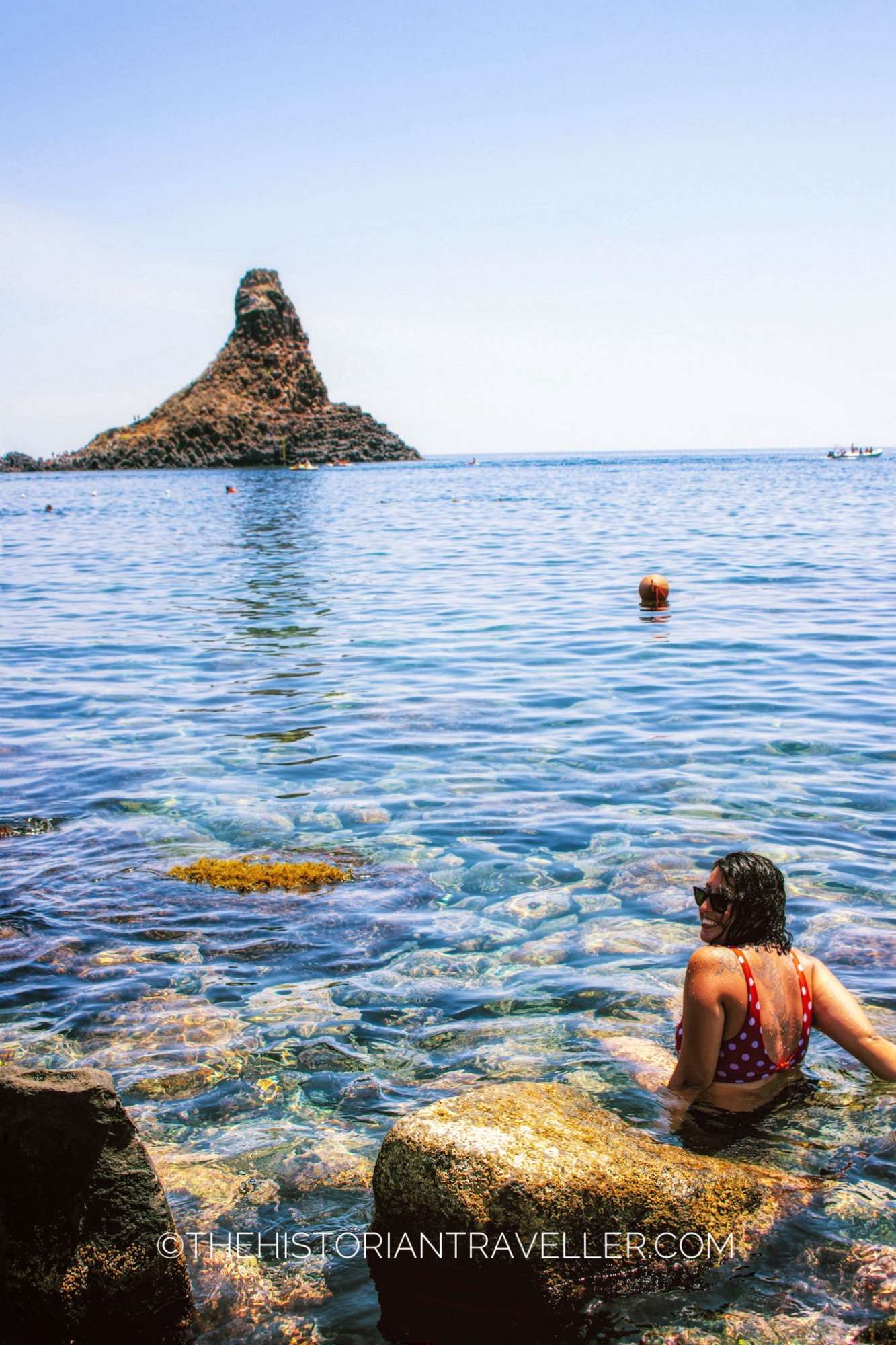
Swimming in Acitrezza is possible and fun. There are several spots where you can just pop with your beach towel and head directly to the sea. I would avoid the area very close to the port but close to the Faraglioni rocks is the better spot. Arriving early in the morning will grant you a better experience as the shores are empty of people (except for a few locals) and the waters are often very clean. Our morning routine is arriving there between 8.30/9 am have a lovely long swim, dry up and then head for a filling Granita at Eden Bar or Mythos.
How to get to Catania northern coastal areas
The better way to reach Catania coastal areas is having a car. This will save you a lot of time while moving between the places and gives you more freedom if you want to add some additional places. Nevertheless, if you are moving with public transportation, there is just one public bus connecting Catania to Ognina, Acicastello and Acitrezza. This is the AMTs Linea 534. The best choice to get a seat on the bus is taking this from its departing point in Piazza Borsellino. To note this line if often very fully and it will take a good hour to get to your destination.
Tourists can be a little confused on where to stop to visit each area so I hope the table below can help you with the stops!
- Catania to Ognina/San Giovanni Licuti – Stop n.214 in V.le R. Di Lauria f/te 59 ( P.zza Tricolore ). From here you can easily walk to the Ernesto (for the granita) and San Giovanni Licuti (5 mins walk). Y
- Ognina to Acicastello. Take the bus in the same stop you got off at Ognina. In Acicastello get off at Stop n. 496 Acicastello ex Cap 334. The stop is just in front of the square where the castle is.
- Acicastello to Acitrezza. You can jump on the bus from the same stop you got off or if you have walked quite a lot and don’t want to head back, you can take the bus at Stop n. 1663 Via Re Martino 2. When in Acitrezza you have to get off at Stop n. 1661 – Via Provinciale f/te 94 (Cap. Acitrezza). This is the last stop of the route and you have to get the bus back at this stop when heading back to Catania.
Bus tickets fare and how to buy them
For more details on the stops, time table and map you can have a look at the AMTS website. I would recommend doing a day ticket (biglietto giornaliero) at €2,50 as the single ticket is valid just 90 mins. Apparently, you can now do also your tickets online with the AMTs app. You can download this at both Apple Store and Android. Not sure this is reliable as I never take the bus in Catania but it’s worth a try!
Catania Tourist Map
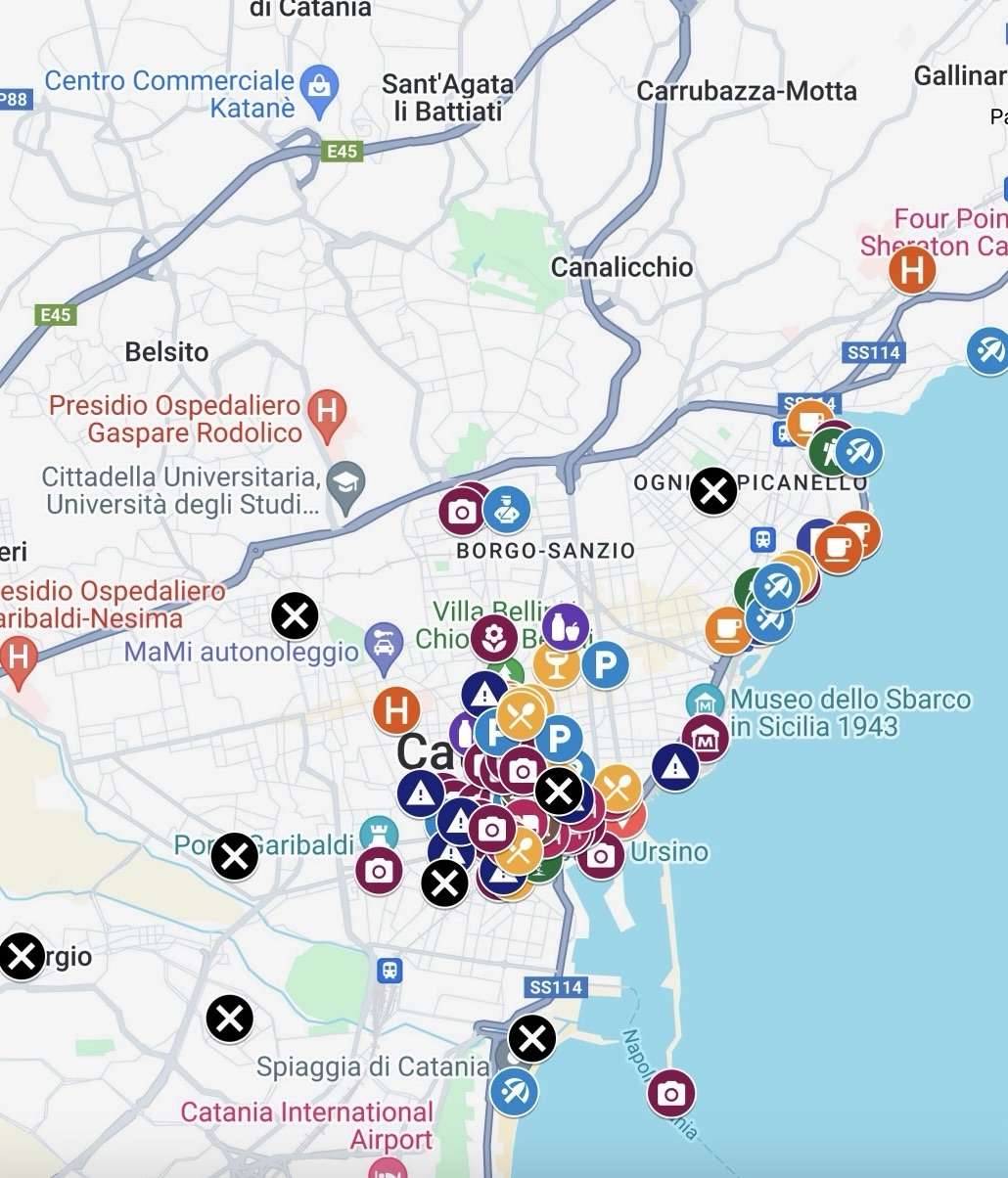
Do you want years of my knowledge on the palm of your hand? My essential tourist travel map of Catania is your perfect travel companion. This includes each single location I talked about in this blog, all my favourite restaurants, cafes and street-food locations, all the beaches you can visit, no-go areas and much more. You can access this via The Historian Traveller Shop!
Catania the queen of street food

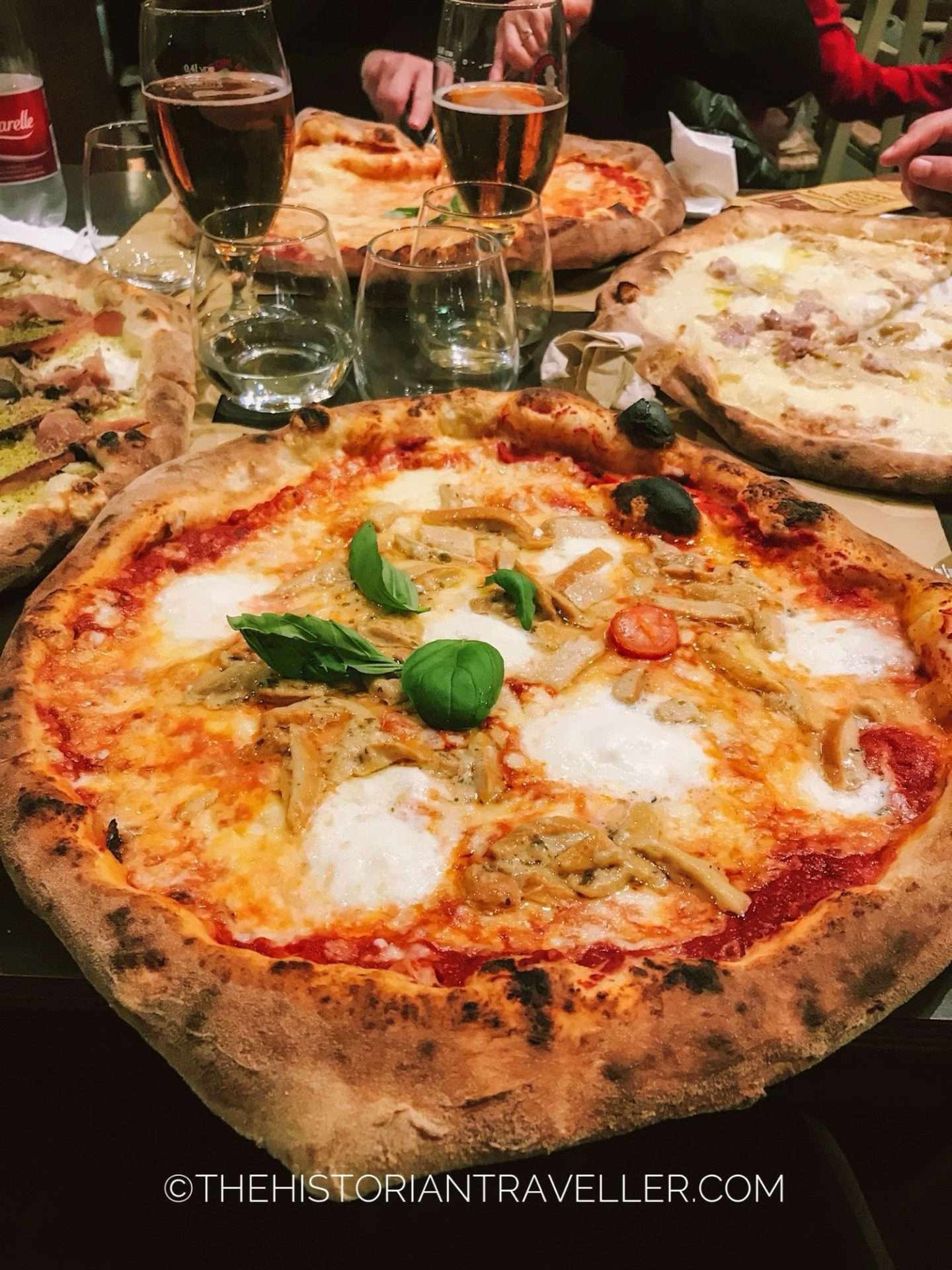
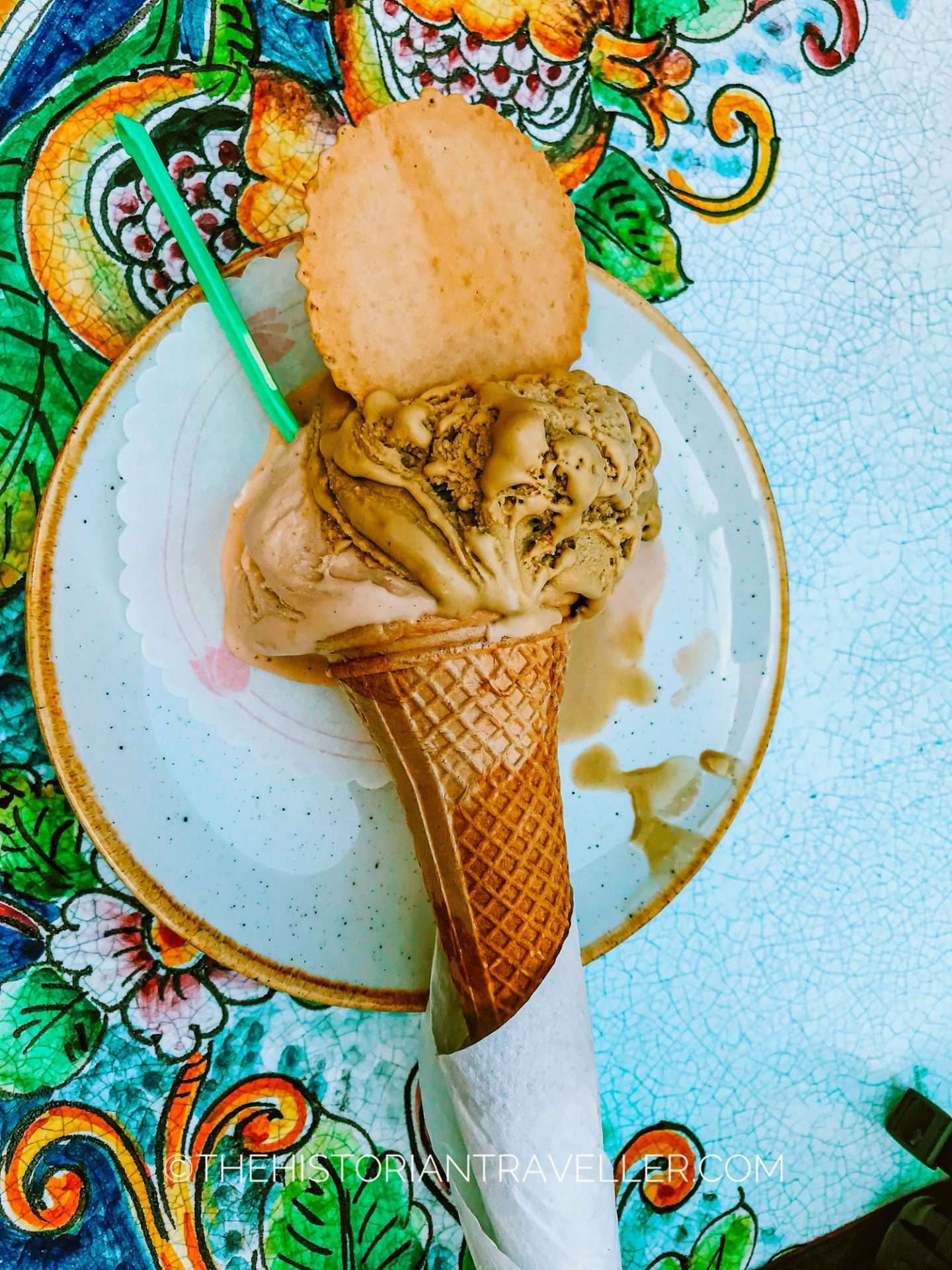
When it comes to food, Sicilians are quite unbeatable. I always feel like I gain 5 more kg every time I visit Sicily, and for a good reason. Food is wherever you look and it’s absolutely DELICIOUS. It’s really hard to find a place where the food sucks in Sicily. Above, I suggested you some of my favourite places to check-out. However, the reality is that many many places have excellent and fresh food and you won’t be disappointed almost anywhere you go.
Something you will definitely notice is the many pop-up restaurants, kiosks, small shops and stalls selling food on the street. This because Catania has a deep street-food culture that goes on from much before this became a trend on social media.
Indeed, during my teenager nights out, having street food combined with a night activity (e.g. cinema, going at the club etc.) was the most inexpensive way of having fun with my friends. I literally grew up with street food and still now it’s the most comfortable food you can have when no one wants to cook at home.
But before eating your way around the city, is better to know some essential information that can save you a lot of time and avoid you getting lost in translation.
A food glossary in Catania.
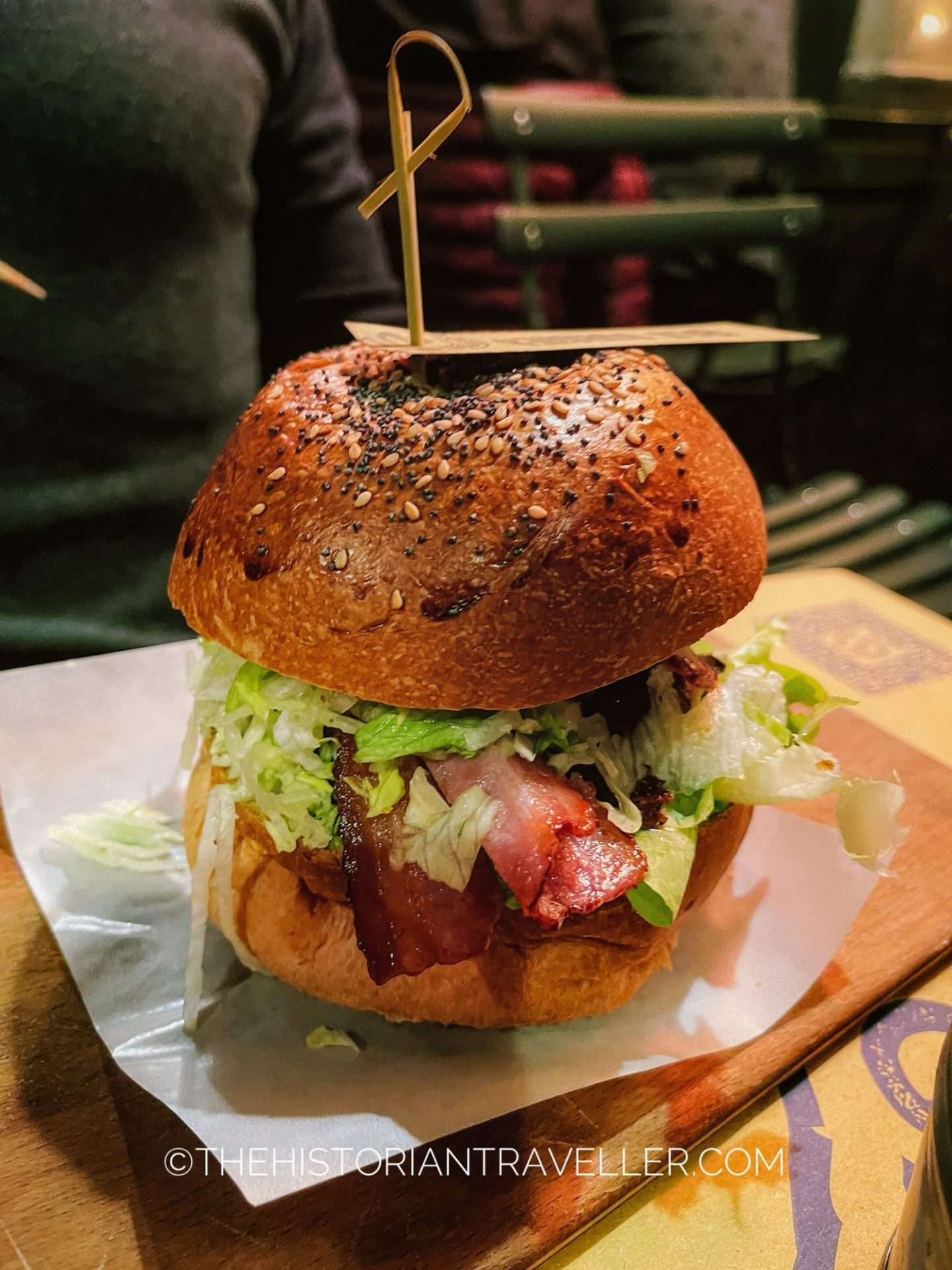
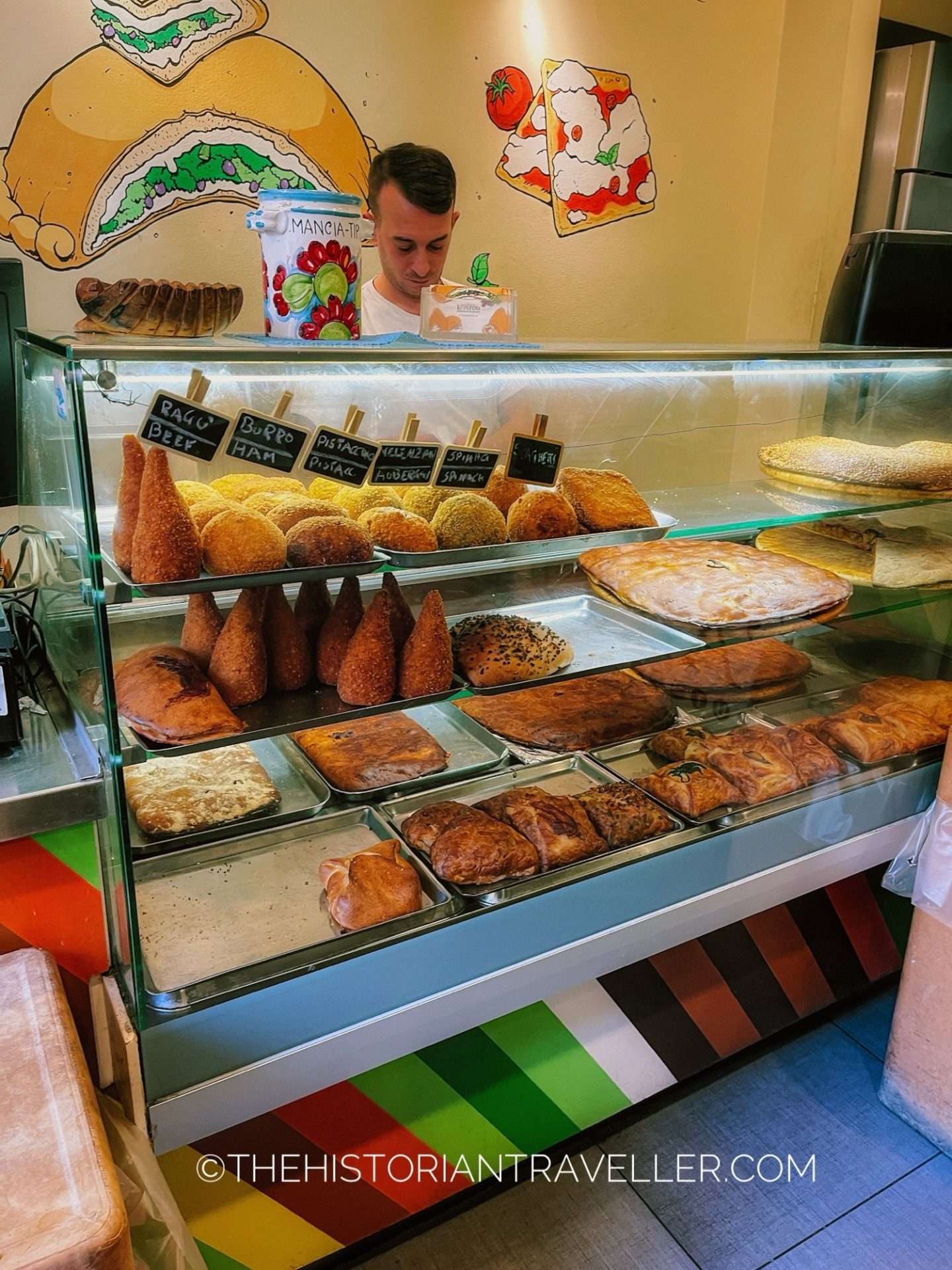
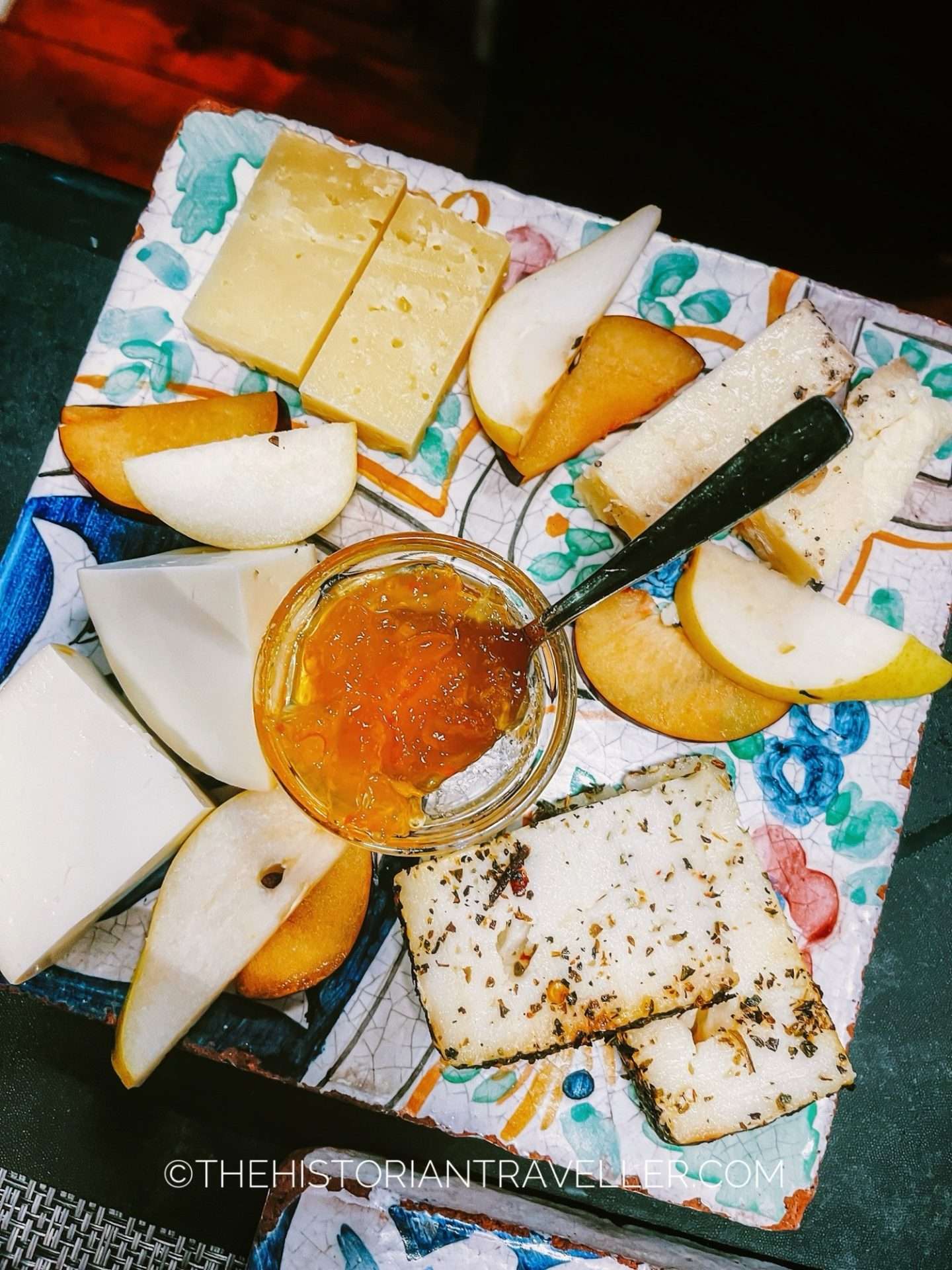
Food for Catanese people food is a reason of life. Street food, in particular, is an essential part of Catanese people’s daily life. I don’t know how many times I had a cartocciata while walking on a random street. Nevertheless, there are so many different options that from a tourist perspective (particularly when facing the dialect terms) this can be overwhelming. To navigate the myriad of terms, food places and customs of Catania, I created a small glossary which will help you decipher a small part of our culinary world and how/where this is served.
- Bar. While worldwide this is synonym of a place selling alcohol. In Sicily a bar can be translated with the word cafe’. Here you can find the famous tavola calda (see the description below), drink coffee, and in certain bars even Granita. Bars can be very small (i.e. standing orders) or you can seat at a table (with or without service). You can use them for breakfast, a midnight snack or your espresso after lunch.
- Cocktail Bar. Differently from the simple bar. Here is where the alcohol is served.
- Paninaro. A small van selling hot panini with the most amazing fillings at a very cheap price. A very popular panini is the hot-dog with mozzarella and fries. However, you can basically put inside a panino even the whole menu without paying more than 5 euro.
- Tavola Calda. These are savoury pastries served as take-away street food or to be eaten right on the spot. Tavola Calda include the following items (arancini, pizzette, cartocciate, cipolline, bombette (fried or in the oven) etc.). Tavola Calda (or Gastronomia) can be also the name of the place selling the above. These are very inexpensive but delicious (1-3 euro).
- Panificio. A bakery selling fresh bread all-day long and sometimes also cheap pizza and tasty treats.
- Arancineria. A place selling exclusively arancini. Ps: to note that you call it Arancino in Catania and Arancina in Palermo. Don’t make any gaffe.
- Canni Cavaddu (Horse Meat). It’s a speciality of Catania and is often served as a street food, sometimes in form of meat balls, sometimes grilled. The best place where to find this is Via Plebiscito.
- Arrusti e mangia (grill and eat). Traditional way of eating grilled meat while is just taken off the grill. Catanese people love to do arrusti e mangia picnics, particularly on Easter Monday.
- Chiosco (or in dialect Ciospu). A small Kiosk serving only fresh drinks that Sicilian simply call as Selz. Most popular Selz to order are: Selz Limone e Sale (sour), Limone al Limone (sweet), Mandarino al Limone, Misto Frutta, Tamarindo, Orzata and Zammu‘. Nevertheless, if you want to behave like a real Catanese, after a big meal or a late night out you have to pop in Piazza Trento’s Kiosk for a Frappe’ alla Nutella. This is probably the most delicious thing you’ll try, but your throat will burn like hell. Therefore, it’s better to split this in two with someone. Piazza Trento Kiosk is not the only one doing this but it’s the one who patented the recipe. therefore is the best in the city!
- Granita. Similar to gelato but less dense and with NO milk. This traditional Sicilian dessert can be eaten with a brioche as a spoon (classic way) or with a proper spoon. Obviously the original brioche that is served with granita is the Brioscia ‘ko tuppu (a brioche with a hat).
- Zeppole/Crespelle di Riso. Deep fried rice fingers with honey sauce. These is probably the most famous street food dessert in Catania. I love them particularly during winter as they are served very hot. There is a savoury version of the Crespelle called “Crispeddi anciovi e ricotta” aka Crespelle of ricotta and anchovies. The stalls selling the rice ones usually sells also this variant.
- Mauru. A sort of algae which is traditionally consumed raw with lemon juice. You can find this at the fish market a Piscaria.
- Minne di San’t Agata (St. Agata’s breast). Breast shaped sweet pastries called with this name in honour of the Saint who lost the breasts during the torture.
- Cannola (i.e. Cannoli). Worldwide famous dessert that originates from Sicily and widely sold in every bar in Catania. It’s a hard pastry with different fillings. Traditional Sicilian cannoli are made only with ricotta and chocolate.
- Capuliatu. Very hard-to-pronounce name for a condiment made of dried, minced tomatoes often used for pasta or as a filling for vegetables/meat.
- Pani Cunzatu (i.e. Bread with condiments). A type of sourdough bread with the shape of a big donut served warm and filled with different type of condiments and spices. This is often home-made or sold at the side of different streets nearby some bakeries.
Best day trips from Catania
If you want to explore Sicily a little bit further, Catania is an excellent base for your day trips. Nevertheless, to venture out of the city, I do recommend hiring a car as most places are not well-connected by public transport. Moreover, this will help you if you have only a few additional days. Here below you will find three best destinations that you can visit from Catania on a day trip.
Taormina and Isolabella
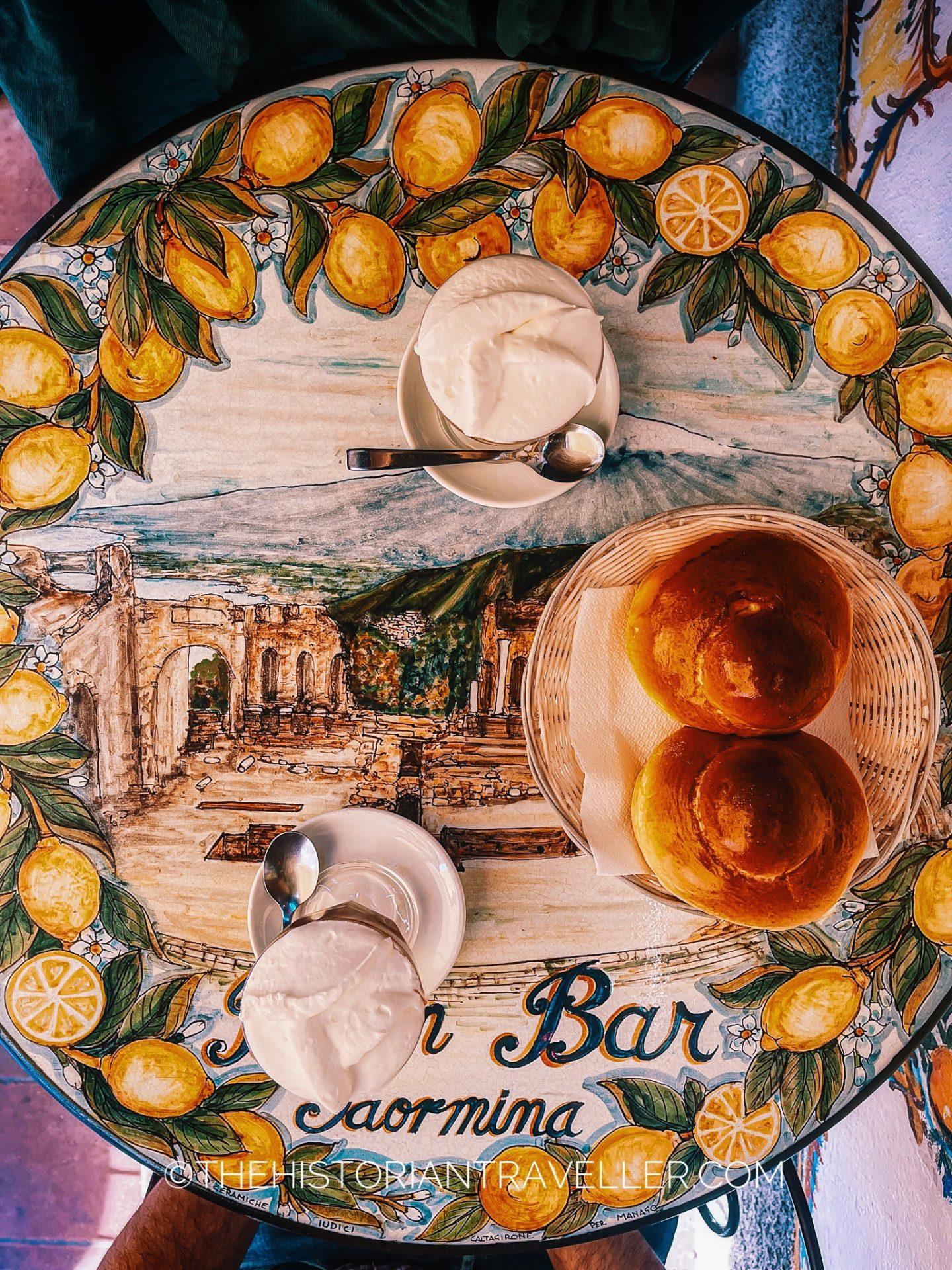

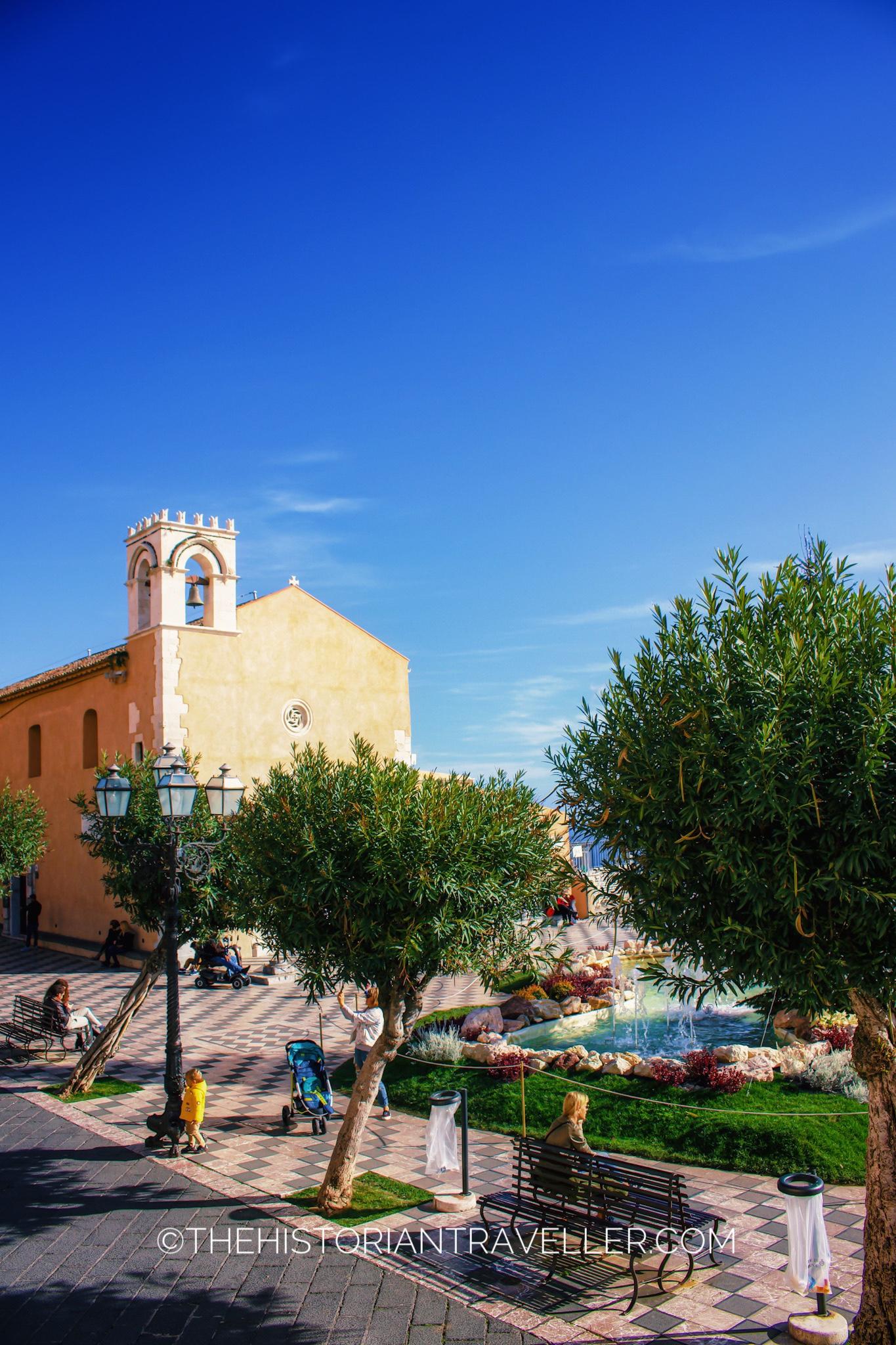
Distance from Catania 56.2 Km – Driving time: 44 mins
Taormina is probably one of the best day trips from Catania due to its close proximity. In fact, despite the city is “technically” in Messina, it’s actually at less than 1 h from Catania.
Taormina has recently received a lot of media attention after making its international debut in the HBO’s tv series The White Lotus. However, Taormina has always been a popular hot-spot in Sicily. Indeed, prices are a little higher than other places and everywhere you look feels out of a movie scene.
Taormina can be visited in one or two days. Unmissable sights are certainly the Ancient Theatre, the Villa Comunale and the beautiful Piazza IX Aprile. Don’t miss a granita stop at the famous Bam Bar.
If you want to discover more of Taormina, read my Insider guide!
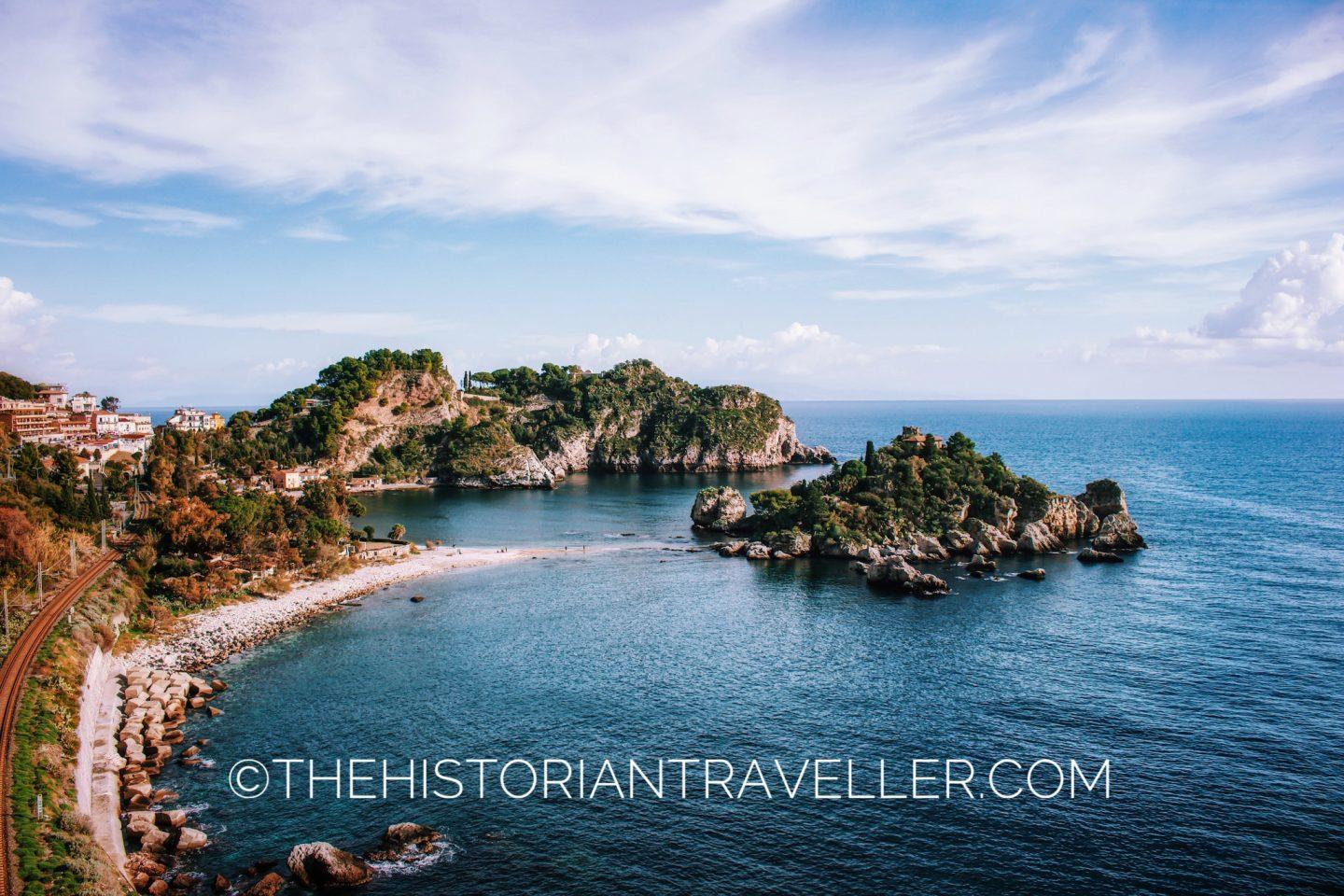
If you have some additional time to spare, Isolabella is certainly worth a visit. This is located right down under Taormina and can be easily visited via the cablecar connecting the two places. Isolabella is best appreciated during summer as you can make use of the lovely beach and visit the little island hosting the Museum and Botanical Garden.
TIP: if visiting during summer, be sure to get a spot on the beach very early. Usually, this becomes completely full by 10.30 am
Mount Etna
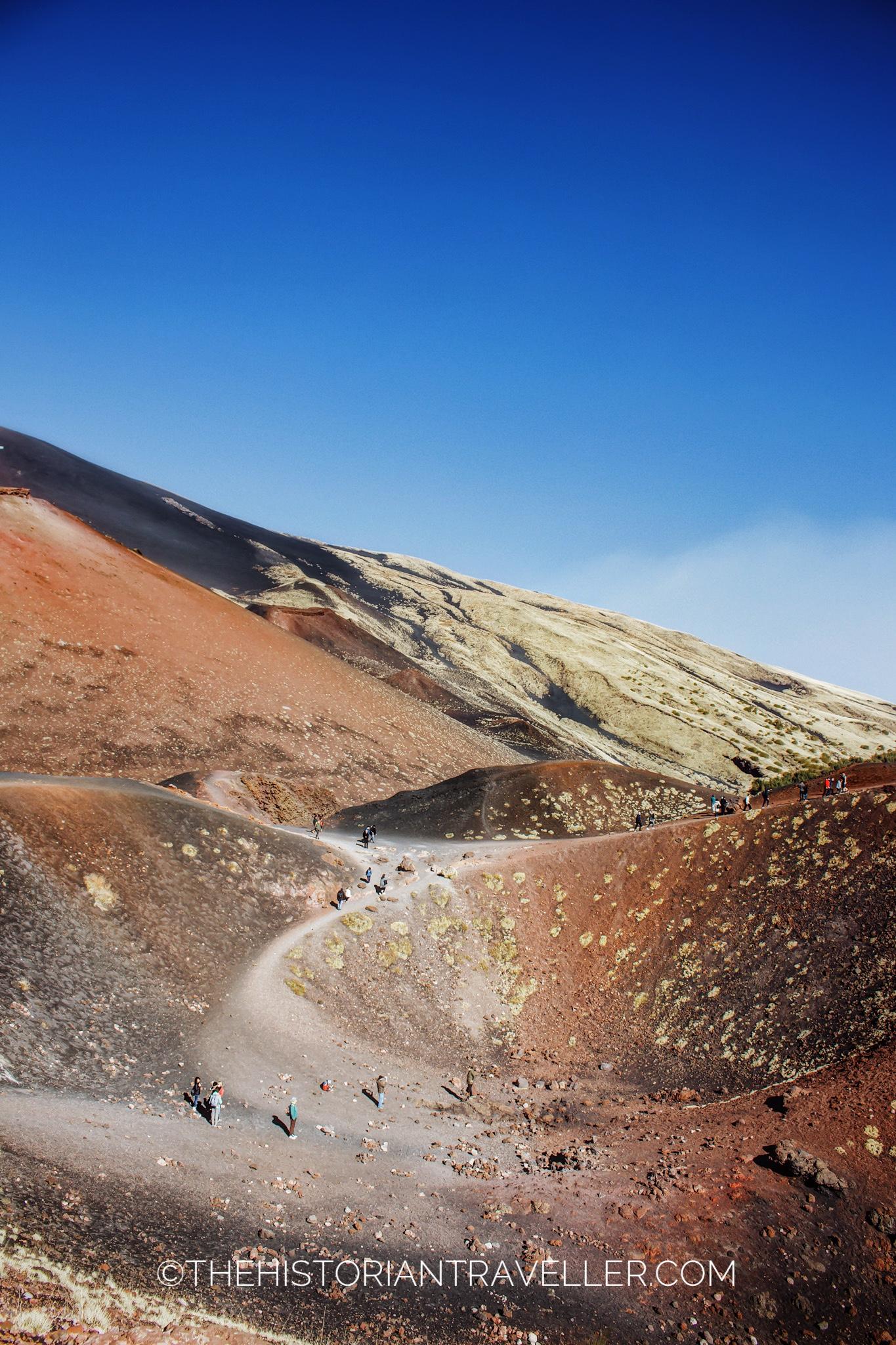
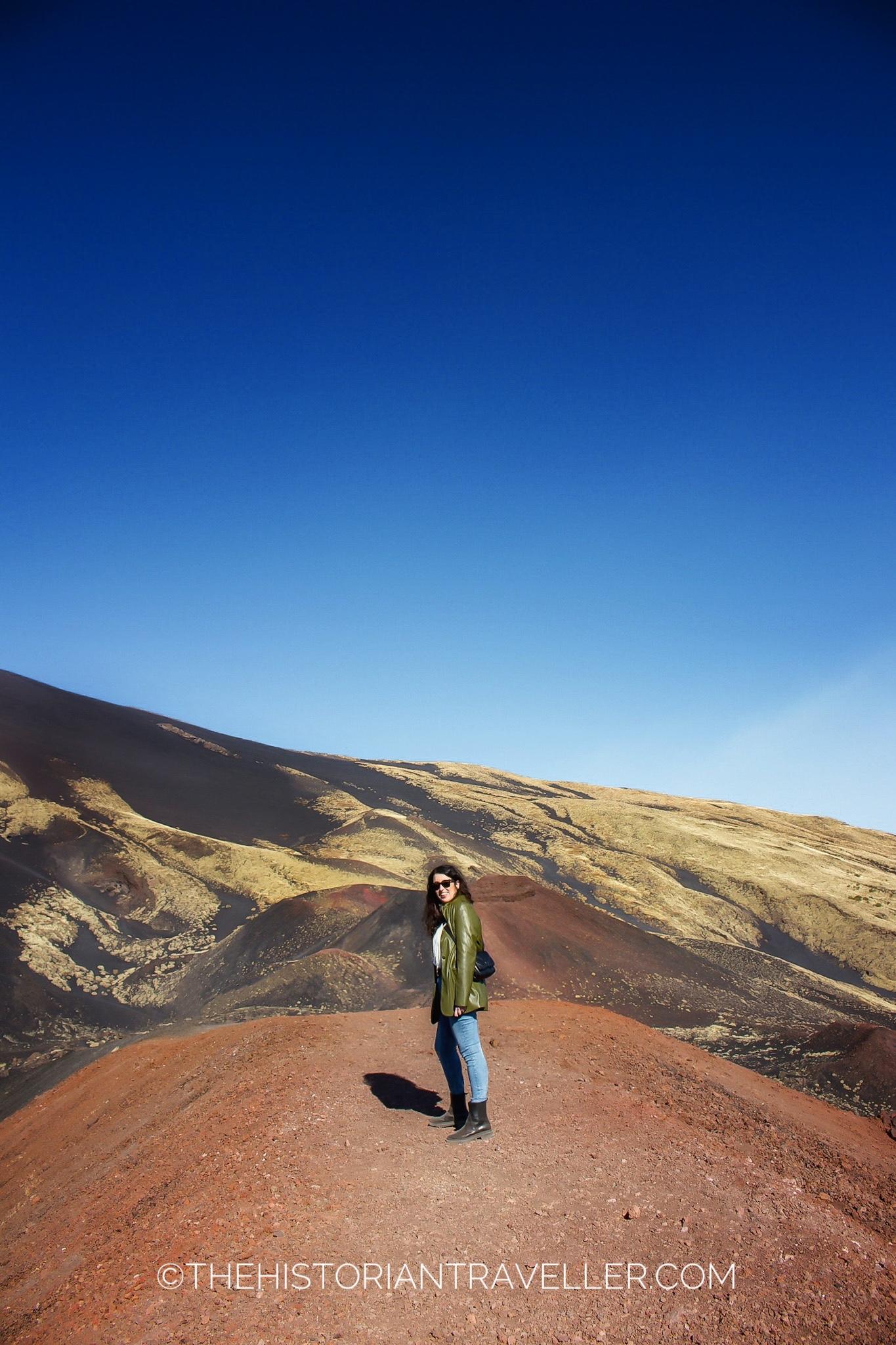
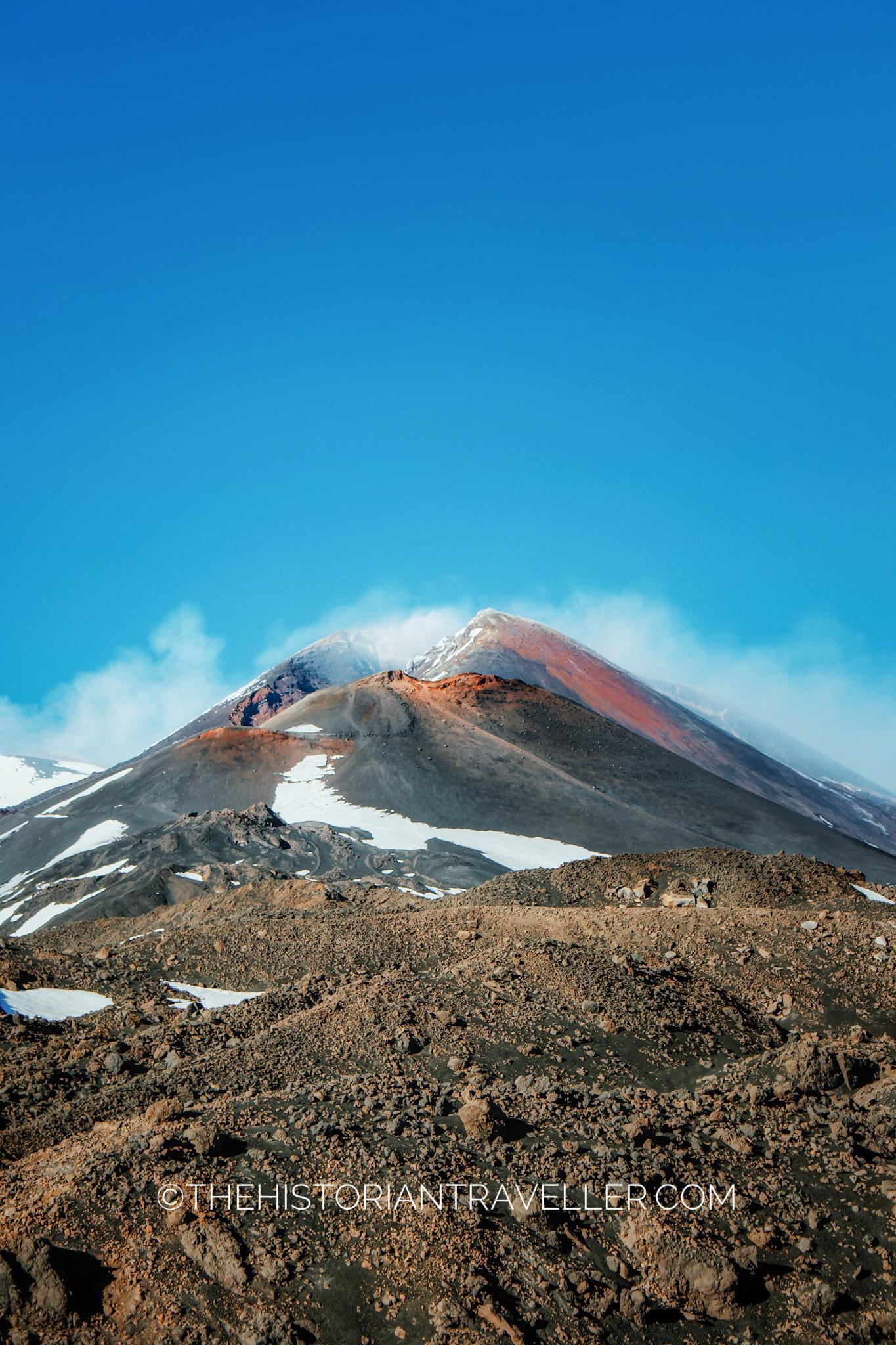
Distance from Catania 34.8 Km – Driving time: 50 mins
Visiting Mount Etna is actually easier than you think. Indeed, Catania is right under it!
Despite being always very active, Mount Etna is a relatively easy and safe to explore volcano. Indeed, it is constantly monitored by volcanologists and, in case of too dangerous activity, it’s promptly closed to tourists (and locals). Don’t be disappointed if your tour gets suddenly cut off due to the volcano activity. This happens often and it’s done for people safety. Better safe than sorry!!
If you want to visit Mount Etna there are several trails you can take but the main ones are the hiking to the Crateri Silvestri and, of course, the hiking to the top Central Crater(s). The Central Craters require at least a half-day trip and some hiking equipment with you like thermal jackets and hiking shoes.
On the other hand, Crateri Silvestri are quite simple to hike (even without technical equipment) and can be done in a couple of hours. One of my favourite day trips in Mount Etna is arriving at Crateri Silvestry by 11 am, have a short hilke (1-2 hours), then get down for lunch in one of the restaurants nearby. Rifugio Sapienza restaurant is very nice if you want to sit down for a long lunch but there are also some other quicker options all around.
The option for the afternoons can be taking the cable car up to 2,500 meters and have a coffee with a view (yes, there is a cafe’ up there!). Or, returning back to Catania, maybe doing a coffee stop at the lovely Zafferana Etnea.
Syracuse
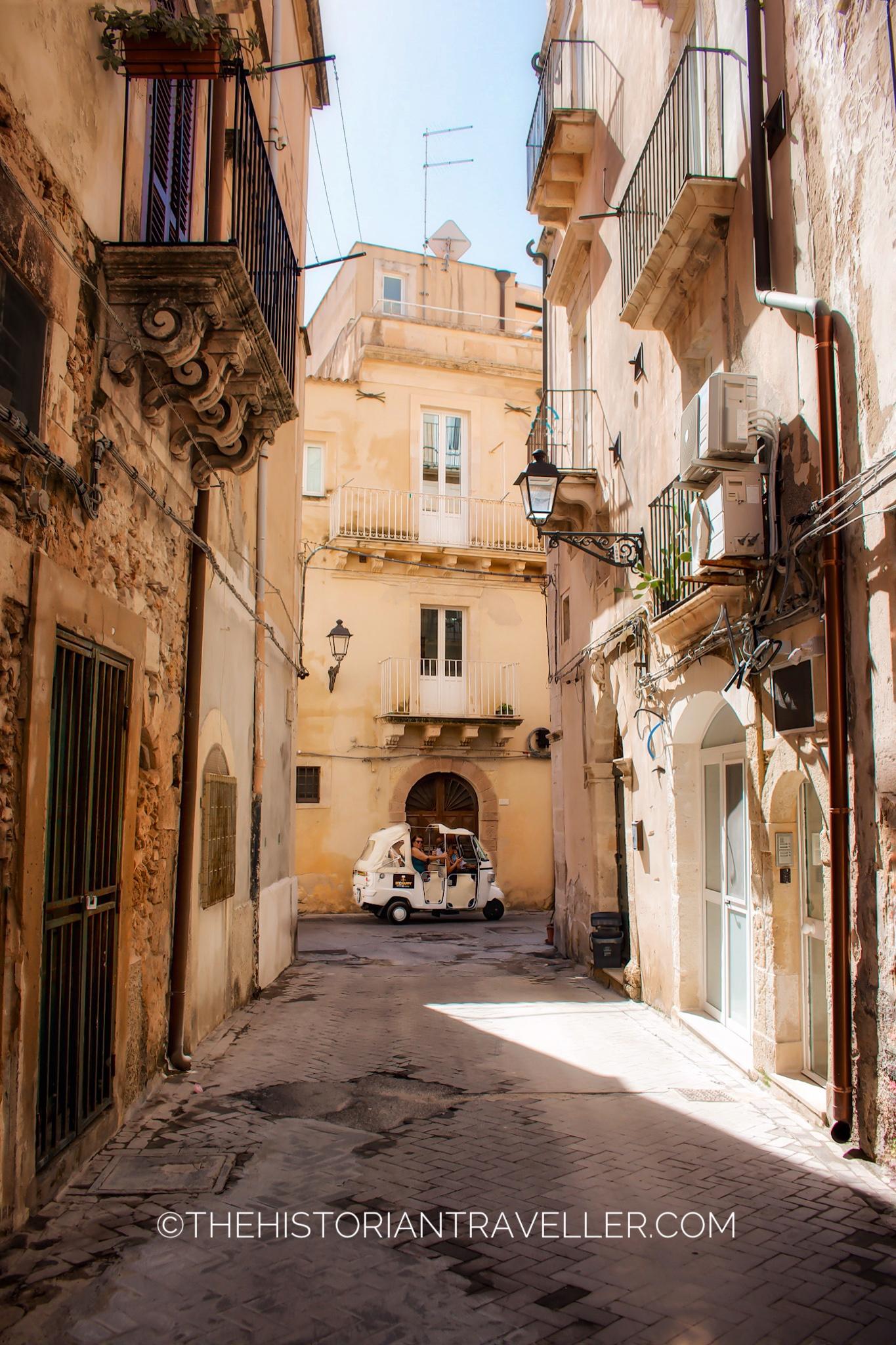
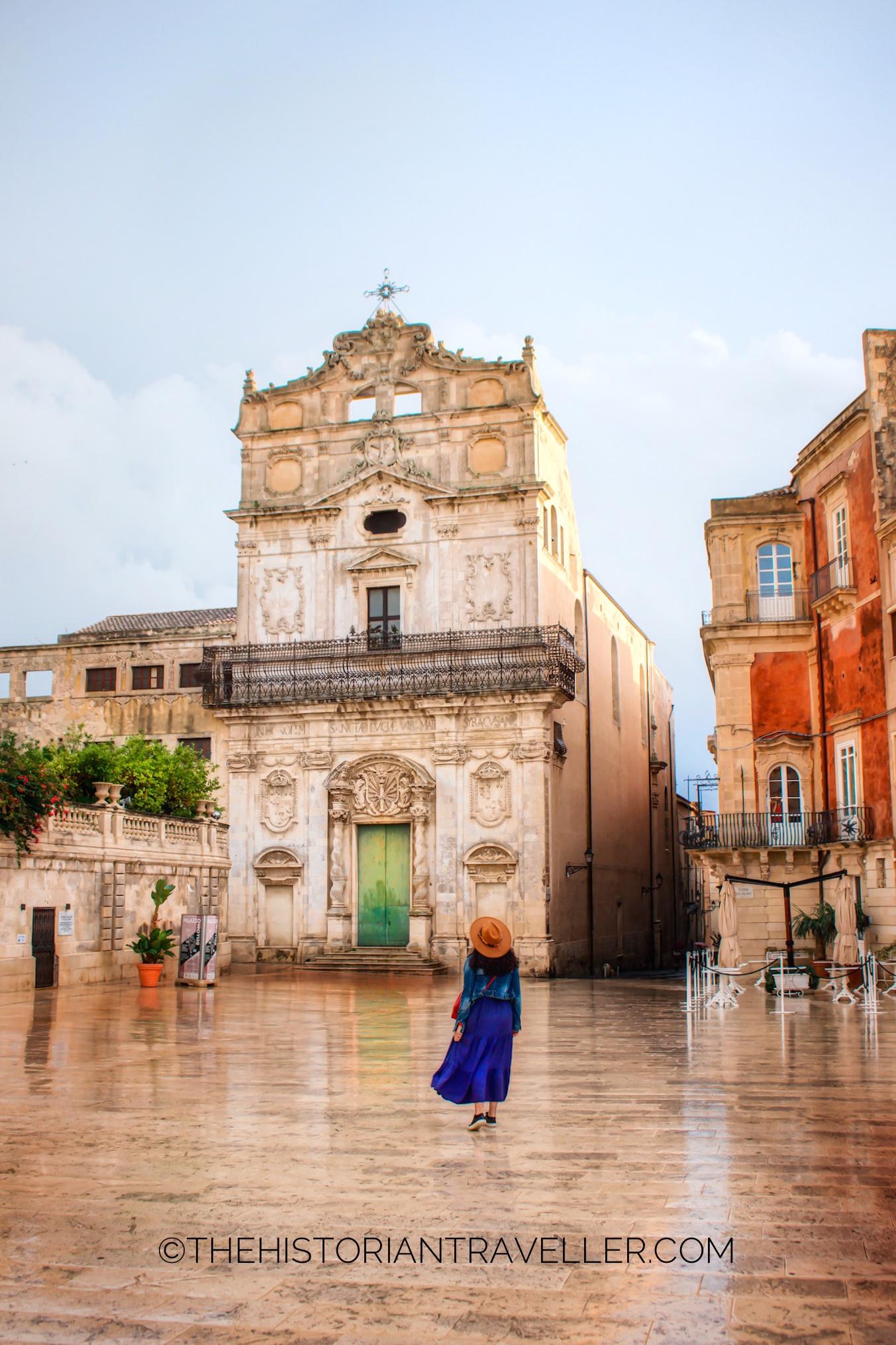
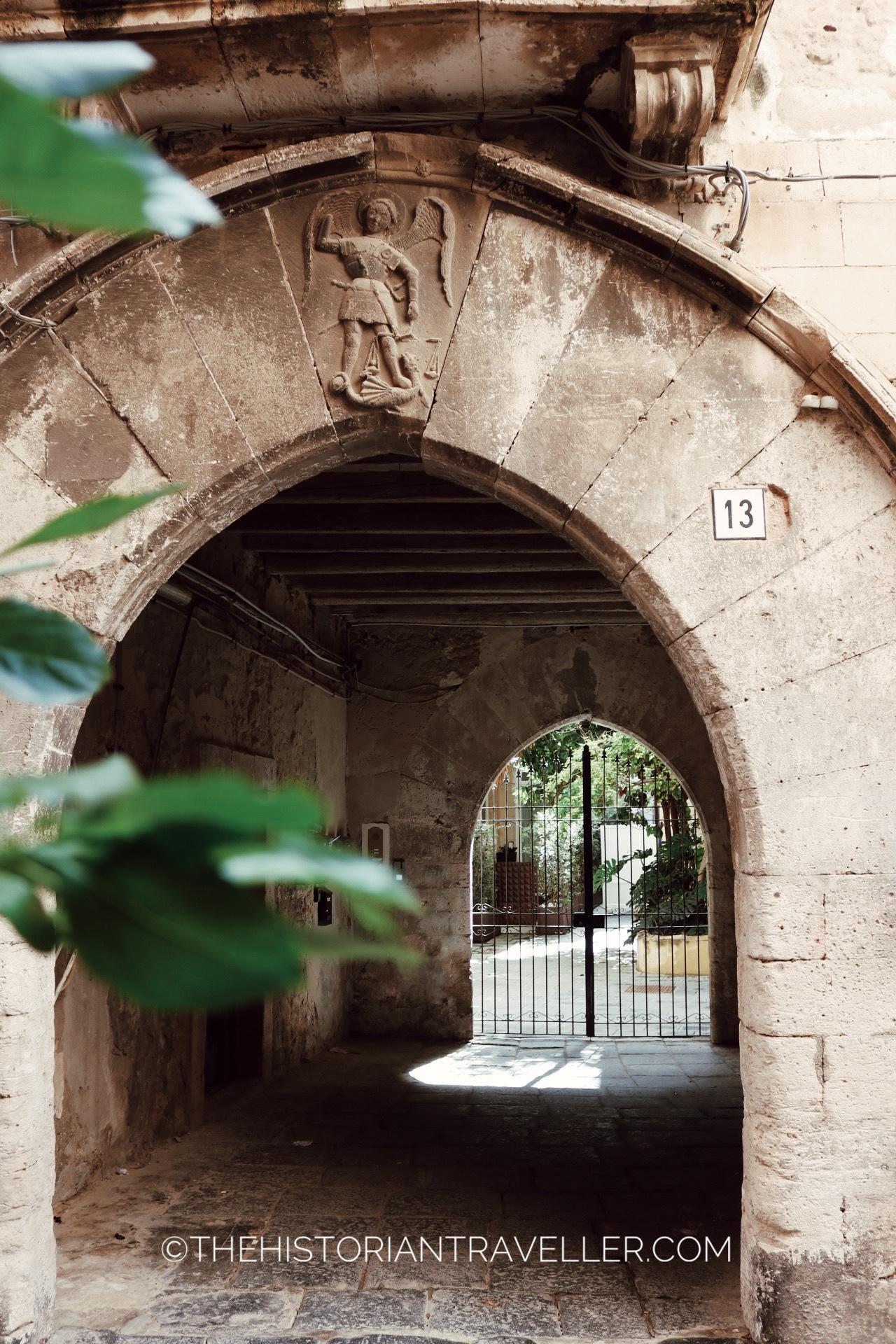
Distance from Catania 66.8 Km – Driving time: 47 mins
There is always a bit of misunderstanding when tourists get to visit Syracuse. Indeed, the city is quite big and might get you confused at first. However, what not many tourists know is that most of the “famous” attractions are not actually actually located on main-town Syracuse but on a small part of the city. A little island called Ortigia. Indeed, excluding the incredible Greek Theatre, the Ear of Dionysius and a few other sites all of what is “touristically interesting” can be found in Ortigia.
I’m not suggesting here to skip the mainland Syracuse. However, if you have a tight itinerary, possibly going there on a day trip, is better to focus on Ortigia and add a few stops out of the island. Of course, if you have a few days to spend in Syracuse you can also add a few significant addictions like the Latomie del Paradiso or the Ninfeo Grotto. If you want to visit one of the most secluded beaches of the areas, head to to the Natural reserve of Plemmirio and search the Pirillina Bay.
Ortigia
Ortigia is, indeed, one of the oldest parts of Syracuse. It was already inhabited since the XIV AD and boasts some well-preserved Greek and Medieval architecture in Sicily. The little island is no bigger than 1 sq. Km but to fully experience it’s essence, a day trip (in my opinion) is not enough. Two days is an ideal amount of time to hit all the attractions and also get a little lost in the maze of its little alleys.
While in Ortigia, make sure to not miss it’s incredible Cathedral. Indeed, despite now it’s a religious site, it used to be a massive Greek Temple (Temple of Athena) of which columns are still well visible on its facade. The Temple of Apollo, is another incredible Greek heritage site, which is still well preserved in the centre of the town. My favourite top sites are the Aretusa spring and its gardens. Indeed, the Gardens of Aretusa feature some monumental Ficus trees, really scenic to see and photograph, particularly at dusk. For a special adventure, don’t miss the a visit to the Hypogeum. A series of underground tunnels connecting one part to another of the island (the exit is indeed a surprise!).
Where to stay in Catania

As one that works in travels for quite a few years now, I have to say that the hospitality sector in Catania (as well as in many part of Sicily) is still in development. The concept of luxury accommodations is still lacking some of its basic concepts and services. Moreover, there is an absurd number of B&B and named “hotels” which are just random houses in the city centre. Because both me and my husband have a whole family who lives in Catania, I can always return to our parent’s homes when I visit. However, when when we want to go for a weekend out, I always have troubles in finding a place I really like because of my standards. I did quite a little research specific for this blog and I manage to find out a few places I liked. However, keep in mind the following:
- Most luxurious accommodations are out of Catania, mostly in the Paesi Etnei (Etna’s small villages). You’ll definitely need a car to reach them unless they have a shuttle service.
- There is a huge discrepancy in prices between top-choice accommodations and medium/low range ones.
- If you have are travelling on a budget and want to opt for a B&B or rented accommodation be sure this is not located in one of the no-go zones mentioned above.
Luxury Accommodations in Catania
Paesi Etnei accommodations
Manifesting here one dream stay of mine, Monaci dalle Terre Nere is high on my list! This exquisite accommodation is located in Zafferana Etnea, very close to Mount Etna. Is famous for being a Eco wine resort located in a carefully restored 1700 mansion. Prices are quite expensive for the area starting at $550 per night.
Another place which is high on my list of accommodations to visit, is the lovely Palazzo Previtera. This is a 1600 house/museum carefully curated in each single detail. Also this place is located near Mount Etna in the lovely village of Linguaglossa. Prices start at $200 per night.
A last place I do recommend, not properly in Paesi Etnei but in a good location to reach both Mount Etna, Taormina and Catania is Donna Carmela Resort. As we stayed here during last visit in Catania, you can read everything about our stay here. Price start at $400 per night in high season.
Catania centre luxury accommodations
If you prefer to stay in the city centre rather than going to the countryside the following accommodations have a more luxurious feeling and perfect location to explore Catania.
Rising in one of the most famous and historical squares of Catania Asmundo di Gisira is the perfect location to experience the Sicilian Palazzo life. Prices start at $200 per night.
Palazzo Marletta Luxury House has probably one of the best view you can have in Catania right on the Piazza Duomo. Located in a historical Baroque Palace, this lovely accommodation has a great potentiality and a perfect location to explore Catania. Prices start at $200 per night. Please note there is another accommodation with a similar name nearby, don’t confuse the two!
Lastly, an accommodation that I recently found and looks stunning is Bastio’ Private Suites. Centrally located too this secluded accommodation offer some special rooms inclusive of lava stone walls and even en-suite hammam! Prices start at $300 per night.
Budget friendly accommodations in Catania
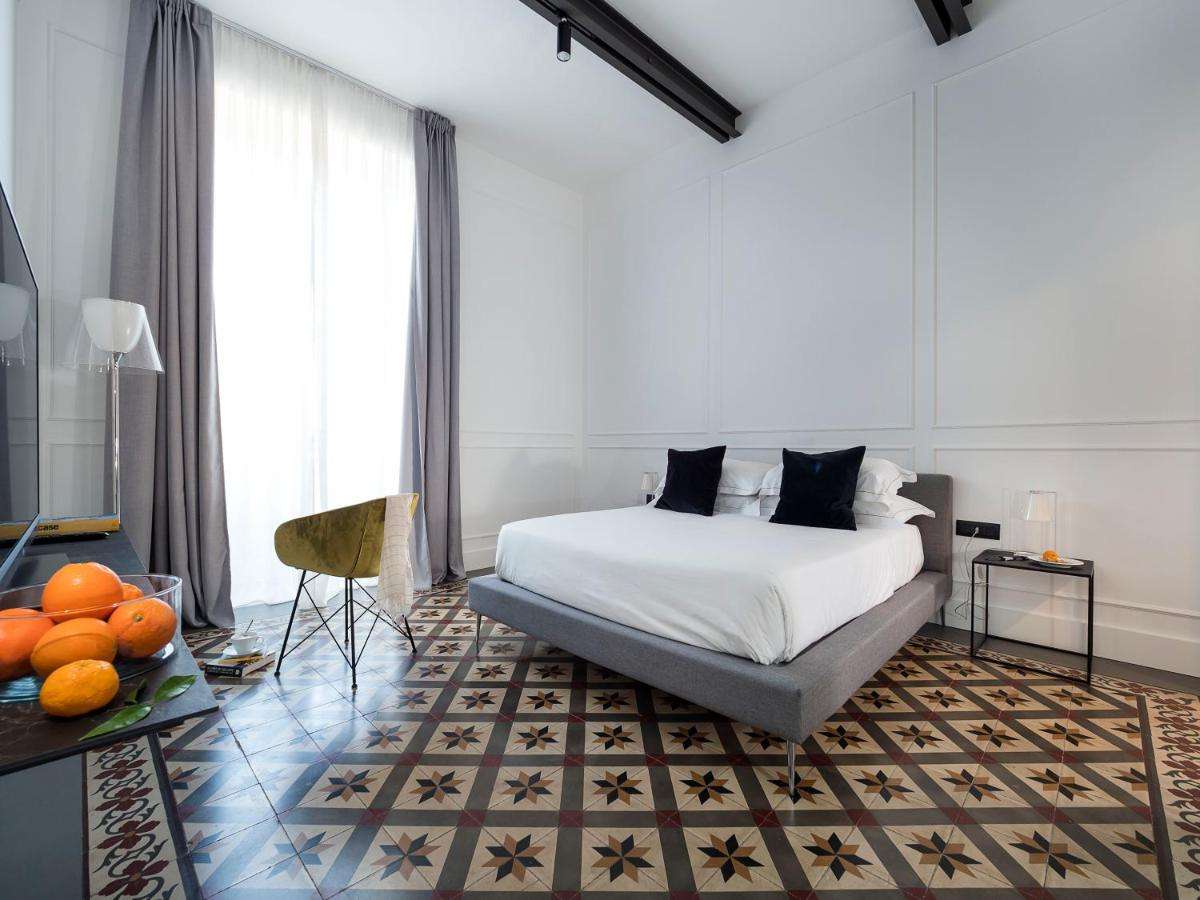
For a more budget-friendly experience but without renouncing to aesthetic and quality, Habitat seems a great option. For a cheaper Baroque palace experience Naca Suite does the job. I’m slightly confused by the jacuzzis next to each bed, but I can forgive this unusual choice for that beautiful ceiling! Moreover, this place has excellent reviews and a very good central location.
Lastly, they have only a few reviews but this B&B called Biscari Home looks very nice and in a lovely location to explore the city! I’m pretty sure they will become soon very popular!
The price range for all the below accommodations is between 100 and 150 $ per night (for a double room).
Plan your trip to Sicily!
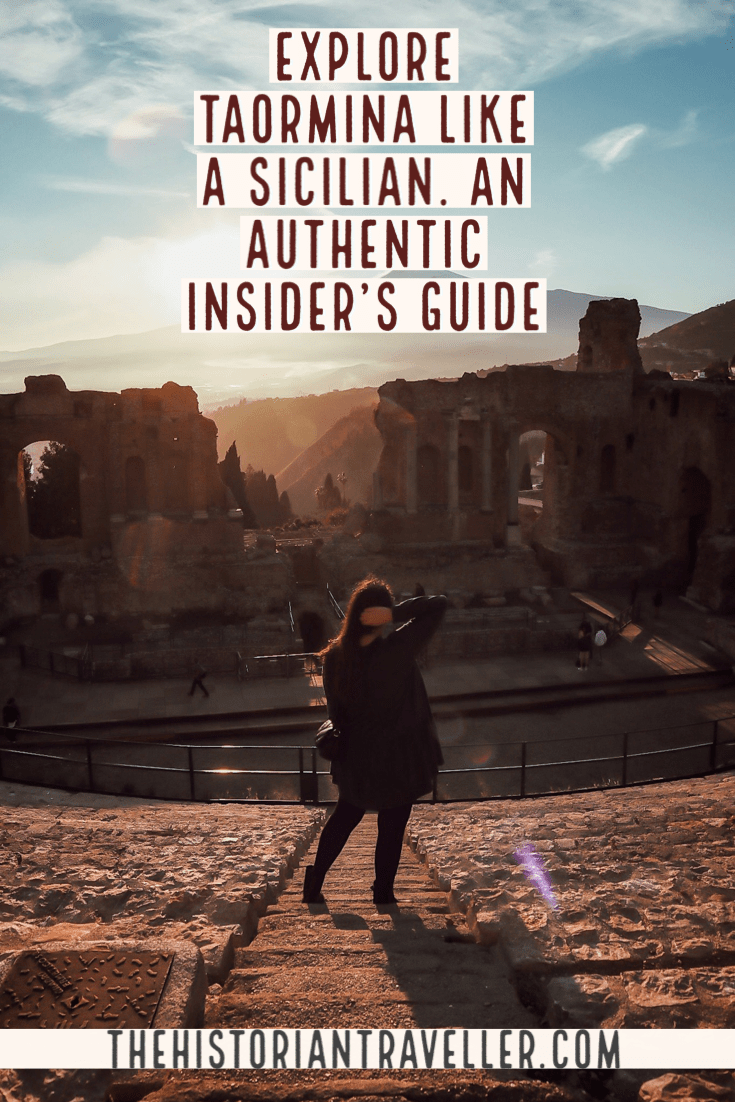
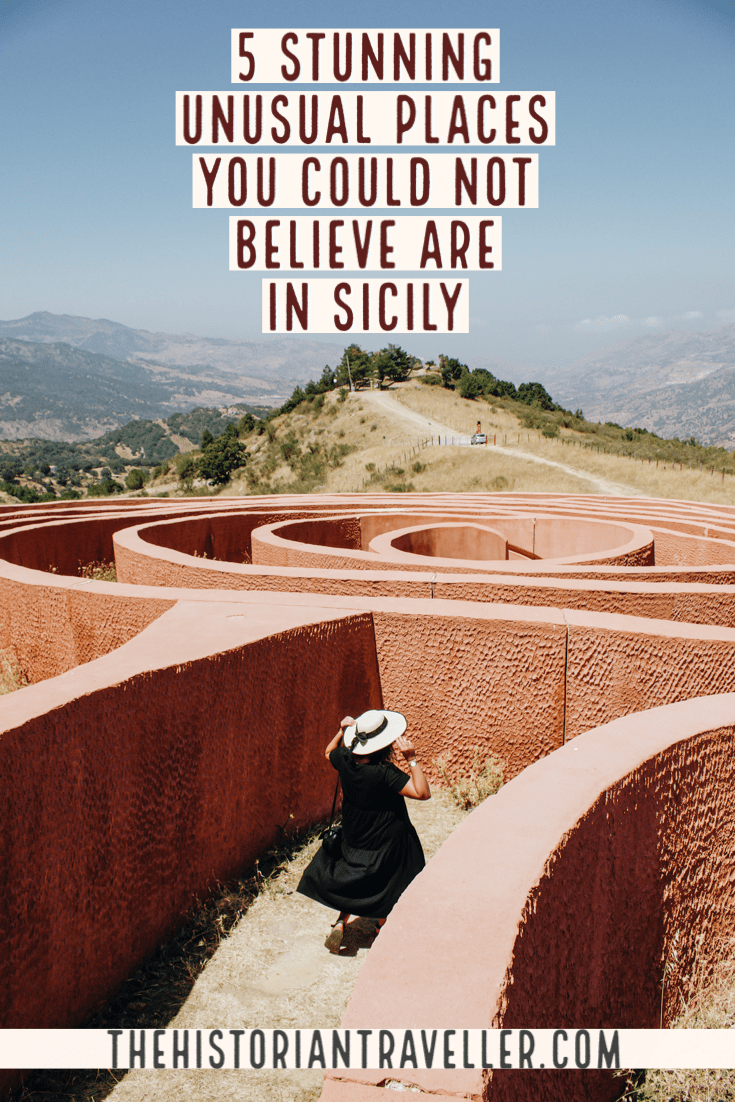
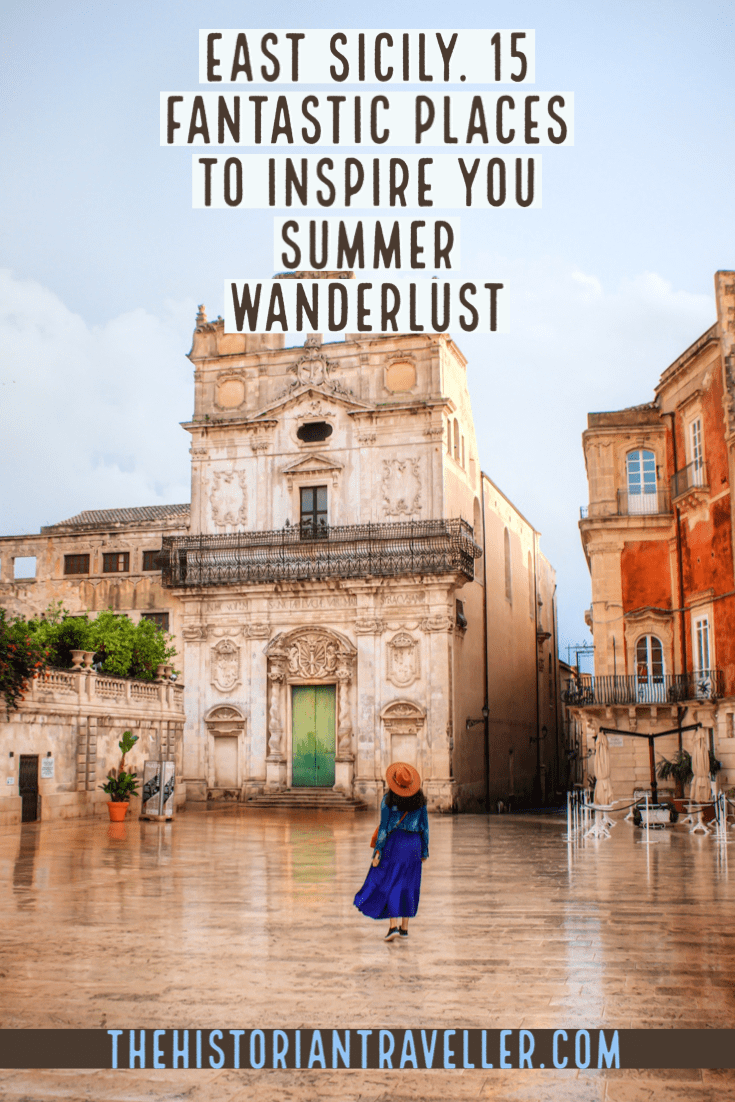
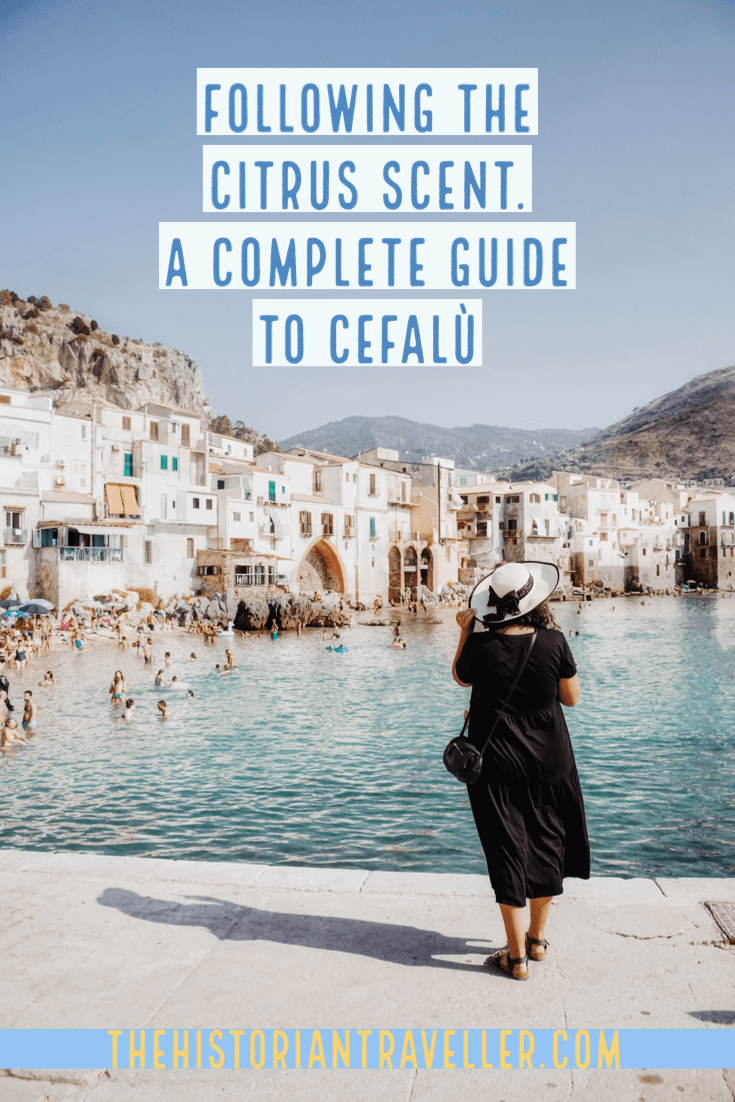
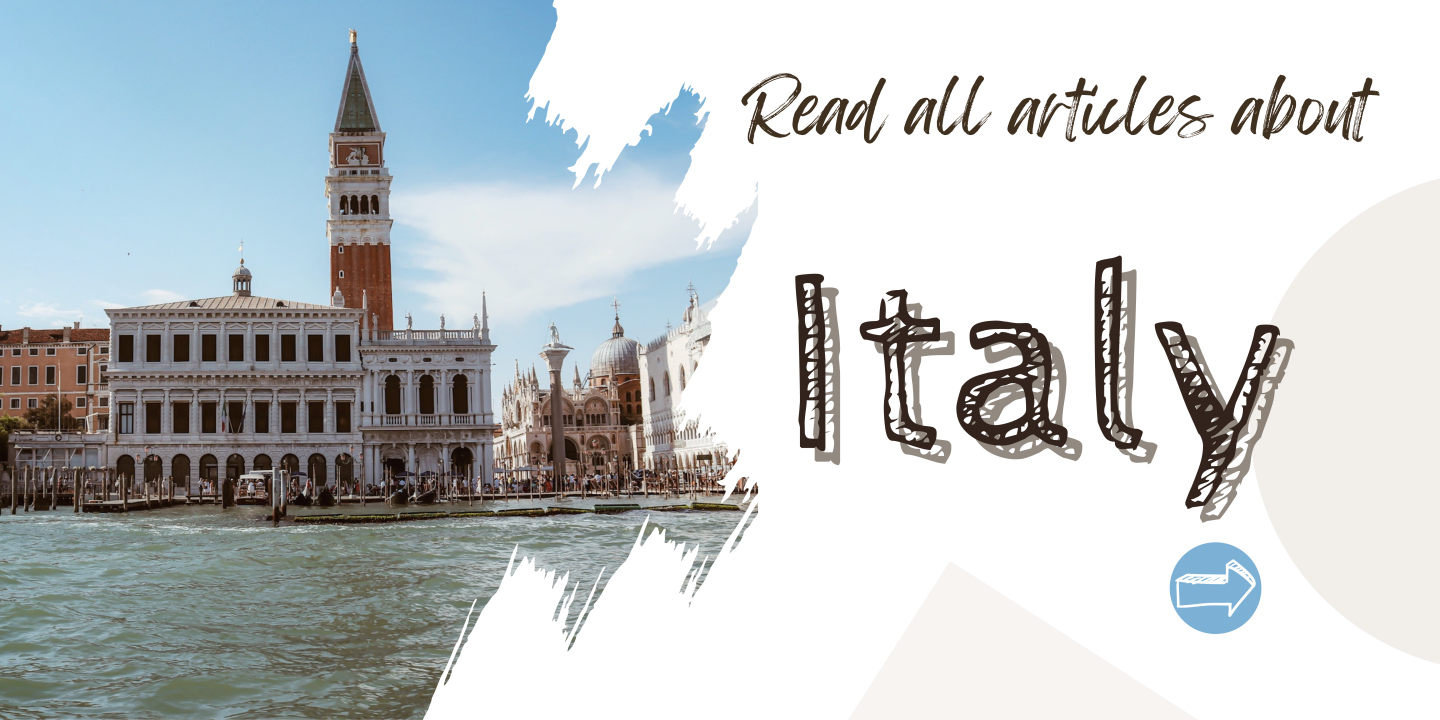
No time to read? Pin it for later!
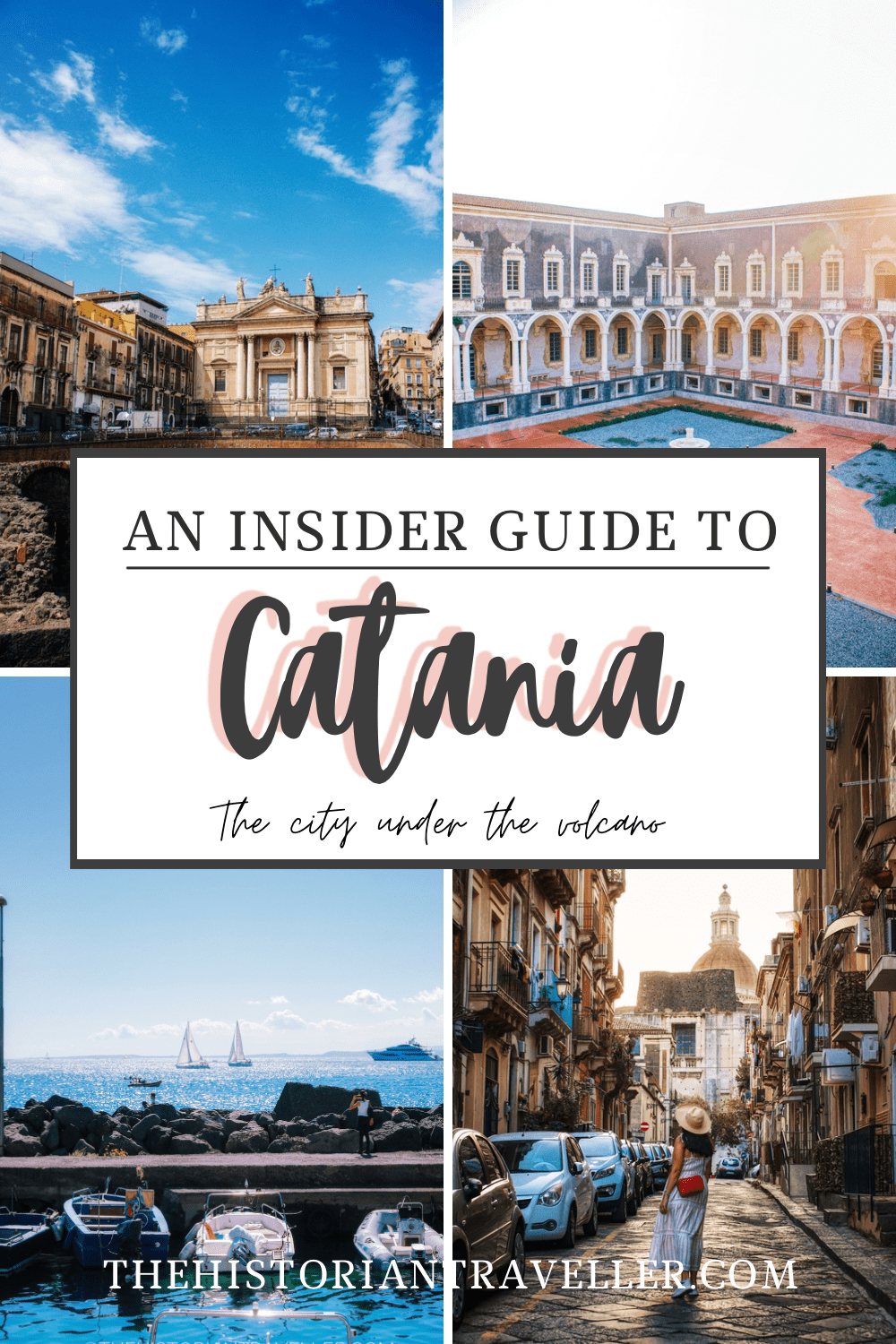
I don’t think I saw the definition of “baby gangs”. What are those?
Author
Groups of teenagers (sometimes even children). They travel in groups of 10/15 kids, sometimes they carry knives or simply target unaware adults trying to rob them or encircling couples to assault women. One of my friends’ father ended up in hospital as a large group ok teens assaulted him on the road 😔. It’s very widespread in Sicily and Catania in particular in no-go areas and sometimes late at night in the city centre.